Inbox and environment news: Issue 580
April 23 - 29 2023: Issue 580
Autumn In Pittwater
Protect Mona Vale's Bongin Bongin Bay - Establish An Aquatic Reserve

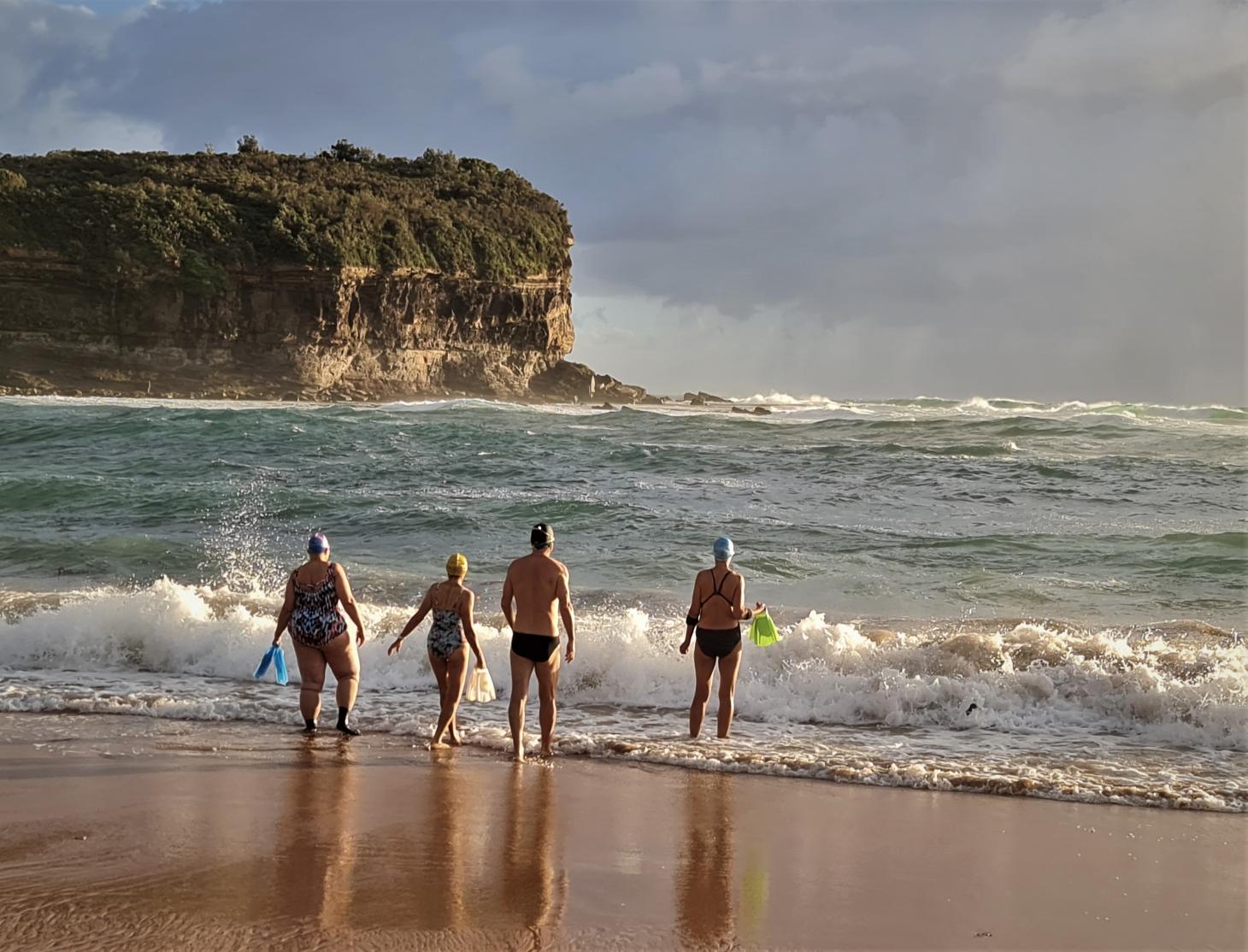
Deep Creek Reserve
April 18, 2023: video by All World Music
Deep Creek Reserve is located along Wakehurst Parkway and is one of the Northern Beaches highest conservation reserves. The reserve contains a small freshwater wetland on the lower section of the reserve which is a form of Sydney Freshwater Wetlands, listed as a Threatened Ecological Community in NSW. This reserve contributes to a regional corridor providing movement for an abundance of native animals including threatened pygmy possums (Cercartetus nanus), powerful owls (Ninox strenua) and heath monitors (Varanus rosengergi).
Sulphur Crested Cockatoo Fledglings Update
The parent bird was feeding the same 2 it has been helping for last few weeks on Tuesday April 18, afternoon - by Wednesday April 19 4pm one has 'flown the nest' and become part of the bigger 'crew' that ranges from Careel Bay to South Avalon Beach and Clareville each day. Just one of the annual stories you get to witness when you keep the trees ;
this one has stayed with parent bird (to right)
the twins
the twins and parent bird
A forgotten and neglected ecosystem covers a third of Earth’s coastlines, with a collective value of $500 billion
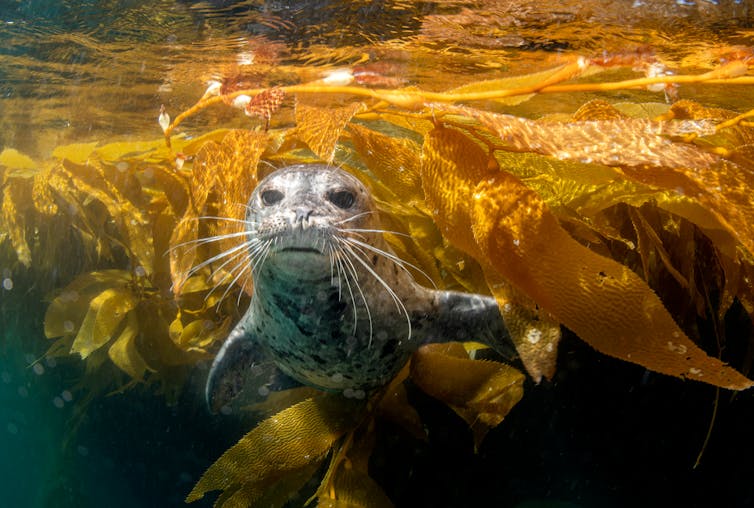
Underwater forests known as kelp have been sustaining people and cultures for millennia. However, most of us are only vaguely aware of the vibrant masses of seaweed hugging the ocean shores around Earth. Furthermore, we don’t realise how valuable and necessary they really are.
In a new study published today in Nature Communications, we have produced the first global estimate of the economic value of kelp forests – revealing they provide hundreds of billions of dollars in value to humans across the world.
A Human History Of Kelp
Along the Pacific, kelp harvest has long played an important role in Asian societies. In Japan, seaweed was among the marine products people could use to pay taxes, according to a law code from the year 701.
In Medieval Europe, kelp was used to fertilise soil and increase crop yields, to treat goitre, and was used to fortify building materials for centuries. In the 21st century kelp forests have become the main source for alginate, a common food and medical additive.
And throughout this time, kelps have supported teeming ecosystems and important fisheries of abalone, lobsters and many different types of fishes. Through their prolific productivity, kelp forests draw carbon from the atmosphere, exude oxygen, and help reduce nutrient pollution in our oceans.
A marine marvel, hidden kelp forests spread across almost one third of our world’s coastlines and lie within 50km of 740 million people. If you live in London, Tokyo, New York, Vancouver, Santiago, Cape Town, Los Angeles or Lisbon, you have one of these ecosystems on your doorstep.
Yet they tend to be forgotten or misunderstood. People often aren’t even aware of a kelp forest, and if they are, they might be most familiar with a pile of decomposing seaweed on the beach after a storm.
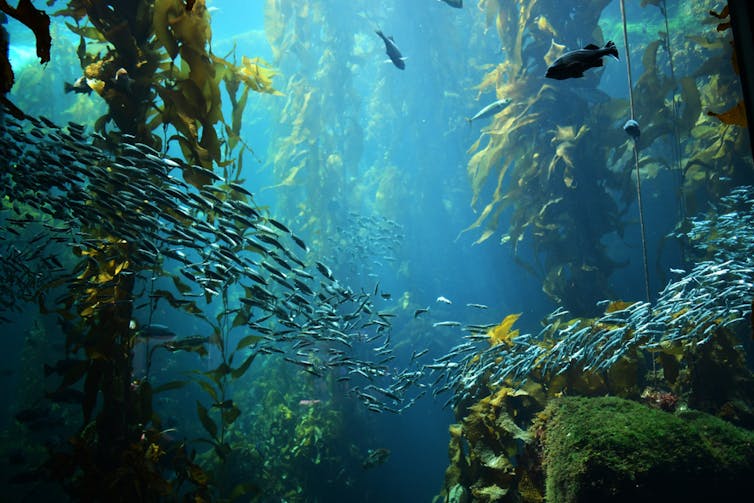
This disconnect has real-world implications. Despite sitting next to some of the biggest research centres on the planet and likely covering more seafloor than any other biotic habitat, research and conservation of kelp forests is terribly behind other ecosystems.
This knowledge gap impedes desperately needed action and conservation. Kelp populations in northern California, Tasmania, and the Salish Sea have all but disappeared in living memory. Elsewhere, kelp populations have been continually declining over the last 50 years.
What we value and how we value it is actually quite a complicated process. And despite the fact we make value judgements over and over each day, we have a really poor understanding of something’s value if it doesn’t have a price tag on it.
Our natural world is perhaps the ultimate value provider – everything we do in our societies is ultimately tied to nature, ecosystems, and a healthy planet. But because these processes and benefits happen with or without humans, they are often taken for granted.

So, What Is The ‘Value’ Of A Kelp Forest?
Our research has brought together data from all across our oceans to produce a global estimate of the economic value of kelp forest ecosystems. Looking at six key genera of kelp – Macrocystis, Nereocystis, Laminaria, Saccharina, Ecklonia, and Lessonia – and the potential economic value of the fisheries they support, the carbon they pull from the atmosphere, and the nutrient pollution they remove from the water, we found that kelp forests are valued at US$500 billion per year.
The highest of these values was the removal of excess nitrogen from the water, which can trigger blooms of algae, reduced water quality, and ultimately oxygen-depleted dead zones.
A close second was the fisheries values – kelp forests support some of our most iconic fisheries, including lobster and abalone.
Lastly, despite finding the carbon sequestration of kelp forests was comparable to other terrestrial and marine ecosystems, the economic value was much lower, as society has yet to place a high price on carbon. This finding suggests that carbon credits may not be an economic driver of kelp conservation, but kelp forests still play an important role in the blue carbon cycle.
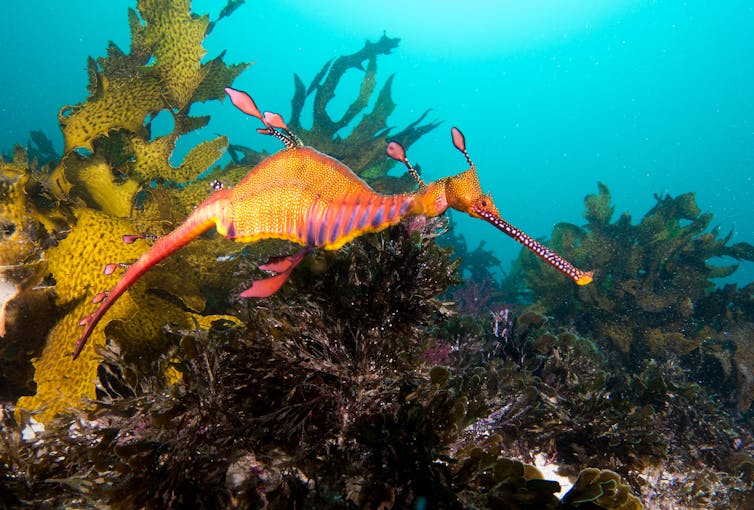
The Future Of Kelp
When nature is treated as a freebie, where we can take what we want and not pay for the damages, this attitude has direct consequences; people and the environment suffer.
First, it can mean that people and government don’t see the value in protecting and restoring ecosystems. Second, development projects are able to destroy nature without compensating for those damages.
Lastly, it leads to poor management. How can we manage something if we cannot quantify it? Imagine if you didn’t know where your bank account was, or how much money was in it.
The battle to save our kelp forests is just getting started, and we need greater action to protect these intrinsically and economically valuable marine ecosystems.
That is why researchers like me have started the not-for-profit Kelp Forest Alliance, and have now launched the Kelp Forest Challenge, a global call to protect and restore 4 million hectares of kelp forest by 2040. This is a call for governments to meet their commitments to the Kunming-Montreal Global Biodiversity Framework and act now to save these ecosystems and #HelpTheKelp.![]()
Aaron Eger, Postdoctoral research fellow, UNSW Sydney
This article is republished from The Conversation under a Creative Commons license. Read the original article.
Swamp Wallaby At Palm Beach
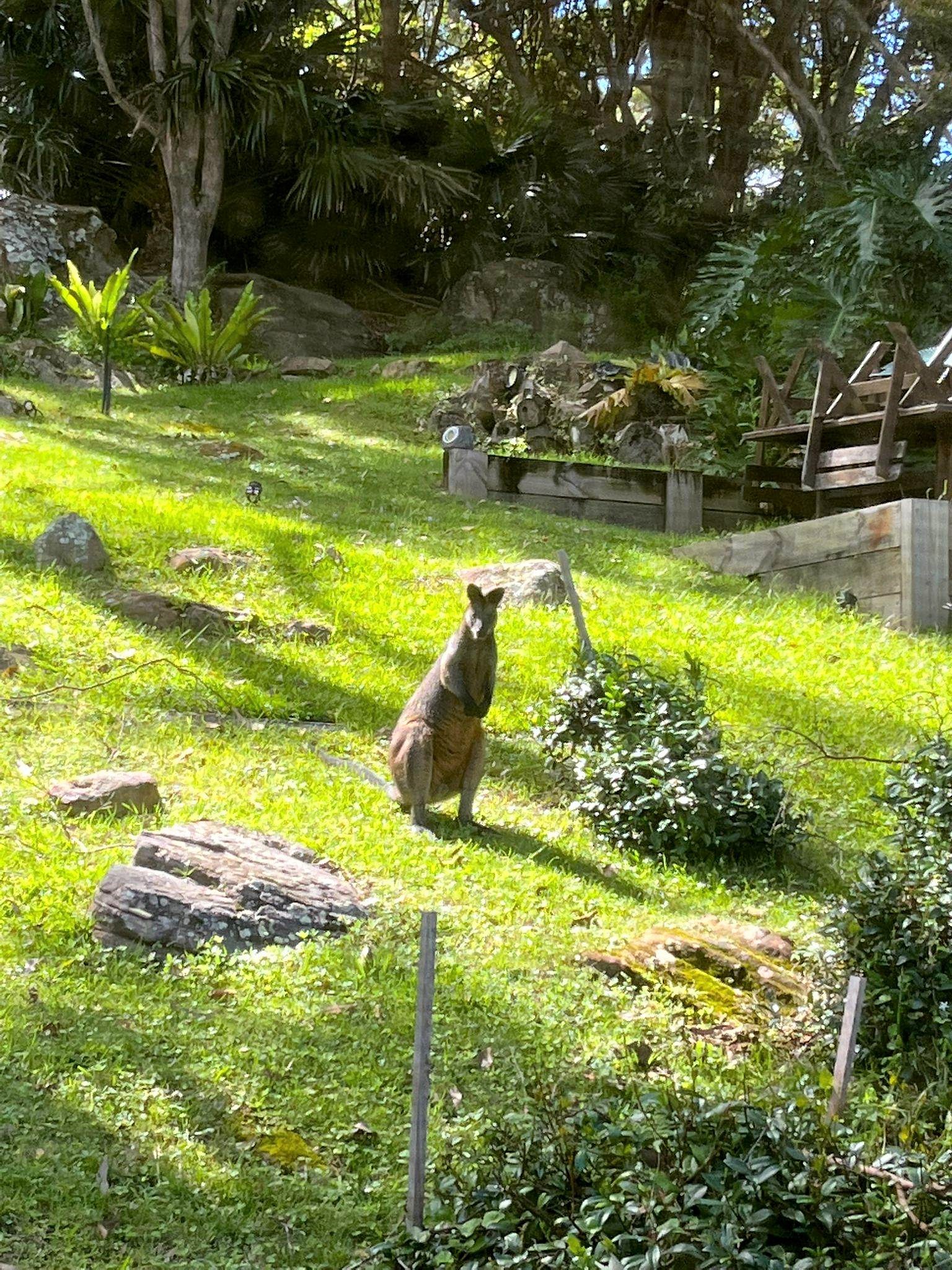
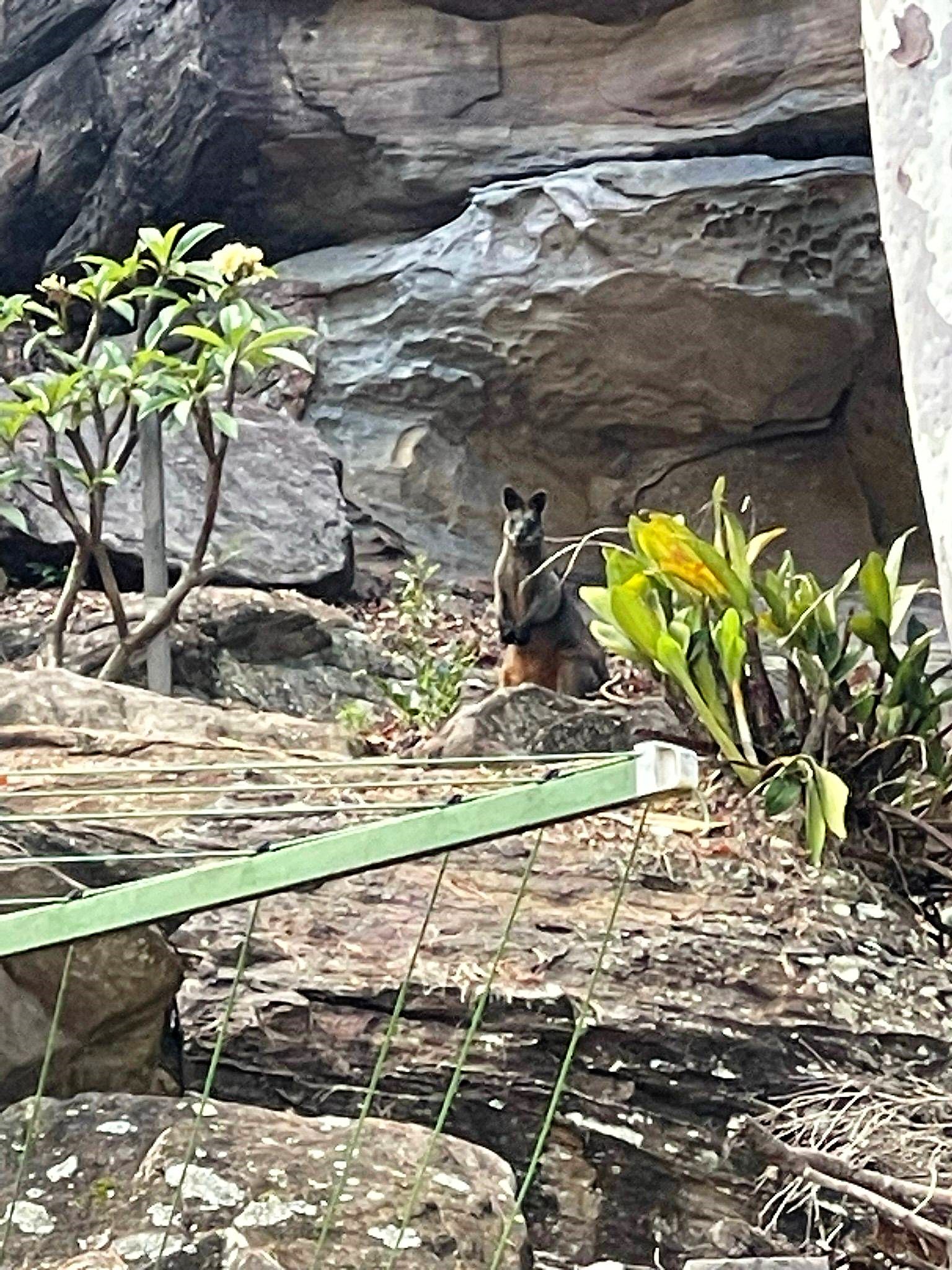
Northern Beaches Clean Up Crew: Avalon Beach April 30
Come and join us for our family friendly April clean up, close to Avalon Surf Lifesaving Club (558 Barrenjoey road, Avalon) on the 30th at 10am.
We have gloves, bags, and buckets, and grabbers. We're trying to remove as much plastic and rubbish as possible before it enters the ocean. Some of us can focus on the bush area and sandy/rocky areas, and others can walk along the beach and even clean up in the water (at own risk). We will clean up until around 11.20, and after that, we will sort and count the rubbish so we can contribute to research by entering it into a marine debris database. The sorting and counting is normally finished around noon, and we'll often go for lunch together at our own expense. We understand if you cannot stay for this part, but are grateful if you can. We appreciate any help we can get, no matter how small or big.
No booking required - just show up on the day. We're a friendly group of people, and everyone is welcome to this family friendly event. It's a nice community - make some new friends and do a good deed for the planet at the same time. For everyone to feel welcome, please leave political and religious messages at home - this includes t-shirts with political campaign messages. There is a council carpark, but it is often busy on Sundays, so check streets close by as well if it's full or please consider using public transport.
Message us on our social media or send us an email if you are lost. All welcome - the more the merrier. Please invite your friends too!
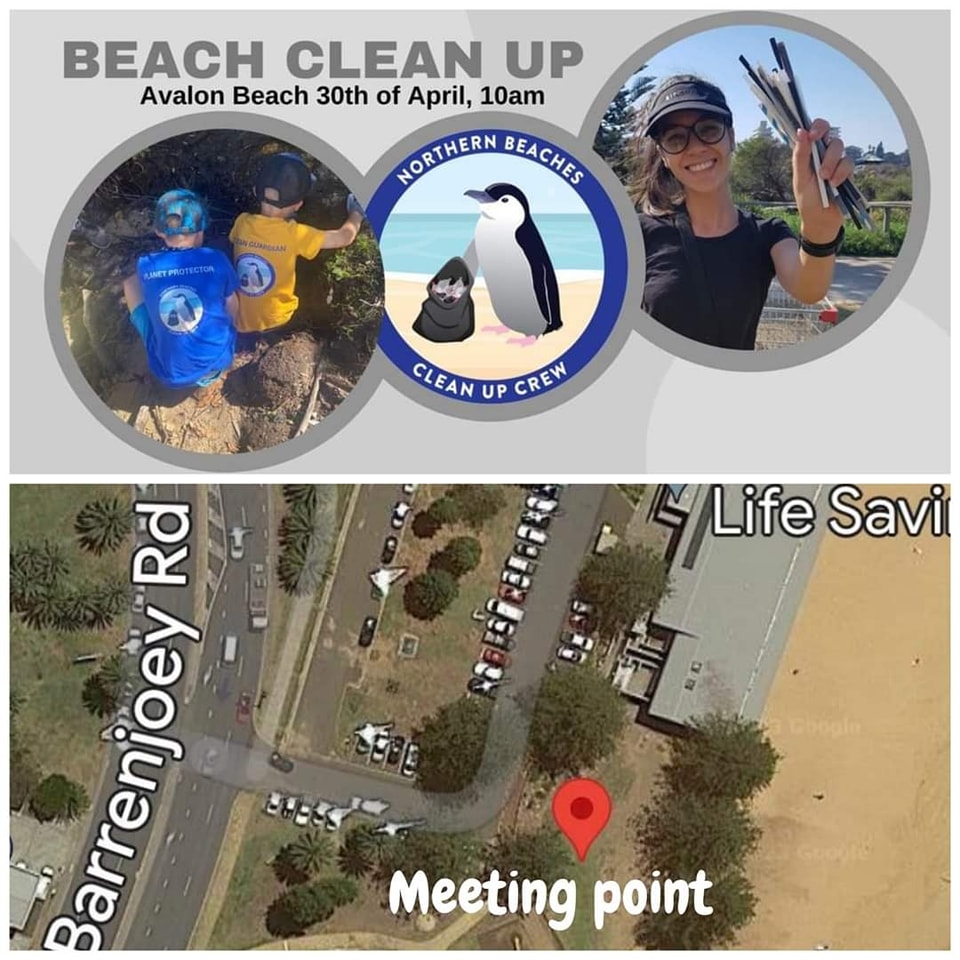
Permaculture Northern Beaches - Upcoming Events
- Learn about Permaculture design
- Caring for and raising chickens
- Native bees and bee hotels
- Living Skills - soap making
- AND Live Music!
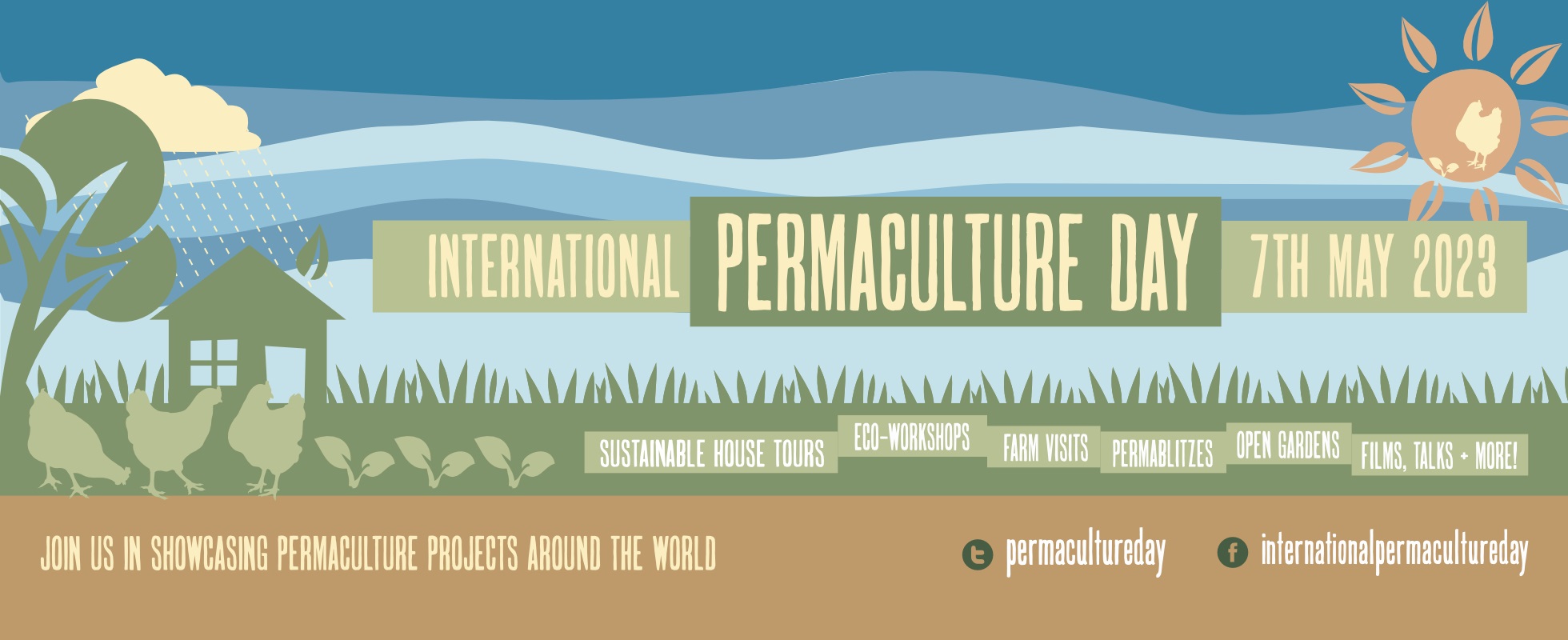
Report Fox Sightings
%20(1).jpg?timestamp=1675893929686)
Weed Of The Season: Cassia - Please Pull Out And Save Our Bush

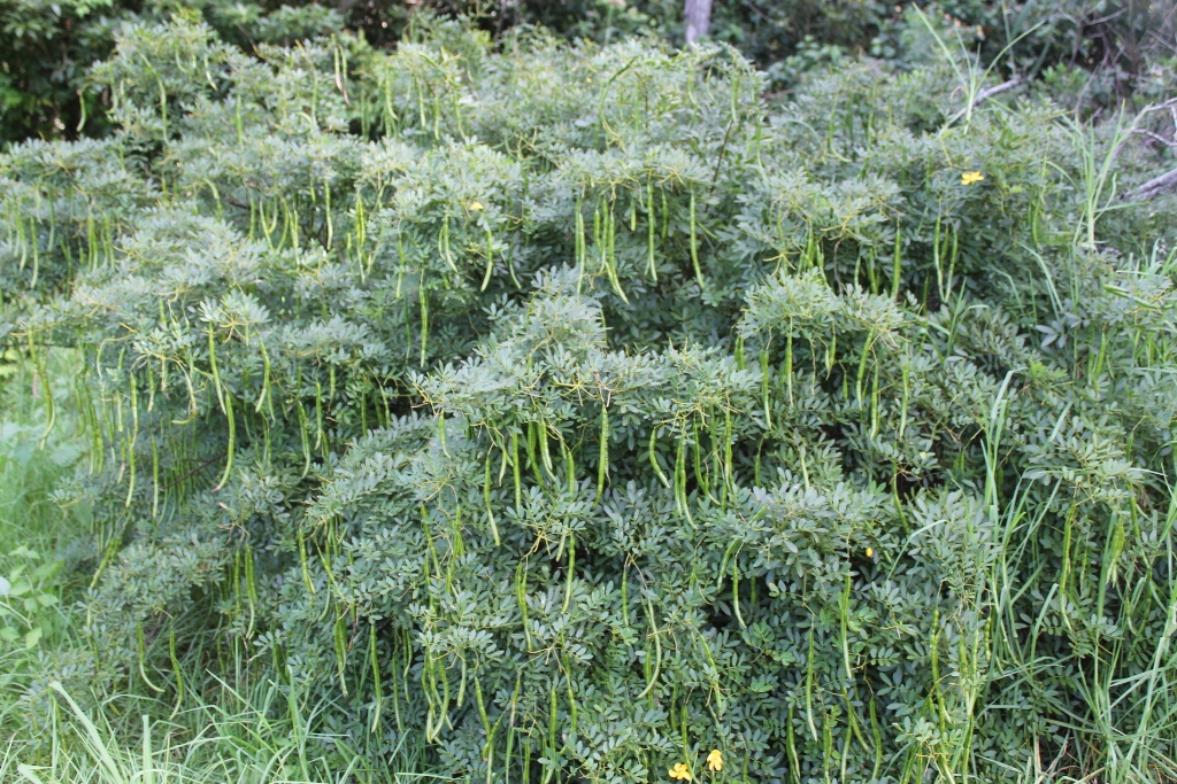
New Marine Wildlife Rescue Group On The Central Coast
A new wildlife group was launched on the Central Coast on Saturday, December 10, 2022.
Marine Wildlife Rescue Central Coast (MWRCC) had its official launch at The Entrance Boat Shed at 10am.
The group comprises current and former members of ASTR, ORRCA, Sea Shepherd, Greenpeace, WIRES and Wildlife ARC, as well as vets, academics, and people from all walks of life.
Well known marine wildlife advocate and activist Cathy Gilmore is spearheading the organisation.
“We believe that it is time the Central Coast looked after its own marine wildlife, and not be under the control or directed by groups that aren’t based locally,” Gilmore said.
“We have the local knowledge and are set up to respond and help injured animals more quickly.
“This also means that donations and money fundraised will go directly into helping our local marine creatures, and not get tied up elsewhere in the state.”
The organisation plans to have rehabilitation facilities and rescue kits placed in strategic locations around the region.
MWRCC will also be in touch with Indigenous groups to learn the traditional importance of the local marine environment and its inhabitants.
“We want to work with these groups and share knowledge between us,” Gilmore said.
“This is an opportunity to help save and protect our local marine wildlife, so if you have passion and commitment, then you are more than welcome to join us.”
Marine Wildlife Rescue Central Coast has a Facebook page where you may contact members. Visit: https://www.facebook.com/profile.php?id=100076317431064
- Ph: 0478 439 965
- Email: marinewildlifecc@gmail.com
- Instagram: marinewildliferescuecc

Watch Out - Shorebirds About
.JPG.opt1460x973o0,0s1460x973.jpg?timestamp=1663629195339)
Possums In Your Roof?: Do The Right Thing

Aviaries + Possum Release Sites Needed

Bushcare In Pittwater
Where we work Which day What time
Avalon
Angophora Reserve 3rd Sunday 8:30 - 11:30am
Avalon Dunes 1st Sunday 8:30 - 11:30am
Avalon Golf Course 2nd Wednesday 3 - 5:30pm
Careel Creek 4th Saturday 8:30 - 11:30am
Toongari Reserve 3rd Saturday 9 - 12noon (8 - 11am in summer)
Bangalley Headland 2nd Sunday 9 to 12noon
Bayview
Winnererremy Bay 4th Sunday 9 to 12noon
Bilgola
North Bilgola Beach 3rd Monday 9 - 12noon
Algona Reserve 1st Saturday 9 - 12noon
Plateau Park 1st Friday 8:30 - 11:30am
Church Point
Browns Bay Reserve 1st Tuesday 9 - 12noon
McCarrs Creek Reserve Contact Bushcare Officer To be confirmed
Clareville
Old Wharf Reserve 3rd Saturday 8 - 11am
Elanora
Kundibah Reserve 4th Sunday 8:30 - 11:30am
Mona Vale
Mona Vale Beach Basin 1st Saturday 8 - 11am
Mona Vale Dunes 2nd Saturday +3rd Thursday 8:30 - 11:30am
Newport
Bungan Beach 4th Sunday 9 - 12noon
Crescent Reserve 3rd Sunday 9 - 12noon
North Newport Beach 4th Saturday 8:30 - 11:30am
Porter Reserve 2nd Saturday 8 - 11am
North Narrabeen
Irrawong Reserve 2nd Saturday 2 - 5pm
Palm Beach
North Palm Beach Dunes 3rd Saturday 9 - 12noon
Scotland Island
Catherine Park 2nd Sunday 10 - 12:30pm
Elizabeth Park 1st Saturday 9 - 12noon
Pathilda Reserve 3rd Saturday 9 - 12noon
Warriewood
Warriewood Wetlands 1st Sunday 8:30 - 11:30am
Whale Beach
Norma Park 1st Friday 9 - 12noon
Western Foreshores
Coopers Point, Elvina Bay 2nd Sunday 10 - 1pm
Rocky Point, Elvina Bay 1st Monday 9 - 12noon
Friends Of Narrabeen Lagoon Catchment Activities

Gardens And Environment Groups And Organisations In Pittwater
Antarctica’s heart of ice has skipped a beat. Time to take our medicine
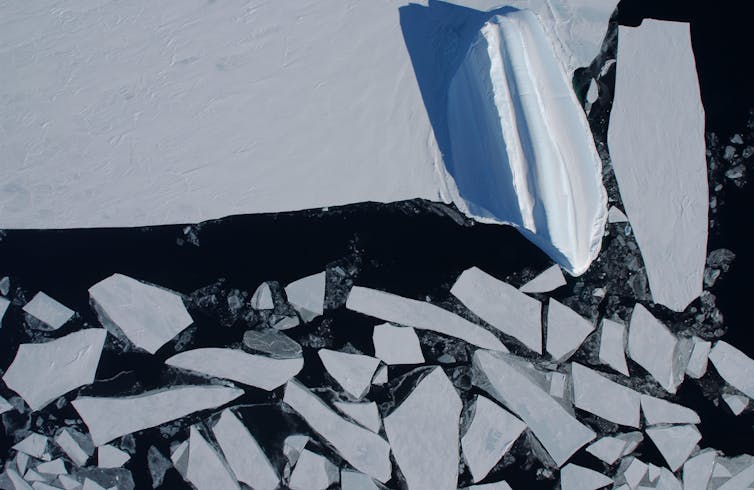
The rhythmic expansion and contraction of Antarctic sea ice is like a heartbeat.
But lately, there’s been a skip in the beat. During each of the last two summers, the ice around Antarctica has retreated farther than ever before.
And just as a change in our heartbeat affects our whole body, a change to sea ice around Antarctica affects the whole world.
Today, researchers at the Australian Antarctic Program Partnership (AAPP) and the Australian Centre for Excellence in Antarctic Science (ACEAS) have joined forces to release a science briefing for policy makers, On Thin Ice.
Together we call for rapid cuts to greenhouse gas emissions, to slow the rate of global heating. We also need to step up research in the field, to get a grip on sea-ice science before it’s too late.
The Shrinking White Cap On Our Blue Planet
One of the largest seasonal cycles on Earth happens in the ocean around Antarctica. During autumn and winter the surface of the ocean freezes as sea ice advances northwards, and then in the spring the ice melts as the sunlight returns.
We’ve been able to measure sea ice from satellites since the late 1970s. In that time we’ve seen a regular cycle of freezing and melting. At the winter maximum, sea ice covers an area more than twice the size of Australia (roughly 20 million square kilometres), and during summer it retreats to cover less than a fifth of that area (about 3 million square km).
In 2022 the summer minimum was less than 2 million square km for the first time since satellite records began. This summer, the minimum was even lower – just 1.7 million square km.
The annual freeze pumps cold salty water down into the deep ocean abyss. The water then flows northwards. About 40% of the global ocean can be traced back to the Antarctic coastline.
By exchanging water between the surface ocean and the abyss, sea ice formation helps to sequester heat and carbon dioxide in the deep ocean. It also helps to bring long-lost nutrients back up to the surface, supporting ocean life around the world.
Not only does sea ice play a crucial role in pumping seawater across the planet, it insulates the ocean underneath. During the long days of the Antarctic summer, sunlight usually hits the bright white surface of the sea ice and is reflected back into space.
This year, there is less sea ice than normal and so the ocean, which is dark by comparison, is absorbing much more solar energy than normal. This will accelerate ocean warming and will likely impede the wintertime growth of sea ice.
Headed For Stormy Seas
The Southern Ocean is a stormy place; the epithets “Roaring Forties” and “Furious Fifties” are well deserved. When there is less ice, the coastline is more exposed to storms. Waves pound on coastlines and ice shelves that are normally sheltered behind a broad expanse of sea ice. This battering can lead to the collapse of ice shelves and an increase in the rate of sea level rise as ice sheets slide off the land into the ocean more rapidly.
Sea ice supports many levels of the food web. When sea ice melts it releases iron, which promotes phytoplankton growth. In the spring we see phytoplankton blooms that follow the retreating sea ice edge. If less ice forms, there will be less iron released in the spring, and less phytoplankton growth.
Krill, the small crustaceans that provide food to whales, seals, and penguins, need sea ice. Many larger species such as penguins and seals rely on sea ice to breed. The impact of changes to the sea ice on these larger animals varies dramatically between species, but they are all intimately tied to the rhythm of ice formation and melt. Changes to the sea-ice heartbeat will disrupt the finely balanced ecosystems of the Southern Ocean.
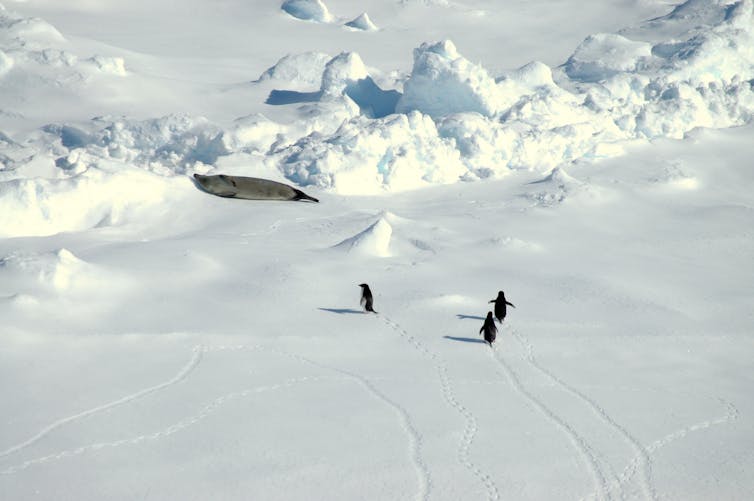
A Diagnosis For Policy Makers
Long term measurements show the subsurface Southern Ocean is getting warmer. This warming is caused by our greenhouse gas emissions. We don’t yet know if this ocean warming directly caused the record lows seen in recent summers, but it is a likely culprit.
As scientists in Australia and around the world work to understand these recent events, new evidence will come to light for a clearer understanding of what is causing the sea ice around Antarctica to melt.
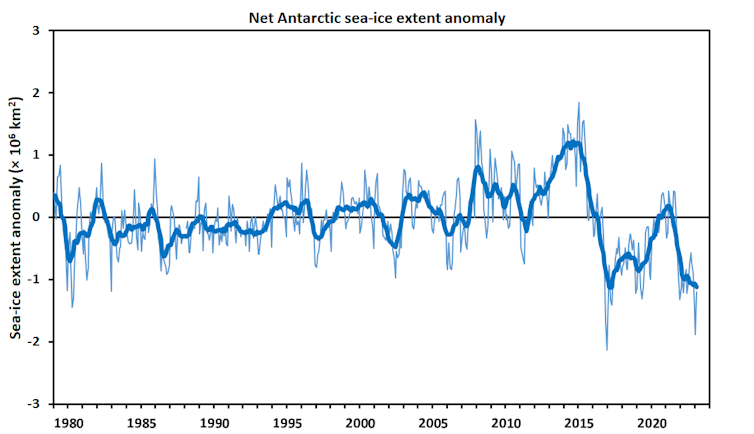
If you noticed a change in your heartbeat, you’d likely see a doctor. Just as doctors run tests and gather information, climate scientists undertake fieldwork, gather observations, and run simulations to better understand the health of our planet.
This crucial work requires specialised icebreakers with sophisticated observational equipment, powerful computers, and high-tech satellites. International cooperation, data sharing, and government support are the only ways to provide the resources required.
After noticing the first signs of heart trouble, a doctor might recommend more exercise or switching to a low-fat diet. Maintaining the health of our planet requires the same sort of intervention – we must rapidly cut our consumption of fossil fuels and improve our scientific capabilities.![]()
Edward Doddridge, Research Associate in Physical Oceanography, University of Tasmania
This article is republished from The Conversation under a Creative Commons license. Read the original article.
Whale-watching guidelines don’t include boat noise. It’s time they did
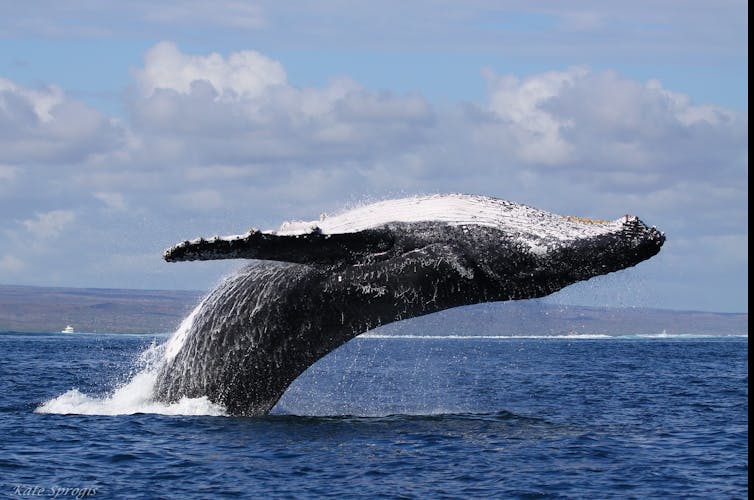
Imagine … eco-tourists enjoying views of undisturbed whales and dolphins, watching them doing what comes naturally.
This is ultimately what we all wish to see when spending time in nature watching animals. We can achieve this by using quieter boats.
But why do we need quieter boats? Whales and dolphins primarily use hearing to sense their surroundings (rather than sight like humans do). Sound travels almost five times faster underwater than it does in the air, so it’s an important sense for whales. They rely on sounds to communicate, navigate, feed and detect predators.
Our new research confirms noise from a boat watching whales at a distance of 300 metres can still disturb them. And watching whales involves a lot of boats and millions of tourists each year. This multi-billion-dollar industry is active in waters off more than 100 countries. The Australian whale-watching industry is one of the biggest in the world.
Because the industry actively seeks out whales and dolphins, using quieter boats should be a priority. Yet current whale-watching guidelines, including Australia’s, do not include noise levels. They should.
As the whale-watching season begins in Australia for humpback whales and southern right whales, we offer tips here for individual operators to reduce noise from their boats.
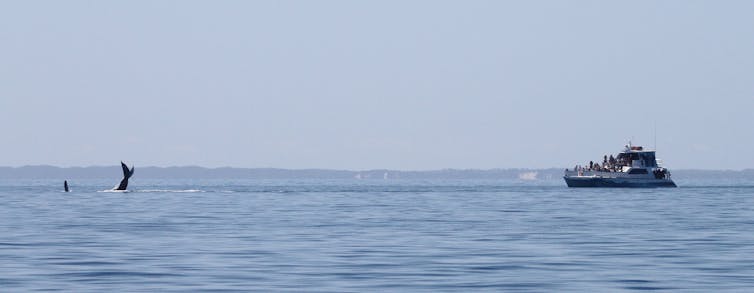
How Does Noise Affect Whales And Dolphins?
Besides income for local communities, whale watching has education and conservation benefits if tourists are inspired to care for the environment.
Despite these benefits, watching whales from a motorised boat and swimming with whales can disturb their natural behaviour. For example, it might prevent them from resting or feeding, or change their breathing, swimming and dive patterns. These impacts are especially important for whales with young.
If the cumulative effects of these short-term impacts are not considered, they can lead to long-term consequences for the animals, such as population declines or leaving an area altogether.
Such outcomes are not only negative for the animals, but also for the whale-watching industry that depends on them.
Whale-Watching Guidelines Overlook Noise Impacts
Many countries have guidelines on the boat’s minimum distance from the animals (typically around 100 metres), the speed at which it passes (typically below wake speed) and the approaching angle (typically from the side-rear). Guidelines, however, do not consider the noise level of the boat’s engine. A very loud boat is, in effect, considered to have the same impact on the animals as a very quiet boat.
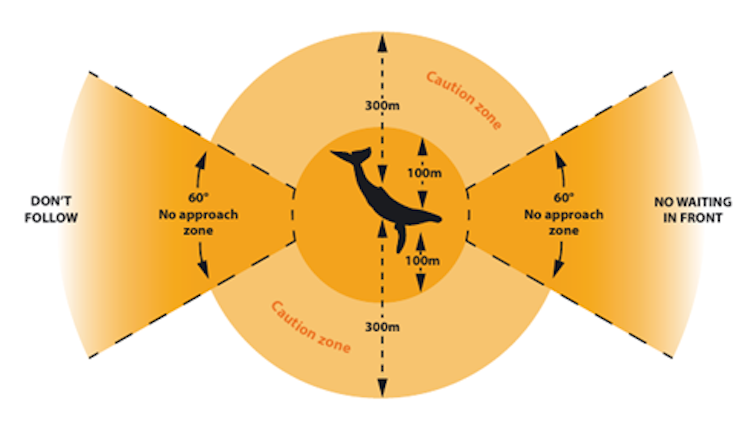
Research confirms louder boat noise disturbs whales more than quiet boat noise. Boats should be as quiet as possible.
We recommend a noise threshold be added to whale-watching regulations, ideally around the volume of the natural underwater background noise. At this level, boat noise is perhaps audible to the whales but with a low perceived loudness. This change to the guidelines will help minimise disturbance to whales and dolphins.
You can see how humpback whales change their behaviour in response to low, medium and high underwater boat noise in this video from our study.
What Do Whale-Watching Boats Sound Like Underwater?
A range of different boats are used for whale watching worldwide. We have calculated the underwater noise level of whale-watching boats operating at low speeds. The quietest boat was a hybrid boat using its electric engines.
The vessel with the quieter electric engines was later used in an experiment with short-finned pilot whales. This study compared the whales’ responses to the boat’s quieter electric engines and its louder petrol engines.
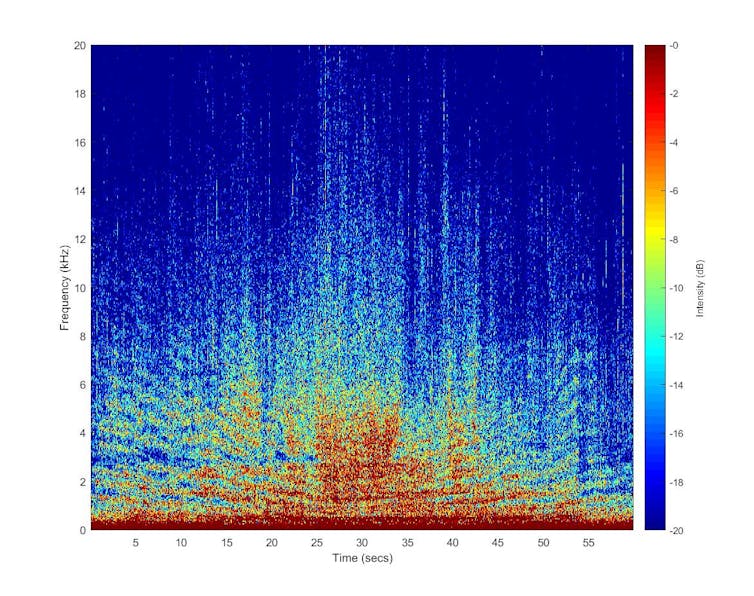
What was the result? The louder engines did indeed disturb the behaviour of short-finned pilot whales compared to the quieter engines. Notably, resting and nursing of young decreased.
Ultimately, some vessels are better designed to minimise noise emissions. You can hear the quieter electric-engined boat in this recording from the study. This makes this boat more appropriate for whale watching.
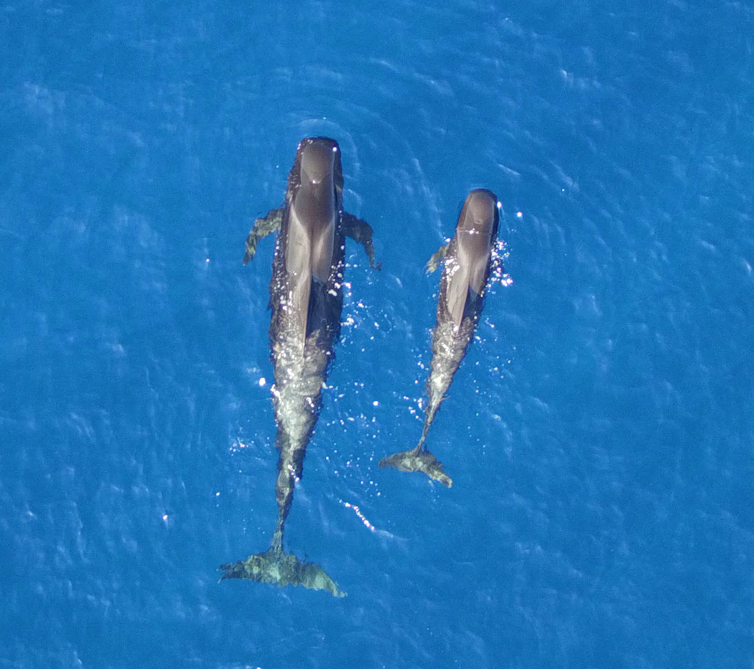
Noise When Arriving And Departing Matters Too
Having a quiet boat will reduce the disturbance to animals. However, even when a whale-watch operator adheres to current best-practice guidelines, there may still be disturbance.
This is because as a vessel increases in speed to leave the whales, it produces higher underwater noise levels. Our research shows this is likely to disturb whales. So we recommend boats maintain a slow speed when approaching and departing whales – say, less than 10 knots within 1km of the whales.
We know it is exciting to zoom off towards a breaching whale, leaving a sleeping whale behind, but the sudden increase in boat speed and noise may then disturb that sleeping whale.
5 Tips To Reduce Boat Noise
On an individual level, boat operators can easily reduce disturbance to whales and dolphins by considering the following five factors.
Speed increases noise from the propeller, so lower the speed, even when arriving/departing.
Distance: the closer a vessel is the greater the peak in noise, so keep to the regulated distance.
Gear shifts cause high-level noise changes, so minimise shifting.
Approach type to the animals can cause disturbance – driving in front of their path, for example, so drive in parallel to their path.
Movements of a boat, such as fast and erratic movements, can disturb animals, so drive consistently.
To further reduce noise, whale-watching companies can use larger, slower-moving propellers (to minimise the water disturbance that creates noise), quieter/electric engines and/or install noise absorption gear.
Both the industry and the whales will benefit from companies using quieter whale-watch boats and approaches.![]()
Kate Sprogis, Adjunct Research Fellow, UWA Oceans Institute, The University of Western Australia; Fredrik Christiansen, Senior Researcher in Marine Biology, Aarhus University, and Patricia Arranz Alonso, Researcher in Marine Biology, Universidad de La Laguna
This article is republished from The Conversation under a Creative Commons license. Read the original article.
Victoria’s plans for engineered wetlands on the Murray are environmentally dubious. Here’s a better option

Governments love the idea of a win-win – even when it doesn’t exist. That’s why Victoria has been spending millions on planning “red gum irrigation ponds” – essentially, engineered wetlands along the River Murray. These wetlands are designed to save some red gum ecosystems, leave many others to decline, and redirect billions of litres of water promised to the environment to farmers.
Controversy has followed these projects. Now, Victoria appears to have blinked, with the state’s water minister, Harriet Shing, halting the development of four of nine projects.
Victory for environmental water? Not quite. Victoria has spent around A$54 million just on planning these projects. By halting four of them, it sets the scene for a larger-scale federal buyback of water for the environment. This could signal a resumption of the Murray-Darling Basin water wars, with Victoria the last holdout. National Irrigators’ Council chair Jeremy Morton predicted “riot” if further water buybacks went ahead.
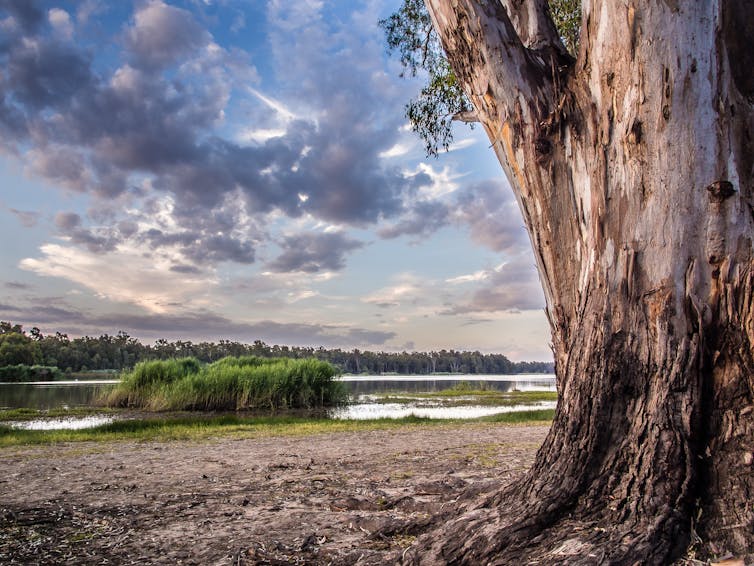
What Was Victoria Trying To Do?
Historically, flooding covered 6.3 million hectares of red gum, black box and coolibah forests, lakes and billabongs in the Murray-Darling Basin. These forests rely on regular floods to survive.
But the basin is also home to most of our thirsty crops, from rice to cotton to orchards. The demand for irrigation alongside the long-term drying trend from climate change means something has had to give. You guessed it: it’s the wetlands, which are drying out and dying.
In 2012, state and federal governments launched the Murray-Darling Basin Plan in a bid to solve longstanding tussles over water. The plan was intended to preserve environmental flows while allocating set volumes of water to farmers.
But it’s not working properly. As our research shows, only 2% of the basin’s wetlands have received managed environmental flows each year since.
To keep wetlands alive with less water, there are two basic options: use pulsed flows from dams to flood a larger area, or build floodplain infrastructure to maintain some wetlands while abandoning others.
Victoria has pursued infrastructure. As originally planned, these projects would have meant building $320 million of dams, pumps, levees and roads in conservation reserves to artificially pond water – while leaving less water in the main river channels. Similar projects were proposed in New South Wales at Menindee Lakes, but these are unlikely to proceed.
These projects are greenwashed as “environmental works”. Victoria brazenly calls its plan a “floodplain restoration project”.
It is not. Since the plan began, irrigators have been credited with 605 billion litres of water for 36 largely unimplemented projects under the sustainable diversion mechanism. In November 2022, basin authority chief Andrew McConville laid out the problem:
The credit has been banked, but the payment still needs to be delivered. The payment is in the form of the [wetland] projects being in operation by 30 June 2024.
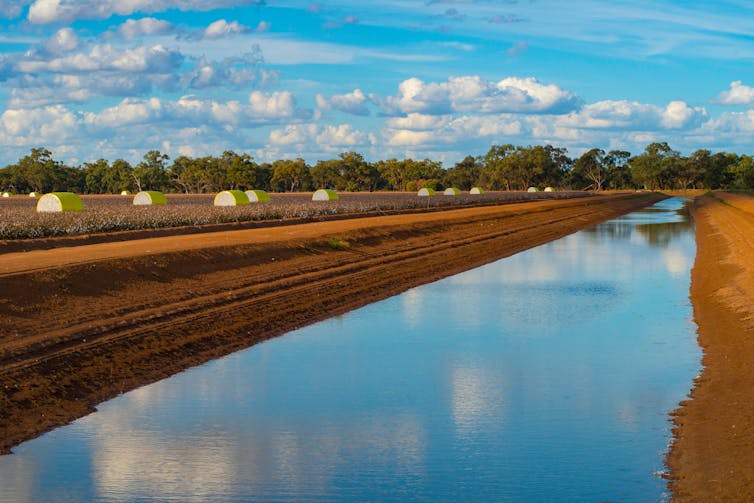
Water has been credited to irrigators before the wetland projects were built. As a result, actual environmental flows are 19% lower than the Basin Plan target of 3,200 billion litres per year.
Building Wetland Infrastructure Is Unprecedented
Around the world, nations are going the other way to Victoria and removing floodplain infrastructure. In China, across Europe and in the United States, efforts are under way to reconnect rivers to their floodplains. Why? To reduce flood impacts (levees intensify floods downstream), improve water quality, restore flood-dependent ecosystems, make river systems more recreation-friendly and diversify local economies.
Only in the Murray-Darling Basin are we seeing governments building infrastructure for environmental water offsetting on such a huge scale.
And just as controversies have dogged Australia’s attempts to offset biodiversity losses and carbon emissions, there are major problems with water offsetting.
The reason for this offsetting is political, not ecological. In 2012, Victoria’s then water minister, Peter Walsh, stated the plan was meant to:
stop irrigation water being stripped from rural communities and food and fibre producers, and to achieve better environmental outcomes.
In fact, these projects are environmentally dubious. Ponding water on floodplains may meet some ecological targets, but it cannot replicate unconstrained natural floods. Worse, it risks harming ecosystems by upending aquatic food webs and leading to lower native fish populations and worse water quality.
Victoria’s very expensive projects would water only 14,000 hectares of wetlands. By contrast, safe flood pulse releases from existing dams would water 27 times that area – 375,000 hectares.
In his royal commission report into how the Murray-Darling water-sharing system works, Commissioner Brett Walker found there was “real doubt” over whether projects like this were based on the best scientific knowledge.
Our research backs his conclusions. We have found flaws in how these projects are evaluated, which mean their environmental benefits are overstated.
What’s Likely To Happen Now?
Four down – but what about the remaining five projects?
There’s a better option. In 2013, the basin’s governments agreed to a strategy that would allow pulsed releases from existing dams to fill river channels and spill onto the floodplains.
Under this strategy, the Commonwealth would pay for roads and bridges to be removed or raised to make way for restoration of natural floods, and for compensation to landowners.
Our research shows this approach would reduce flood damage by moving infrastructure off floodplains, and allow floods to spread out more, lowering water height and speed. It would also water a much larger wetland area at far less cost. But the strategy has not yet been implemented.
Next month, federal and state water ministers will meet to discuss the failing basin plan. If the new NSW water minister, Rose Jackson, backs her federal Labor colleagues, it will leave Victoria as the last state objecting to water purchases for river restoration.
The federal water minister, Tanya Plibersek, shows every indication of implementing Labor’s 2022 election policy of buying back the remaining water needed to meet the 3,200 billion litre environmental restoration target under the plan. (The federal government has bought back around 2,100 billion litres since 2008.)
The stage is set: will Plibersek prevail and finally achieve long-sought environmental restoration goals under the basin plan, or will Victoria hold out?![]()
Jamie Pittock, Professor, Fenner School of Environment & Society, Australian National University and Matthew Colloff, Honorary Senior Lecturer, Australian National University
This article is republished from The Conversation under a Creative Commons license. Read the original article.
Floods of nutrients from fertilisers and wastewater trash our rivers. Could offsetting help?
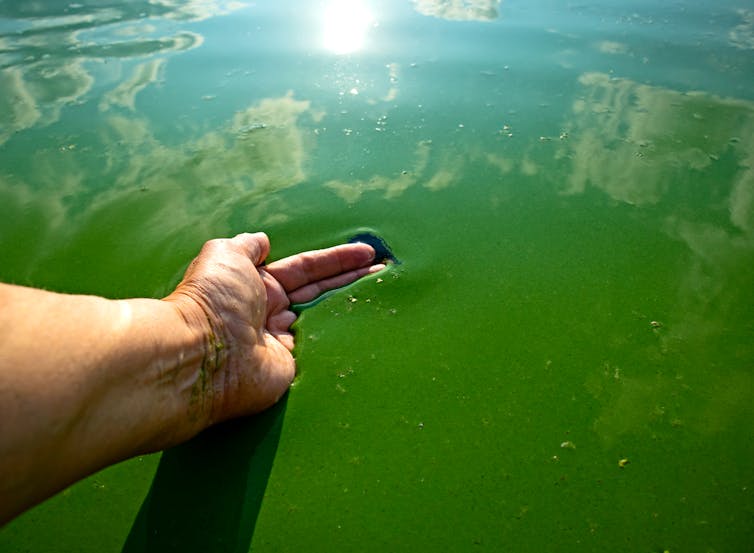
The rivers running through the hearts of Australia’s major cities and towns are often carrying heavy loads of nutrients and sediments.
This is a problem. While nutrients like nitrogen and phosphorus are essential to life in small quantities, in large quantities they become destructive to river and ocean ecosystems.
When rivers are pumped too full of nutrients washing out from farms or from wastewater treatment, bacteria and algae numbers soar. We see the effects in dangerous blue-green algal blooms and in oxygen levels dropping so low that millions of fish can die, as we saw recently in Menindee, New South Wales.
Fixing the problem can be expensive and difficult for landholders. That’s where a new idea could help: nutrient offsetting. Here, large wastewater plants can meet stringent requirements to keep nutrient levels low by fixing eroded riverbanks and gullies upstream, creating wetlands, and preventing fertiliser runoff. The end result: cleaner rivers.
While offsetting schemes for carbon have come under significant scrutiny, nutrient offsetting is a simpler market, with fewer participants and clear ways of measuring success.
Early trials in southeast Queensland by water utilities have proven it can work, as our new report shows.
Why Are Our Rivers Too Full Of Nutrients?
In the early industrial period, rivers around the world were seen as dumping grounds, from factory chemicals to tannery waste. Since then, many countries have worked hard to clean up their waterways, with major successes including the UK’s Thames river.
It’s comparatively easy to stop the dumping of chemicals. You can see the pipes and pinpoint who’s doing it. But nutrient overloading is a harder problem, which is why we’re still wrestling with it.
Our cities and towns are growing. Almost seven million more people live in Australia now compared to the year 2000. As our population grows, we need more food, and we create more human waste. Our agriculture sector has also boomed and is exporting more and more food. To make our famously poor soils fertile requires fertiliser. When too much fertiliser is applied, heavy rains can wash it into rivers. Erosion on riverbanks and in gullies make the problem worse.
Some rivers, estuaries and coastal waters are in real trouble, such as parts of the Murray-Darling, and some urban creeks in our capital cities. We’ve hit their natural limit to handle nutrient loads and gone past it. This can cause algal blooms, fish kills and water too disgusting to drink without expensive treatment.

Why Do We Need Offsetting At All?
Chemical dumping can be solved with laws and enforcement. But while we can fix degraded river catchments to reduce nutrient loads, this is rarely done. That’s because the costs are too high to be borne by any one sector, such as farmers.
By contrast, regulations on nutrients discharged by sewage treatment plants place limits of how much can be released into rivers and estuaries. The costs of further upgrades to sewage treatment plants to reduce nutrients to the required low levels is prohibitively expensive, because ratepayers would end up paying much more for water treatment.
That’s why offsetting can be useful, as it offers a win-win. Urban polluters like wastewater treatment plants can meet their regulatory requirements by restoring eroded and degraded catchment areas upstream to reduce nitrogen and phosphorus flows from farmland. Better, this can be done reasonably cheaply when done at scale. Depending on the available sites, this can be done along rivers and creeks on rural properties, or on council owned land in cities and towns.
Making this viable means using a market. Polluters looking for low-cost ways to comply with regulation of nutrient flows are linked with landholders upstream with degraded land.
This is an emerging solution, but early trials show it has promise. Population-dense south east Queensland has large waterways like the Brisbane and Logan Rivers. Wastewater plant operators such as Logan Water, Urban Utilities and Unity Water have replanted shrubs, grasses and trees along riverbanks, as well as undertaking engineering work to stabilise eroding banks.
This led to significant cost savings. Urban Utilities avoided spending A$8 million in upgrading a sewage treatment plant to cut nutrients and got the same result by spending $800,000 in erosion control and revegetation upriver, which prevented five tonnes of nitrogen entering waterways. Operational costs were also much lower, saving $5 million over ten years.
Controlling erosion keeps nutrients in the soil to help crops and grasses to grow, benefiting farmers, rather than having it washed downstream. Healthier riverbanks create better habitat for birds, reptiles and mammals and makes rivers healthier for fish and other species.
What’s Next?
Nutrient offsetting is still new in Australia. For it to gain traction across Australia means working to make sure the systems and science are mature.
To maximise benefits and give participants certainty, we’ll need to shift from a piecemeal trial approach to a coordinated trading scheme. Successful overseas examples typically have a third party coordinating buying and selling, and ensure there’s a robust structure to set up and assess these projects.
Canada has seen successes here, such as the South Nation River trading program which has reduced phosphorus in the river, while America has examples such as the nutrient credit trading program in Chesapeake Bay. In Australia, a voluntary reef trading scheme is underway in the catchments of rivers flowing into the waters of the Great Barrier Reef, involving farmers and a range of investors.
To make sure this works, we need detailed scientific knowledge on comparing nutrient pollution from different sources. Catchment runoff nutrients are mostly bound to soil particles, while sewage treatment plants have much more dissolved nutrients. As yet we don’t know how these sources differ.
We also need to know what methods of land management are best suited to stopping nutrients from washing into rivers, to ensure the best outcome for the money spent.
Creative Solutions Are Necessary
Despite our efforts in cleaning up many of our rivers, traditional approaches haven’t been enough to stop nutrient pollution. It’s time to explore creative new approaches to make our rivers and reefs healthier.![]()
Michele Burford, Professor - Australian Rivers Institute, and Dean - Research Infrastructure, Griffith University
This article is republished from The Conversation under a Creative Commons license. Read the original article.
Plastic action or distraction? As climate change bears down, calls to reduce plastic pollution are not wasted
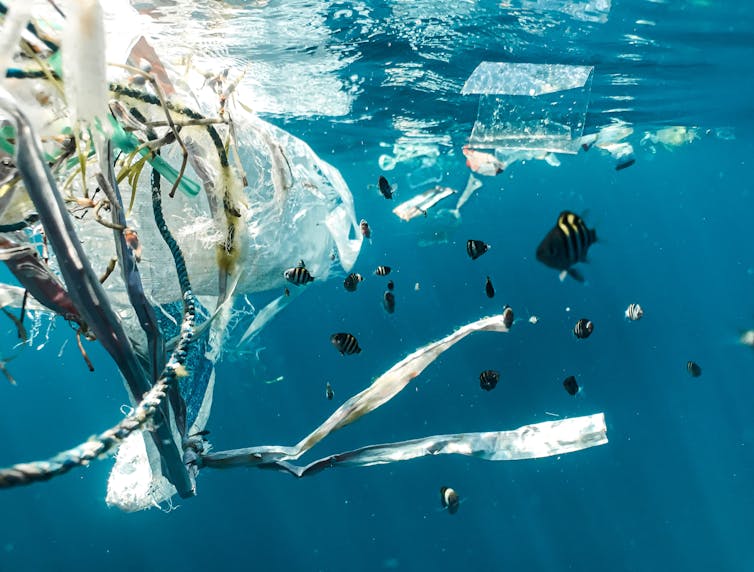
Climate change, pollution and overfishing are just a few problems that need addressing to maintain a healthy blue planet. Everyone must get involved – but it’s easy to feel overwhelmed and unsure where to start.
Of course we can start with the obvious - making sure we reduce, reuse and recycle. Yet, given the scale of the challenge, these small, relatively simple steps are not enough. So, how can we encourage people to do more?
There is controversy about the best approach. Some argue focusing on easy actions is distracting and can lead people to overestimate their positive impact, reducing the chance they will do more.
However, our new research found promoting small and relatively easy actions, such as reducing plastic use, can be a useful entry point for engaging in other, potentially more effective actions around climate change.
The Plastic Distraction Debate
Marine plastic pollution is set to quadruple by 2050 and efforts to reduce this have received a lot of attention. In this arena, Australia is making significant progress.
For example, last year scientists discovered the amount of plastic litter found on Australian coasts had reduced by 30% since 2012-13. Seven out of eight Australian states and territories have also committed to ban single-use plastics.
Yet, some scientists are concerned all this fuss about plastic distracts us from addressing the more pressing issue of climate change, which is degrading marine ecosystems at an alarming rate and making oceans hotter than ever before.
For example, without an urgent reduction in greenhouse gas emissions, coral reefs could lose more than 90% coral cover within the next decade. This includes our very own Great Barrier Reef.
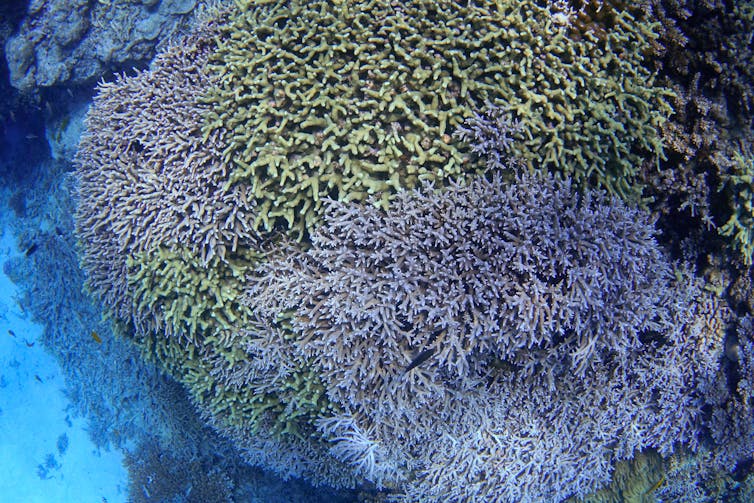
When it comes to climate action, Australia is behind. Many Australians are also unsure which actions to take. For example, a 2020 study asked more than 4,000 Australians what actions were needed to help the Great Barrier Reef. The most common response (25.6%) involved reducing plastic pollution. Only 4.1% of people mentioned a specific action to mitigate climate change.
‘Spillover’ Behaviour
We ran an experiment to test whether we could shift this preference for action on plastic into action on climate change.
Our experiment was based on a theory known as “behavioural spillover”. This theory assumes the actions we take in the present influence the actions we take in future.
For example, deciding to go to the gym in the morning may influence what you decide to eat in the afternoon.
Some experts argue focusing on reducing plastic use – a relatively simple action – can help build momentum and open the door for other environmental actions in the future. This is known as positive spillover.
Conversely, those in the “plastic distraction” camp argue if people reduce their plastic use, they might feel they have done enough and become less likely to engage in additional actions. This is known as negative spillover.
Experimenting With Spillover From Plastic To Climate
To test whether we could encourage spillover behaviour in the context of the Great Barrier Reef, we conducted an online experiment with representative sample of 581 Australians.
Participants were randomly allocated to one of three experimental groups or a control group. The first group received information about plastic pollution on the reef along with prompts to remind them of their efforts to tackle the problem in the past week (a “behaviour primer”). The second group received the reef plastic information only. The third group received information about the reef and climate change. The control group received general information about World Heritage sites, with no call to action or mention of the Great Barrier Reef.
Participants were then asked whether they would be likely to take a range of climate actions, such as reducing personal greenhouse gas emissions and talking to others about climate change. They also had the opportunity to “click” on a few actions embedded within the survey such as signing an online petition for climate action.
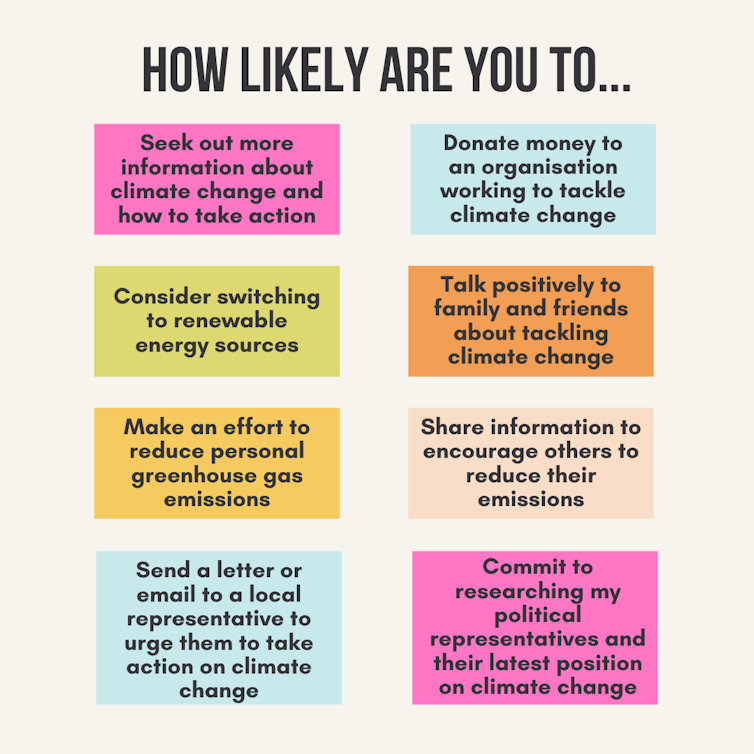
Compared to the control group, those provided with information about plastic pollution were more willing to engage with climate actions, particularly when they were reminded of positive past behaviours. Whereas those provided with information about climate change showed no significant difference.
Plastic messages also had a stronger positive effect on climate action for those who were politically conservative, compared to those more politically progressive.
But the approach didn’t work for everyone. We repeated the experiment with 572 self-identified ocean advocates, many of whom already engaged with marine conservation issues. For this audience, talking about plastic and their past efforts made them less likely to engage with climate action compared to the control group.
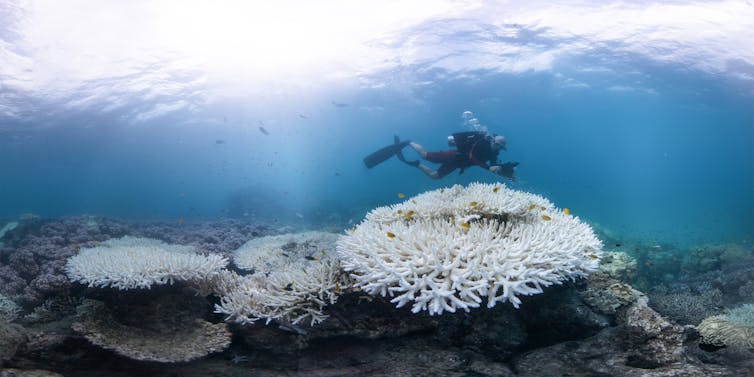
So What Does All This Mean?
Our results suggest it’s possible to motivate climate action for the reef without slipping back into conversations about plastic. Here are four ways to help achieve this:
Remind people of the small actions they already take: reminding people of their positive contributions and making them feel like they are capable of doing more can open the gateway to further action.
Connect the dots between plastic and climate: plastics are primarily derived from fossil fuels and production alone accounts for billions of tonnes of greenhouse gas emissions each year. Making it clear that a fight against fossil fuels is a fight against both plastic and climate can help guide people towards those extra climate actions.
Provide clear calls to (climate) action: research shows most people are unable to identify climate actions on their own. As a result, they tend to get stuck on common behaviours such as recycling. Giving people clear advice on how they can contribute to mitigating climate change is crucial.
Know your audience: spillover from plastic to climate is more likely in a general audience. If your network is full of ocean advocates, it might be better to skip the plastic conversation and dive straight into conversations about climate change actions.
It’s important to remember that people’s first steps don’t have to be their only steps. Sometimes, they just need a little guidance for the journey ahead.![]()
Yolanda Lee Waters, PhD Candidate and Research Assistant, The University of Queensland and Angela Dean, Lecturer, School of Agriculture and Food Science & Centre for Biodiversity and Conservation Science, The University of Queensland
This article is republished from The Conversation under a Creative Commons license. Read the original article.
We need a National Energy Transition Authority to help fossil fuel workers adjust
Fergus Green, UCLAustralia’s coal-fired power stations are exiting the grid. This transition is already well underway, as cheaper renewables displace coal and older generators close. Australia’s oldest coal plant, Liddell, is about to close. Eleven coal-fired power plants closed between 2013 and 2020, and at least seven others are slated to close between now and 2030.
Closing a power station sounds bloodless. But if it’s not done well, it can be devastating for affected workers and their families, and economically and socially disruptive to the communities in which they are based. Many towns grew up around coal mines and power plants. We cannot simply leave it to the market to smooth the transition.
To better manage the vital human part of our transition to a low-carbon electricity system, the Australian Council of Trade Unions (ACTU) recently proposed a solution. It called on the federal government to establish an independent National Energy Transition Authority.
This is an excellent idea, and well overdue given the rate at which our coal plants are closing. Countries that have embraced this approach, such as Spain, have seen the benefits, economic, social – and even political.
What Would This Authority Do?
An energy transition authority, as envisaged by the ACTU, would have three main functions:
develop schemes to support affected workers, including through redeployment into similar facilities, or retraining and recruitment into sustainable industries
support, coordinate and partly finance plans to develop new industries in coal-dependent regions such as Gippsland in Victoria and the Hunter Valley in New South Wales, including attracting federal and state investment and incentives to drive investment in local sustainable industries
ensure education and training programs and infrastructure are in place to support industrial diversification in these regions.
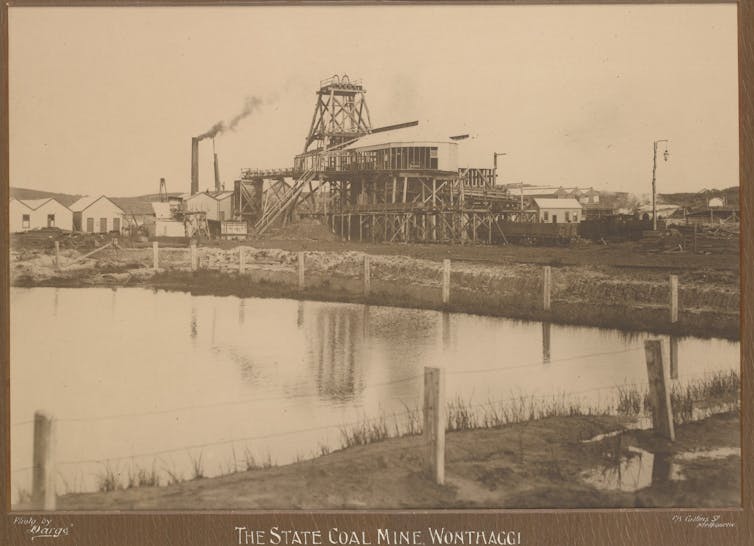
Do We Actually Need A New Authority?
This isn’t the first time we’ve seen proposals for authorities like this. The union movement has proposed several variants in the past, and Labor backed a similar initiative before the 2022 federal election.
After it won government, Labor set up a net zero economy taskforce aimed at advising on how to best support regional communities during the low-carbon transition.
The Greens have also proposed an expanded version of this authority, which would take on extra advisory and law-reform functions. An inquiry into the Greens’ proposed bill by a Labor-majority committee last month described the measure as “premature”, given the government’s taskforce is exploring options to help regions.
Labor, of course, would prefer its own version gets up. That’s entirely possible – the proposed authority has broad support beyond the labour movement.
But some have been critical, with Australian Energy Council experts questioning whether such an authority would be needed, given regional development programs already exist.
Regional industrial transitions are complex, requiring sustained governance over long periods. Australia’s existing programs are not enough, and are often fragmented across a patchwork of federal, state and local government departments.
A new federal authority would help coordinate existing programs across all levels of government, bring the additional capabilities of the federal government, and take a sustained, long-term focus to the challenging task of regional transition.
In a few weeks, we’ll find out whether the Albanese government decides to fund such a body in its May budget.
The Moral Case For A Transition Authority
An authority dedicated to smoothing the path of the energy transition is, in my view, justified on moral grounds. It would elevate the voices of workers and regional communities who are most affected by the low-carbon transition, helping to ensure the benefits and burdens of the transition are fairly shared.
Those whose jobs are at risk have a moral claim to government support to help them adjust to these changes. But so do residents in these regions who never enjoyed the benefits of highly paid unionised jobs in the fossil fuel industry in the first place. They, too, should share in the benefits.
That’s why the ACTU is right to propose a wider, community-level mandate for the authority, to spur regional development that’s not only more environmentally sustainable but also more socially diverse.

The Political Case
Residents of coal and gas regions are often sceptical of the low-carbon transition, and may view it as a threat. An authority like this could build local support by demonstrating what comes next.
In Spain, for instance, the incumbent Spanish Socialist Party is reaping the political benefits of the “just transition agreement” it negotiated with unions, employers and community representatives in coal regions in 2018.
This agreement made clear coal-mining would be phased out by the end of 2019. In return, the government agreed to provide €250 million (A$407 million) in support for workers and community-level investment over the next eight years.
At the April 2019 national election, the incumbents won. Interestingly, our research found their vote share in coal-mining regions covered by the agreement increased relative to comparable rural areas not covered.
Spain and Australia obviously have different political contexts. But our research does suggest there are potential political benefits – not just costs – on offer to governments that provide climate leadership grounded in a just-transition strategy.
An Australian transition authority will only be politically successful if it works with local bodies with similar mandates, such as the Latrobe Valley Authority and the Collie Delivery Unit – or helps establish them.
Working with locally supported groups is common sense. It is also backed up by research showing that fossil fuel communities do not like the idea of having their futures dictated to them by Canberra. But if they feel heard and see their concerns tackled in the transition, they are more likely to be supportive.
For years, organisations such as The Next Economy and the Real Deal project have been working on the energy transition in communities like Gladstone, one of the Queensland towns most reliant on gas and coal. This community-building expertise would be vital for the authority to draw on.
From The Power Stations To The Mines?
If Australia creates an energy transition authority, the immediate task is to help catalyse just and politically smooth transitions in coal power-generating regions.
But there’s a bigger task lying ahead. Australia’s domestic emissions are dwarfed by the emissions from its coal and gas exports. If the authority proves itself, it could begin to support workers and communities to wind down Australia’s export-oriented coal mines and fossil-gas production industries.![]()
Fergus Green, Lecturer in Political Theory and Public Policy, UCL
This article is republished from The Conversation under a Creative Commons license. Read the original article.
El Niño is coming, and ocean temps are already at record highs – that can spell disaster for fish and corals
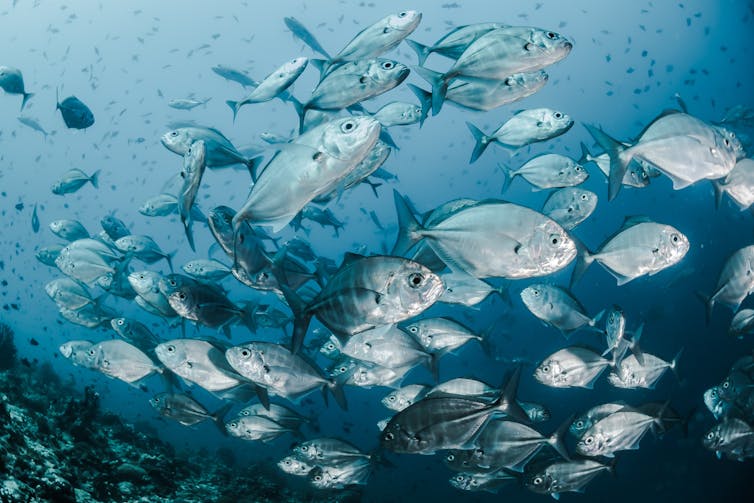
It’s coming. Winds are weakening along the equatorial Pacific Ocean. Heat is building beneath the ocean surface. By July, most forecast models agree that the climate system’s biggest player – El Niño – will return for the first time in nearly four years.
El Niño is one side of the climatic coin called the El Niño-Southern Oscillation, or ENSO. It’s the heads to La Niña’s tails.
During El Niño, a swath of ocean stretching 6,000 miles (about 10,000 kilometers) westward off the coast of Ecuador warms for months on end, typically by 2 to 4 degrees Fahrenheit (about 1 to 2 degrees Celsius). A few degrees may not seem like much, but in that part of the world, it’s more than enough to completely reorganize wind, rainfall and temperature patterns all over the planet.
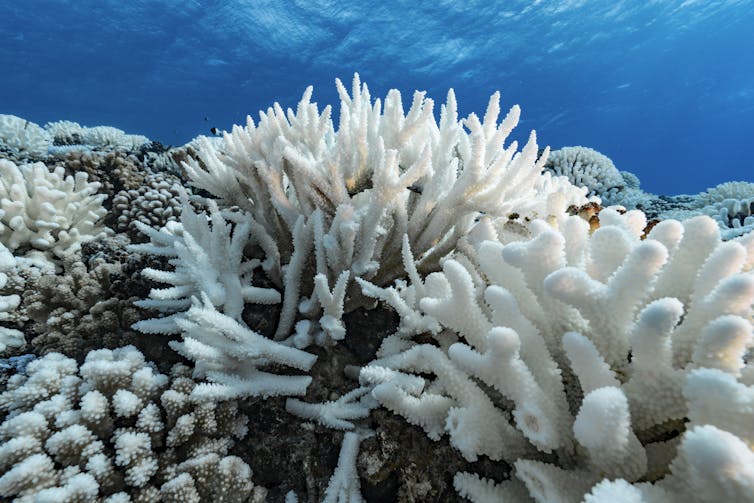
I’m a climate scientist who studies the oceans. After three years of La Niña, it’s time to start preparing for what El Niño may have in store.
How El Niño Affects The Planet
No two El Niño events are exactly alike, though we’ve seen enough of them that forecasters have a pretty good idea of what’s likely to happen.
People tend to focus on El Niño’s impact on land, justifiably. The warm water affects air currents that leave areas wetter or drier than usual. It can ramp up storms in some areas, like the southern U.S., while tending to tamp down Atlantic hurricane activity.
El Niño can also wreak havoc on the many marine ecosystems that support the world’s fishing industries, including coral reefs and seagrass meadows.
Specifically, El Niño tends to trigger intense and widespread periods of extreme ocean warming known as marine heat waves.
Global ocean temperatures are already at record highs, so El Niño-induced marine heat waves could push many sensitive fisheries to a breaking point.
The Problem With Marine Heat Waves
A marine heat wave is just that: a “wave” of extreme heat in the ocean, not dissimilar to an atmospheric heat wave on land.
At their smallest, marine heat waves can inundate local bays and coves with hotter-than-normal water for a few days or weeks. At their largest, marine heat waves like the Northeast Pacific Warm Blob of 2013-2014 can grow to gargantuan proportions, with regions three times the size of Texas experiencing ocean temperatures 4 to 6 F (about 2 to 3 C) above average for months or even years.
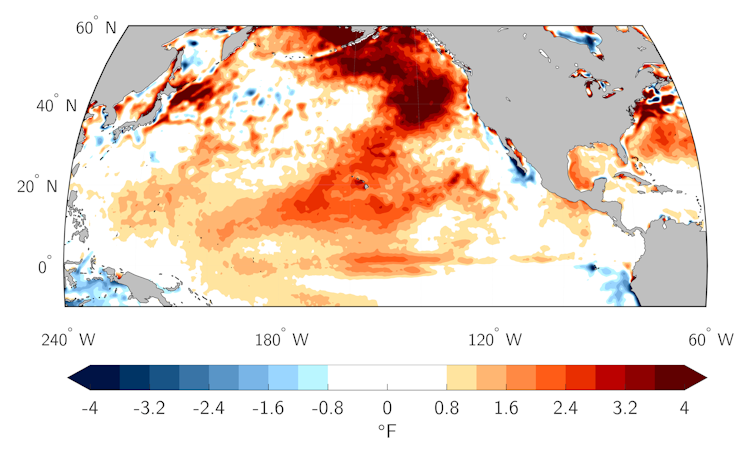
Warm water might not seem like a big deal, especially to surfers hoping to leave their wetsuits at home. But for many marine organisms that are highly adapted to specific water temperatures, marine heat waves can make living in the ocean feel like running a marathon.
For example, some fish increase their metabolism in warm waters by so much that they burn energy faster than they can eat, and they can die. Pacific cod declined by 70% in the Gulf of Alaska in response to a marine heat wave. Other impacts include bleached corals, widespread harmful algal blooms, decimated seaweeds and increased marine mammal strandings. All told, billions of U.S. dollars are lost to marine heat waves each year.
Marine heat waves flare up for a variety of reasons. Sometimes ocean currents shift warm water around. Sometimes surface winds are weaker than normal, leading to less evaporation over the ocean and warmer waters. Sometimes cloudy places just aren’t as cloudy for a few months, which lets more sunlight in and heats up the ocean. Sometimes both weaker winds and fewer clouds happen at the same time, producing record-breaking marine heat waves.
Where El Niño Fits In
In the climate system, El Niño is king. When it dons its fiery crown, the entire planet takes notice, and the oceans are no exception. But the likelihood of increased marine heat wave activity during El Niño depends on where you are.
Along the U.S. West Coast during El Niño, surface winds that normally blow from the north tend to subside. This weakens evaporation and slows upwelling of colder, deeper water. That increases the chances of coastal marine heat waves.
Peruvian fishers have for centuries weathered periods of extreme ocean warming that drive fish away. It wasn’t until the 1920s that scientists realized that these South American marine heat waves were related to the Pacificwide ENSO.
In the Bay of Bengal east of India, interactions between El Niño and a tropical air flow pattern known as the Walker Circulation elevate the risk for marine heat waves.
Seafloor Heat Waves Are Another Risk
Even if marine heat waves aren’t more obvious at the ocean surface this year, it doesn’t mean all is well down below.
In a recent study, my colleagues and I showed that marine heat waves also unfold along the seafloor of coastal regions. In fact, these “bottom marine heat waves” are sometimes more intense than their surface counterparts. They can also persist much longer. For example, a 1997-1998 bottom marine heat wave off the U.S. West Coast lasted an extra four to five months after surface ocean temperatures had already cooled.
Events like this can be related to El Niño and put a lot of stress on bottom-dwelling species. Bering Sea snow crab landings were down 84% in 2018 after a marine heat wave reached the seafloor.
We’re In (For) Hot Water
With El Niño on the horizon, what can we expect for this year?
The good news is seasonal forecast models can skillfully predict marine heat waves three to six months in advance, depending on the region. And forecasts tend to be most accurate during El Niño years.
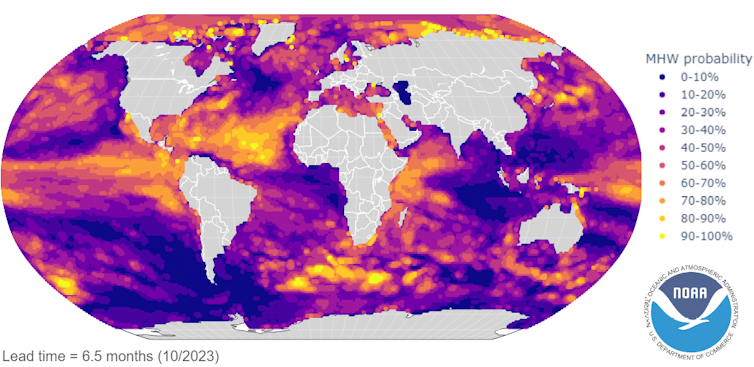
The latest forecast predicts several active marine heat waves to persist into June-August, including in the North Pacific, off the coast of Peru, southeast of New Zealand and in the tropical North Atlantic.
The same forecasts predict El Niño to ramp up over the next six to nine months, increasing marine heat wave risk in January to March of 2024 for the U.S. West Coast, the western Indian Ocean, the Bay of Bengal, and the tropical North Atlantic.
That said, these predictions are far enough out that things could change. Time will tell whether they hold (hot) water, but we would do well to prepare. El Niño is coming.![]()
Dillon Amaya, Climate Research Scientist, National Oceanic and Atmospheric Administration
This article is republished from The Conversation under a Creative Commons license. Read the original article.
Poorer countries must be compensated for climate damage. But how exactly do we crunch the numbers?

As the planet warms, a key concern in international climate negotiations is to compensate developing nations for the damage they suffer. But which nations should receive money? And which extreme weather events were influenced by climate change?
Most nations last year signed up to an agreement to establish a so-called “loss and damage” fund. It would provide a means for developed nations – which are disproportionately responsible for greenhouse gas emissions – to provide money to vulnerable nations dealing with the effects of climate change.
Part of the fund would help developing nations recover from catastrophic extreme weather. For example, it might be used to rebuild homes and hospitals after a floods or provide food and emergency cash transfers after a cyclone.
Some experts have suggested the science of “event attribution” could be used to determine how the funds are distributed. Event attribution attempts to determine the causes of extreme weather events – in particular, whether human-caused climate change played a part.
But as our new paper sets out, event attribution is not yet a good way to calculate compensation for nations vulnerable to climate change. An alternative strategy is needed.
What Is Event Attribution?
Extreme weather events are complex and caused by multiple factors. The science of extreme event attribution primarily seeks to work out whether either human-caused climate change or natural variability in the climate contributed to these events.
For example, a recent study found the extreme rain that triggered New Zealand’s February flooding was up to 30% more intense due to human influence on the climate system.
Attribution science is progressing quickly. It’s increasingly focused on extreme rain events, which in the past have been tricky to study. But it’s still not a consistent and robust way to estimate the costs and impacts of extreme events.
Why Can’t We Use It?
Event attribution science draws on both observational weather data and climate model simulations.
Most commonly, two types of climate model simulations are used: those that include the effects of human-caused greenhouse gas emissions, and those that exclude them. Comparing the two types of simulations allows scientists to estimate how climate change influences the likelihood and severity of extreme events.
But climate models primarily simulate processes in the atmosphere and ocean. They don’t directly simulate the damage caused by an extreme weather event - such as how many people died due to a heatwave or infrastructure loss during a flood.
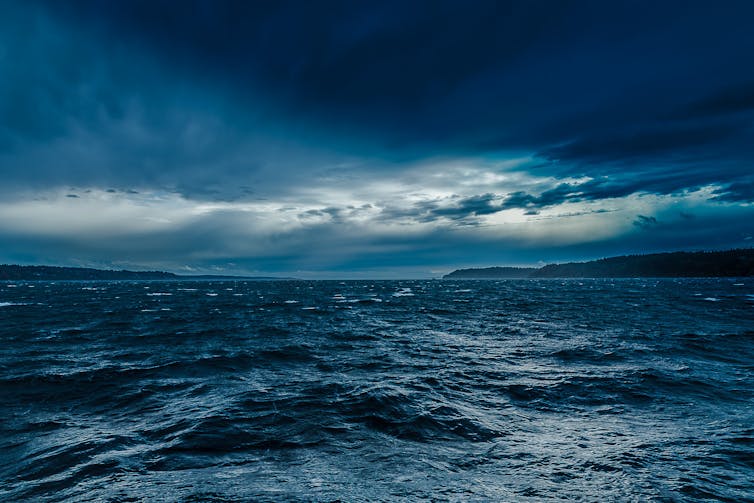
To directly simulate the effects of an extreme event, we need to know the exact extent to which weather components such as temperature and rainfall caused damage. In some cases, this can be determined. But it requires high-quality data, such as hospital admissions, that’s rarely available in most parts of the world.
Also, climate models are not good at simulating some extreme events, such as thunderstorms or extreme winds. That’s because such events are sporadic and tend to occur across small areas. This makes them harder to model than, say, a heatwave that affects a large area.
So if “loss and damage” funding decisions relied too much on event attribution, then a low-income nation hit by a heatwave may receive more support than a nation damaged by storms or high winds, relative to the damage caused.
What’s more, event attribution is not yet able to estimate how climate change causes damage associated with so-called “compound” extreme events.
Compound events refer to cases where more than one extreme event occurs simultaneously in neighbouring regions, or consecutively in a single region. Examples include a drought followed by a heatwave, or sea level rise which makes damage from a tsunami even worse.
How Do We Move Forward?
Event attribution is not yet advanced enough to calculate “loss and damage” from climate change.
Instead, our paper suggests “loss and damage” funds are used alongside foreign aid spending to support recovery in low-income nations following any extreme events where human-caused climate change may have played a role.
We also present four major recommendations for using event attribution to estimate “loss and damage” in future. These are:
Help developing countries use event attribution techniques: to date, event attribution has largely been conducted by wealthy countries in their own regions
Address more types of extreme events: tornadoes, hailstorms and lightning are largely beyond the capability of climate models used in event attribution because they are localised and complex. New techniques to examine these events should be attempted
More research into the impacts and costs of extreme events: few studies have attempted to attribute the costs of extreme events to climate change. Further efforts are needed, especially in low-income nations
Combine event attribution with other knowledge: scientists and experts in aid and policymaking must collaborate on a strategy for using event attribution information. Better understanding of the needs of policymakers and the limitations of event attribution science could lead to more useful studies.

A Growing Burden
Low-income nations have contributed relatively little to global emissions. Compensation from richer nations is vital to helping them manage the growing burden of climate harms.
But distributing these funds in a fair way is challenging. Until the field of event attribution advances, putting too much reliance on event attribution is a risky strategy.
The authors acknowledge the contribution of Izidine Pinto to the research underpinning this article.![]()
Andrew King, Senior Lecturer in Climate Science, The University of Melbourne; Joyce Kimutai, Climate Scientist, University of Cape Town; Luke Harrington, Senior Lecturer in Climate Change, University of Waikato, and Michael Grose, Climate projections scientist, CSIRO
This article is republished from The Conversation under a Creative Commons license. Read the original article.
A dive into the deep past reveals Indigenous burning helped suppress bushfires 10,000 years ago
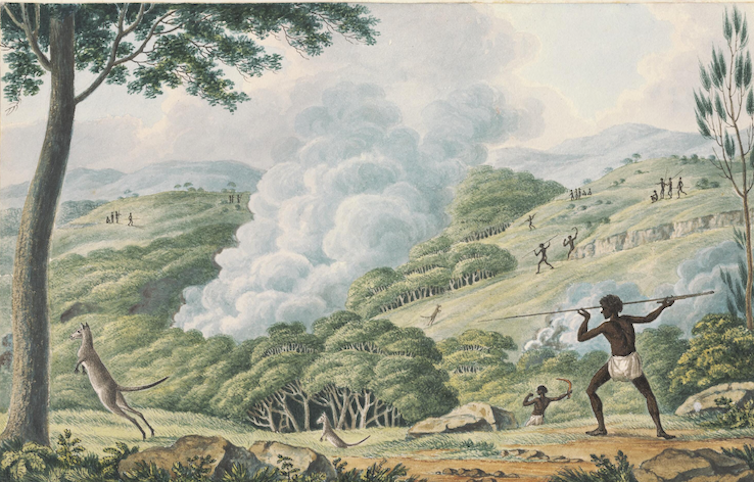
Indigenous Australians have conducted cultural burning for at least ten millenia and the practice helped reduce bushfire risk in the past, our new research shows.
The study provides more evidence of the very long history of cultural burning in southeast Australia. While the burning was probably not specifically used to manage bushfires, our data suggest it nonetheless reduced fire extremes.
Indigenous cultural burning involves applying frequent, small and low-intensity or “cool” fires to clean out grasses and undergrowth. But the scientific evidence for when in history Indigenous Australians used cultural burning, and what they were seeking to achieve, is unclear.
Our findings suggest Indigenous cultural burning in the past may have helped reduce the intensity of bushfires. These findings are important because evidence suggests cultural burning can assist modern land management as climate change worsens.
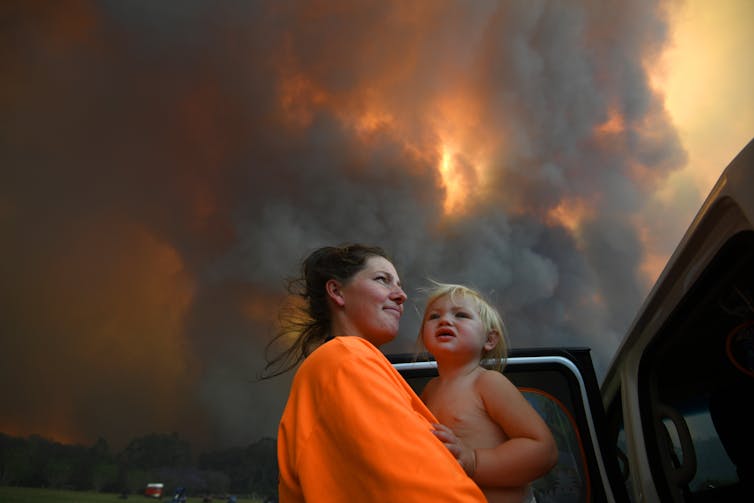
When Did Cultural Burning Start In Australia?
Some experts suggest cultural burning was adopted in the Pleistocene period, about 50,000 to 10,000 years ago.
Increases in charcoal in sediments have been linked to the arrival of humans, and subsequent vegetation change, on the Atherton Tablelands in northeast Queensland from about 45,000 years ago.
However, similar changes occurred on some Pacific Islands at times when humans were not present. This has cast doubt on whether past fires in Australia were the result of human activity.
Another point of view suggests cultural burning was adopted only in the last few thousand years.
Some current cultural burning programs in Australia were only established or re-established in the second half of the 20th Century. But they mostly take place in arid and tropical environments, and it’s not certain whether they can be readily applied to temperate regions.
Our research sought to shed light on when cultural burning in southeast Australia began, and what effect it had. We focused on a site in the Illawarra region of New South Wales. In particular, we examined sediments from the bed of Lake Courijdah in the Thirlmere Lakes National Park, which holds a unique record into the past.

A Spotlight On Charcoal
Sediments in Lake Courijdah cover two time periods: one before Aboriginal people are thought to have arrived in Australia, and one after.
The older sediments, from about 135,000 to 105,000 years ago, included a period known as the Last Interglacial. This climatic period was very similar to today’s and would have produced similar environmental conditions. Importantly, humans were not present at this time.
Above this layer were deposits dating to the last 18,000 years, extending from the end of a cool and probably arid period known as the Last Glacial Maximum up to about 500 years ago.
It’s well-documented that in this time period, Indigenous people were living across the Sydney Basin, including the Illawarra region.
From these sediments, we examined the accumulation of charcoal – a common method used to determine the frequency and relative size of bushfires. We also used a new method known as “Fourier Transform Infrared spectroscopy”. It determines bushfire severity based on the chemical composition of the charcoal produced.
Using this new method is important. Recent research by our UNSW lab showed how traditional charcoal techniques may mask evidence of human fire use (in the form of cool fires).
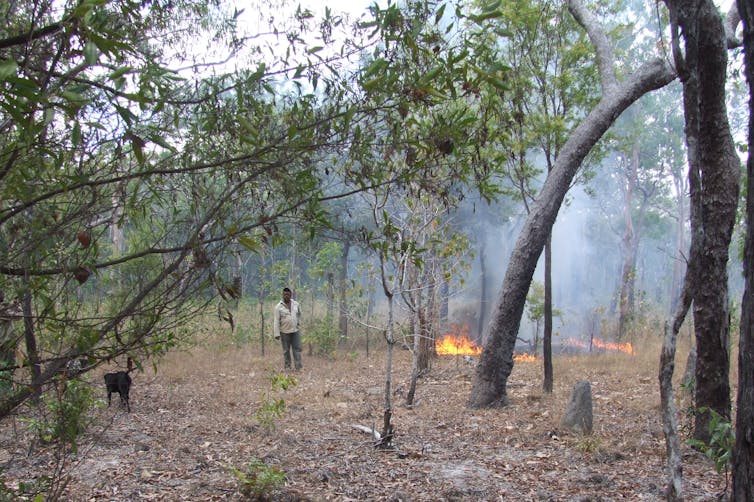
Our Results
So what did we find? During both periods, climatic change was the main driver of fire activity. This suggests human-caused climate change will continue to influence overall fire conditions in future.
But we found a marked difference between the two time periods when looking at the severity of fire. Despite significant climatic change over the last 18,000 years, fire severity remained lower, when compared to the earlier period without humans.
As such, we conclude that Indigenous cultural burning practices undertaken around Thirlmere Lakes from about 10,000 years ago may have suppressed extreme wildfires.
Cultural burning in the region may have begun earlier than this. However, data from before 10,000 years ago is variable – probably as a result of sea-level change – so we can’t say for sure.
Indigenous people using cultural burning were probably not focused on wildfire suppression. Early explorer records, and even more recent work, suggests burning improved hunting prospects and the diversity of resources. However, cultural burning nonetheless appears to have reduced wildfires in this case.
Looking Ahead
El Niño conditions are predicted to return to Australia this year. Inevitably, thoughts return to the massive Black Summer bushfire season of 2019-2020 and how to prevent such disasters in future.
Our findings suggest when it comes to future fire management in eastern Australia, traditional practices by Indigenous people should be taken into account in policy and decision-making.
Adopting cultural burning as part of our toolkit is likely to minimise wildfires and help keep people safe. ![]()
Alan N Williams, Associate Investigator, ARC Centre of Excellence for Australian Biodiversity and Heritage, UNSW Sydney; Mark Constantine IV, Researcher, UNSW Sydney, and Scott Mooney, Associate professor, UNSW Sydney
This article is republished from The Conversation under a Creative Commons license. Read the original article.
The Surprising Science Behind Long-Distance Bird Migration
April 17, 2023
Scientists have recently made a surprising discovery, with the help of a wind tunnel and a flock of birds. Songbirds, many of which make twice-yearly, non-stop flights of more than 1,000 miles to get from breeding range to wintering range, fuel themselves by burning lots of fat and a surprising amount of the protein making up lean body mass, including muscle, early in the flight. This flips the conventional wisdom on its head, which had assumed that migrating birds only ramped up protein consumption at the very end of their journeys, because they would need to use every ounce of muscle for wing-flapping, not fuel.
"Birds are amazing animals," says Cory Elowe, the paper's lead author and a postdoctoral researcher in biology at UMass Amherst, where he received his Ph.D. "They are extreme endurance athletes; a bird that weighs half an ounce can fly, non-stop, flapping for 100 hours at a time, from Canada to South America. How is this possible? How do they fuel their flight?"
For a very long time, biologists assumed that birds fuelled such feats of endurance by burning fat reserves. And indeed, fat is an important part of migratory birds' secret mix. "The birds in our tests burned fat at a consistent rate throughout their flights," says Elowe. "But we also found that they burn protein at an extremely high rate very early in their flights, and that the rate at which they burn protein tapers off as the duration of the flight increases."
"This is a new insight," says Alexander Gerson, associate professor of biology at UMass Amherst and the paper's senior author. "No one has been able to measure protein burn to this extent in birds before."
"We knew that birds burned protein, but not at this rate, and not so early in their flights," continues Gerson. "What's more, these small songbirds can burn 20% of their muscle mass and then build it all back in a matter of days."
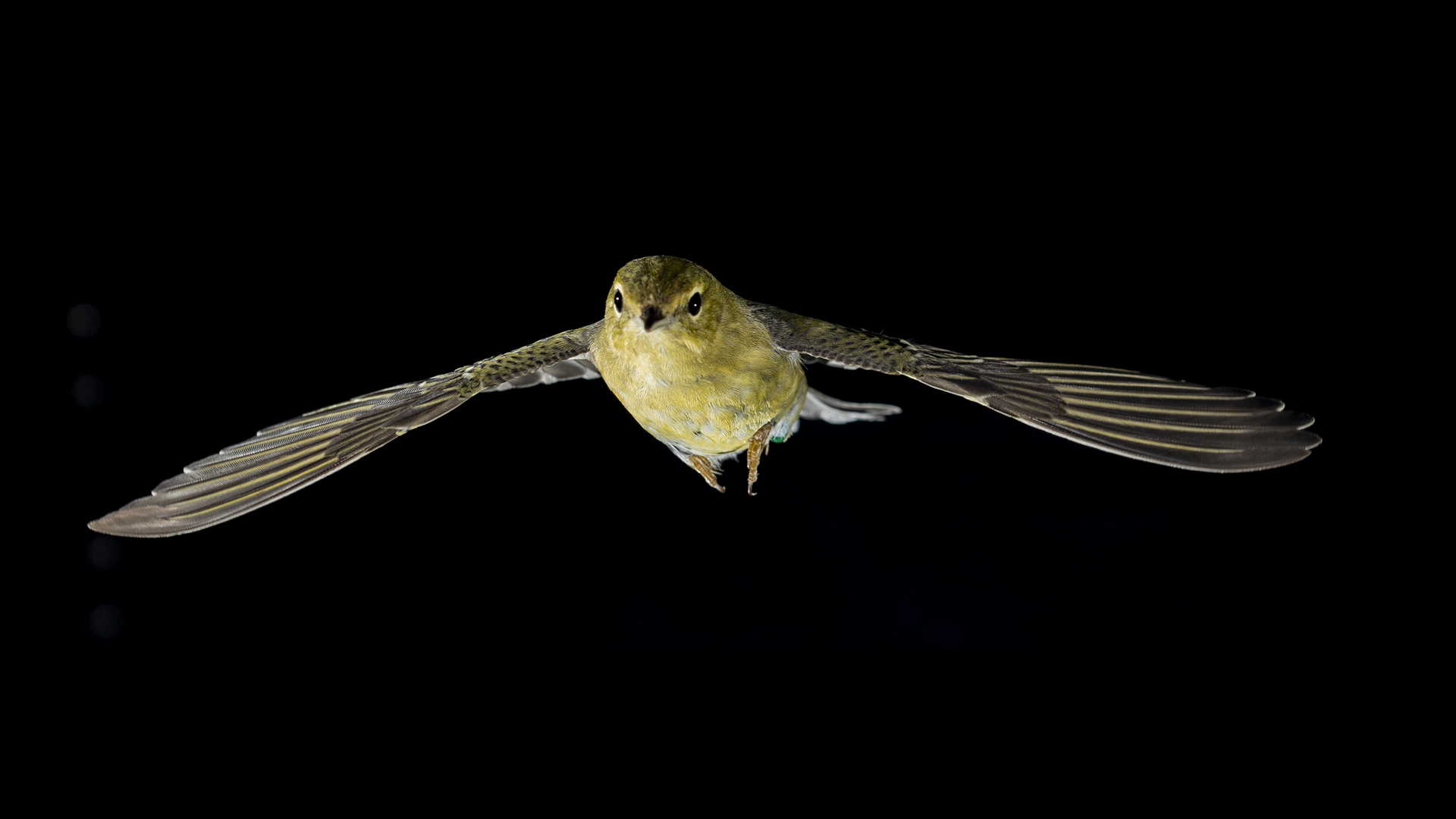
A blakpoll warbler. Photo: University of Massachusetts Amherst
To make this breakthrough, Elowe had help from the bird banding operators at Long Point Bird Observatory, in Ontario, along the northern shore of Lake Erie. Every fall, millions of birds gather near the observatory on their journey to their wintering grounds -- including the blackpoll warbler, a small songbird that travels thousands of miles during its migration. After capturing 20 blackpolls and 44 yellow-rumped warblers -- a shorter distance migrant -- using mist nets, Elowe and his colleagues then transported the birds to the Advanced Facility for Avian Research at Western University, which has a specialized wind tunnel built specifically for observing birds in flight.
Elowe measured the birds' fat and lean body mass pre-flight, then, when the sun set, let the birds free in the wind tunnel. Because the birds naturally migrate at night, Elowe and his colleagues would then stay awake -- at one point, for 28 hours -- watching for when a bird would decide to rest. At that point, the researchers would collect the bird and again measure its fat and lean body mass content, comparing them with the pre-flight measurements.
"One of the biggest surprises was that every bird still had plenty of fat left when it chose to end its flight," says Elowe. "But their muscles were emaciated. Protein, not fat, seems to be a limiting factor in determining how far birds can fly."
The researchers still don't quite know why the birds are burning such vast stores of protein so early in their journeys, but the possible answers open up a wide range of future research avenues.
"How exactly is it possible to burn up your muscles and internal organs, and then rebuild them as quickly as these birds do," wonders Gerson. "What insights into the evolution of metabolism might these birds yield?"
Elowe is curious about shivering -- nonmigratory birds that overwinter in cold areas keep themselves warm by shivering. "This is also a feat of endurance," says Elowe. "Do birds fuel their winter shivering spells the same way? And as the world warms, which method of coping with the cold -- shivering or migrating -- might be the better option for survival?"
Cory R. Elowe, Derrick J. E. Groom, Julia Slezacek, Alexander R. Gerson. Long-duration wind tunnel flights reveal exponential declines in protein catabolism over time in short- and long-distance migratory warblers. Proceedings of the National Academy of Sciences, 2023; 120 (17) DOI: 10.1073/pnas.2216016120
Coastal Species Persist On High Seas On Floating Plastic Debris
April 17, 2023
The high seas have been colonised by a surprising number of coastal marine invertebrate species, which can now survive and reproduce in the open ocean, contributing strongly to the floating community composition. This finding was published today in Nature Ecology and Evolutionby a team of researchers led by the Smithsonian Environmental Research Center (SERC) and the University of Hawai'i (UH) at Manoa.
The researchers found coastal species, representing diverse taxonomic groups and life history traits, in the eastern North Pacific Subtropical Gyre on over 70 percent of the plastic debris they examined. Further, the debris carried more coastal species than open ocean species.
"This discovery suggests that past biogeographical boundaries among marine ecosystems -- established for millions of years -- are rapidly changing due to floating plastic pollution accumulating in the subtropical gyres," said lead author Linsey Haram, research associate at SERC.
These researchers only recently discovered the existence of these "neopelagic communities," or floating communities in deep ocean waters. To understand the ecological and physical processes that govern communities on floating marine debris, SERC and UH Manoa formed a multi-disciplinary Floating Ocean Ecosystem (FloatEco) team. UH Manoa led the assessment of physical oceanography and SERC evaluated biological and ecological dimensions of the study.
For this study, the FloatEco team analysed 105 plastic samples collected by The Ocean Cleanup during their 2018 and 2019 expeditions in the North Pacific Subtropical Gyre, which occupies most of the northern Pacific Ocean. The field work relied on participation of both individual volunteers and non-governmental organisations.
"We were extremely surprised to find 37 different invertebrate species that normally live in coastal waters, over triple the number of species we found that live in open waters, not only surviving on the plastic but also reproducing," said Haram. "We were also impressed by how easily coastal species colonized new floating items, including our own instruments -- an observation we're looking into further."
"Our results suggest coastal organisms now are able to reproduce, grow, and persist in the open ocean -- creating a novel community that did not previously exist, being sustained by the vast and expanding sea of plastic debris," said co-author Gregory Ruiz, senior scientist at SERC. "This is a paradigm shift in what we consider to be barriers to the distribution and dispersal of coastal invertebrates."
While scientists already knew organisms, including some coastal species, colonized marine plastic debris, scientists were unaware until now that established coastal communities could persist in the open ocean. These findings identify a new human-caused impact on the ocean, documenting the scale and potential consequences that were not previously understood.
"The Hawaiian Islands are neighboured in the northeast by the North Pacific garbage patch," said Nikolai Maximenko, co-author and senior researcher at the UH Manoa School of Ocean and Earth Science and Technology. "Debris that breaks off from this patch constitutes the majority of debris arriving on Hawaiian beaches and reefs. In the past, the fragile marine ecosystems of the islands were protected by the very long distances from coastal communities of Asia and North America. The presence of coastal species persisting in the North Pacific Subtropical Gyre near Hawai'i is a game changer that indicates that the islands are at an increased risk of colonization by invasive species."
"Our study underscores the large knowledge gap and still limited understanding of rapidly changing open ocean ecosystems," said Ruiz. "This highlights the need for dramatic enhancement of the high-seas observing systems, including biological, physical and marine debris measurements."
Linsey E. Haram, James T. Carlton, Luca Centurioni, Henry Choong, Brendan Cornwell, Mary Crowley, Matthias Egger, Jan Hafner, Verena Hormann, Laurent Lebreton, Nikolai Maximenko, Megan McCuller, Cathryn Murray, Jenny Par, Andrey Shcherbina, Cynthia Wright, Gregory M. Ruiz. Extent and reproduction of coastal species on plastic debris in the North Pacific Subtropical Gyre. Nature Ecology & Evolution, 2023; DOI: 10.1038/s41559-023-01997-y
New Approach Estimates Long-Term Coastal Cliff Loss
April 18, 2023
In parts of California's iconic mountainous coasts, breath-taking beauty is punctuated by brusque signs warning spectators to stay back from unstable cliffs. The dangers of coastal erosion are an all-too-familiar reality for the modern residents of these communities. Now, with a new tool, researchers are bringing historical perspective to the hotly debated topic of how to manage these disappearing coastlines.
Using a model that incorporates measurements of the amount of time coastal cliffs and their remnant deposits were exposed at the Earth's surface, Stanford researchers found that the rate of cliff erosion in the past 100 years is similar to that of the past 2,000 years. The proof-of-concept, published in the Journal of Geophysical Research: Earth Surface April 17, opens the possibility of using this new approach to understand the long-term history of coastal cliff erosion, or retreat, in other parts of the state. The work was conducted in Del Mar, California, a beach town in San Diego County with infrastructure atop its coastal bluffs.
"In this particular location, these cliff erosion rates have been the same for thousands of years, so we shouldn't expect them to get lower," said senior study author Jane Willenbring, an associate professor of Earth and planetary sciences at the Stanford Doerr School of Sustainability. "If anything, we should expect them to be higher in the future."
Del Mar is among locations that are critically important for understanding cliff retreat. Homes are situated up to 70 feet above its beach, in addition to public infrastructure. A major railroad between Los Angeles and San Diego runs atop the coastal bluffs, where cliff failures have resulted in several derailments in modern history, as well as rock fall events that led to closures in recent years.
"I think this study bolsters the thinking that we should do something about cliff retreat sooner rather than later," said lead study author Travis Clow, PhD '22.
A natural laboratory
The study area was ideal for the researchers' methodology because the Del Mar beach features a narrow shore platform, the bedrock where tidepools are typically found. Using nine samples of bedrock, the co-authors measured concentrations of the chemical isotope beryllium-10 that track landform exposure to cosmic radiation from space. The data were compared with cliff retreat rates from recent studies based on aerial photography, showing that coastal erosion rates have remained relatively constant over the past two millennia -- at about 2 to 5 inches per year.
"One of the advantages of this technique is that it gives you information at the time scales that are relevant for factors like sea-level rise," Willenbring said. "Our tool estimates retreat over time periods that include multiple major storms or atmospheric rivers that don't happen very often, but are critical in forming the coastline."
The researchers' approach explores the influence of different factors, including wave impacts and weathering that occur at the shore platform and the cliff interface.
"It does more than just spit out a retreat rate," said Clow, who processed the samples in Willenbring's lab and measured them at the Center for Accelerator Mass Spectrometry at Lawrence Livermore National Laboratory (LLNL). "It also allows us to have a relative assessment of what might be driving cliff retreat over longer periods of time."
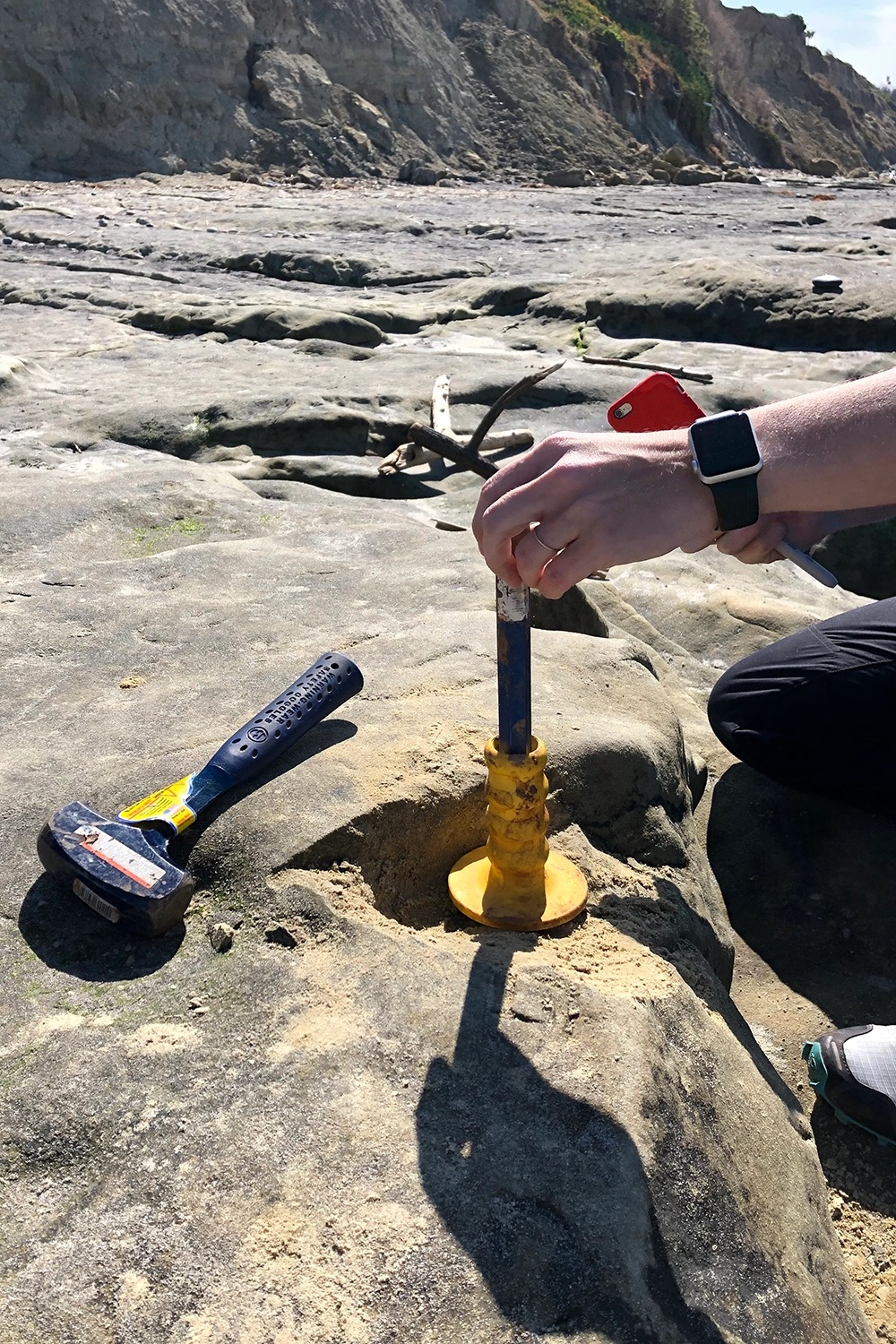
Jane Willenbring sampling shore platform bedrock in Del Mar with a hammer and chisel. (Image credit: Travis Clow)
When rock becomes air
On sandy coasts, like those spanning much of the eastern U.S., beaches are shaped by waves that pull sand out to the ocean, then re-deposit it on land with the coming and going of the tides. But with rocky coastlines like those along California, once a cliff erodes into the ocean, it cannot be replaced, Willenbring said. Instead, it's as if the rock becomes air.
Willenbring was surprised to learn through this research that over half of all coastlines on Earth are eroding like California's. The scope of the problem, which will be exacerbated by sea-level rise in the next century, presents an opportunity for using this new technique in other areas.
"There are plenty of other places in California and the Pacific Northwest where active erosion of coastal rocky cliffs is happening, and we hope to use this technique in a wide variety of environments," Clow said.
Knowledge of cliff retreat in the U.S. is about 50 years behind research on the impacts of erosion and storms on sandy beaches, according to Willenbring -- and that makes her excited about contributing to fundamental science in this field.
"No one had even looked at how the beach width correlated with the rate of cliff retreat in California," Willenbring said. "There are a lot of open questions about what drives coastal erosion, and now we have a new tool to be able to address some of them."
Additional study co-authors are from the Scripps Institution of Oceanography at the University of California, San Diego; the Center for Accelerator Mass Spectrometry at LLNL; and Imperial College London. The research was supported by LLNL, the California Department of Parks and Recreation, and the U.S. Army Corps of Engineers.
T. Clow, J. K. Willenbring, A. P. Young, H. Matsumoto, A. J. Hidy, J. R. Shadrick. Late Holocene Cliff Retreat in Del Mar, CA, Revealed From Shore Platform 10 Be Concentrations and Numerical Modeling. Journal of Geophysical Research: Earth Surface, 2023; 128 (4) DOI: 10.1029/2022JF006855
Methane From Megafires: More Spew Than We Knew
April 18, 2023
Using a new detection method, UC Riverside scientists found a massive amount of methane, a super-potent greenhouse gas, coming from wildfires -- a source not currently being accounted for by state air quality managers.
Methane warms the planet 86 times more powerfully than carbon dioxide over the course of 20 years, and it will be difficult for the state to reach its required cleaner air and climate goals without accounting for this source, the researchers said.
Wildfires emitting methane is not new. But the amount of methane from the top 20 fires in 2020 was more than seven times the average from wildfires in the previous 19 years, according to the new UCR study.
"Fires are getting bigger and more intense, and correspondingly, more emissions are coming from them," said UCR environmental sciences professor and study co-author Francesca Hopkins. "The fires in 2020 emitted what would have been 14 percent of the state's methane budget if it was being tracked."
The state does not track natural sources of methane, like those that come from wildfires. But for 2020, wildfires would have been the third biggest source of methane in the state.
"Typically, these sources have been hard to measure, and it's questionable whether they're under our control. But we have to try," Hopkins said. "They're offsetting what we're trying to reduce."
Traditionally, scientists measure emissions by analysing wildfire air samples obtained via aircraft. This older method is costly and complicated to deploy. To measure emissions from 2020's Sequoia Lightning Fire Complex in the Sierra Nevadas, the UCR research team used a remote sensing technique, which is both safer for scientists and likely more accurate since it captures an integrated plume from the fire that includes different burning phases.
The technique, detailed in the journal Atmospheric Chemistry and Physics, allowed the lead author, UCR environmental sciences Ph.D. student Isis Frausto-Vicencio to safely measure an entire plume of the Sequoia Lightning Fire Complex gas and debris from 40 miles away.
"The plume, or atmospheric column, is like a mixed signal of the whole fire, capturing the active as well as the smouldering phases," Hopkins said. "That makes these measurements unique."
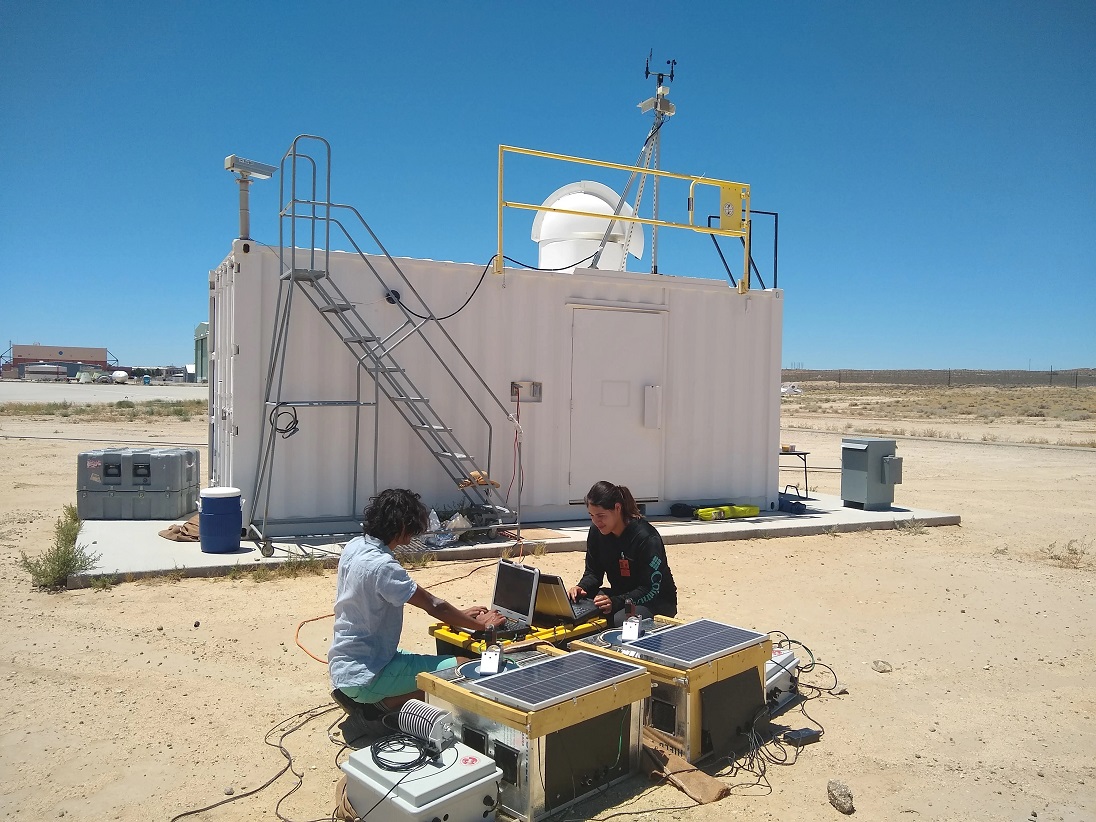
Researchers Isis Frausto-Vicencio, UCR, and Sajjan Heerah, Los Alamos National Laboratory, measuring wildfire emissions. (Frausto-Vicencio/UCR)
Rather than using a laser, as some instruments do, this technique uses the sun as a light source. Gases in the plume absorb and then emit the sun's heat energy, allowing insight into the quantity of aerosols as well as carbon and methane that are present.
Using the remote technique, the researchers found nearly 20 gigagrams of methane emitted by the Sequoia Lightning Fire Complex. One gigagram is 1,000 metric tons. An elephant weighs around one metric ton. For context, the fire therefore contained roughly 20,000 elephants' worth of the gas.
This data matches measurements that came from European space agency satellite data, which took a more sweeping, global view of the burned areas, but are not yet capable of measuring methane in these conditions.
If included in the California Air Resources Board methane budget, wildfires would be a bigger source than residential and commercial buildings, power generation or transportation, but behind agriculture and industry. While 2020 was exceptional in terms of methane emissions, scientists expect more megafire years going forward with climate change.
In 2015, the state first established a target of 40 percent reduction in methane, refrigerants and other air pollutants contributing to global warming by 2030. The following year, in 2016, Gov. Jerry Brown signed SB 1383, codifying those reduction targets into law.
The reductions are meant to come from regulations that capture methane produced from manure on dairy farms, eliminate food waste in landfills, require oil and gas producers to minimize leaks, ban certain gases in new refrigerators and air conditioners, and other measures.
"California has been way ahead on this issue," Hopkins said. 'We're really hoping the state can limit the methane emissions under our control to reduce short-term global warming and its worst effects, despite the extra emissions coming from these fires."
Isis Frausto-Vicencio, Sajjan Heerah, Aaron G. Meyer, Harrison A. Parker, Manvendra Dubey, Francesca M. Hopkins. Ground solar absorption observations of total column CO, CO2, CH4, and aerosol optical depth from California's Sequoia Lightning Complex Fire: emission factors and modified combustion efficiency at regional scales. Atmospheric Chemistry and Physics, 2023; 23 (7): 4521 DOI: 10.5194/acp-23-4521-2023
We found out when the Nullarbor Plain dried out, splitting Australia’s ecosystems in half
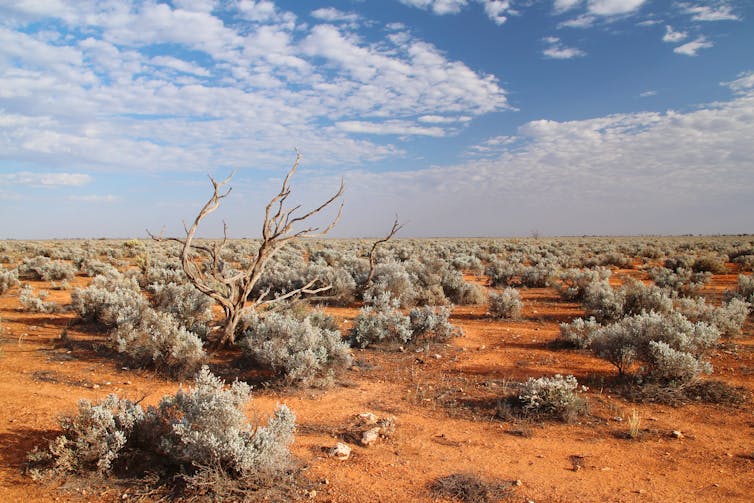
Australia’s western and eastern ecosystems are biodiversity hotspots, separated by a dry desert interior. Yet millions of years ago, many species roamed more freely between connected habitats across the continent.
Our new research, published in Geophysical Research Letters, provides insights into ancient climate change that shaped our modern landscapes and ecosystems.
We have developed a new way to reconstruct the timing of great drying episodes on the continents of our planet. This work helps to gain knowledge about drylands that are particularly impacted by current climatic stresses.
Billions Of People Live In Drylands
Drylands cover almost half of Earth’s land surface and are home to around 3 billion people. Dramatic, record-breaking droughts are increasingly occurring around the globe.
As the driest inhabited continent, Australia (70% is considered arid or semi-arid) also faces many challenges, including droughts and bushfires. Understanding the history of dry regions and their response to past climate change is important to mitigate the impact of our warming planet’s future.
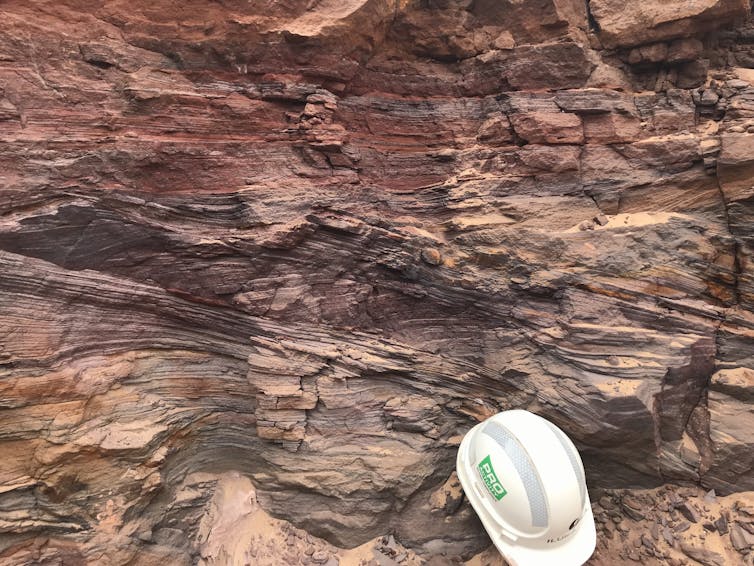
Southern Australia’s Nullarbor Plain covers an area about the size of Great Britain (roughly 200,000 square kilometres). However, it is starkly different in almost every other aspect: extremely flat, very little rain, and almost no trees. These conditions and its size make the Nullarbor Plain a natural “biogeographic barrier”, separating rich and diverse ecosystems in west and east Australia.
Today, the dusty Nullarbor Plain bears little resemblance to its vibrant past. Before roughly 14 million years ago it was covered by ocean and host to reefs. More recently, it would have been a lush home to an exotic menagerie, including the world’s biggest cuckoos.
The Drying Of The Nullarbor
We know Earth is constantly evolving, but often have a poor idea of exactly when environmental changes occurred in the distant past. Fortunately, some minerals that record past climatic events can be dated.
For most people, rust is something they want to avoid, as it damages our cars, fences, and steel appliances. But rust can be useful in understanding climate change. In our work, we used an iron-bearing mineral called goethite – the main part of rust – to unlock the timing of drying on the Nullarbor.
We found goethite in rocks some 25 metres below the Nullarbor Plain. These rocks mark the past level of groundwater. By dating the age of the goethite minerals, we can understand how past groundwater levels shifted in response to climate change.
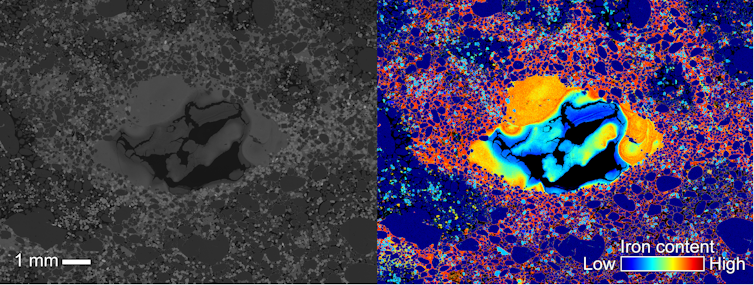
We fired a laser beam into tiny pieces of goethite, roughly the size of a grain of salt, to release their atomic building blocks. We then measured the helium isotopes – variants of helium – that had accumulated since mineral formation. This provided us with a type of “clock”.
We calculated groundwater drastically declined on the Nullarbor Plain between 2.4 and 2.7 million years ago – at the same time as a period of global cooling.
As the climate shifted, the drying changed the local ecosystems, effectively creating a wall for many species. As large swathes of Australia changed from forest to dry grassland, habitat and food availability shrunk for many species.
Significantly, this barrier cut the once continuous link between the species of southwest and southeast Australia.
Splitting Of The Species
The evolution of many familiar species was influenced by this separation. There is the yellow-tailed black cockatoo from southeast Australia with yellow cheeks, and Carnaby’s black cockatoo with white cheeks in the southwest. Genetically, these two cockatoos are close relatives, but today live thousands of kilometres apart.

Through isolation, the drying of the Nullarbor played a key role in creating the species richness of southwest Australia. This region is one of only 35 biodiversity hotspots on Earth and home to more than 6,000 native species, with many found nowhere else.
Measuring the timescales of drying landscapes is important for conservation biology. Many native species are already facing or will face existential problems due to climate change and habitat degradation – including the iconic Carnaby’s cockatoo.
A History Locked In Minerals
By studying minerals formed during groundwater decline, we improve our understanding of our continent’s past and its biosphere. These minerals form as a direct result of continental drying, often in sediment with fossils of interest.
Previously, we often relied on indirect information like the chemistry of marine sediments to date continental landscape processes.
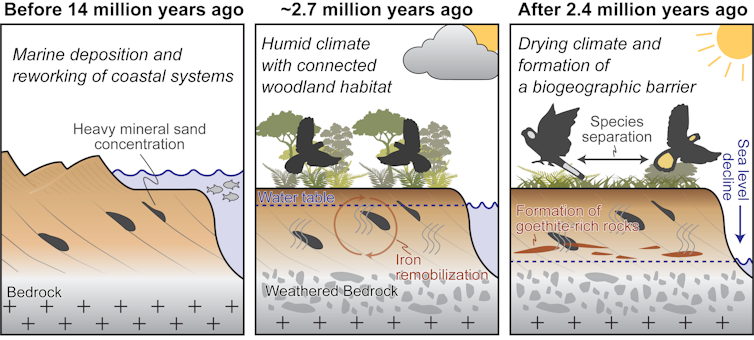
More broadly, having information on the timing of past drying events could help test theories about human evolution too. Changing landscapes and extreme drying were likely important for our own species development.
Determining the timing of environmental change lets scientists see how these events have impacted biodiversity and species evolution over time. Studying the past is also vital to understand how Earth responds to climate change. If we understand how ecosystems dry out, we can develop strategies to limit the damage.![]()
Maximilian Dröllner, Research associate, Curtin University; Chris Kirkland, Professor of Geochronology, Curtin University, and Milo Barham, Associate Professor, Earth and Planetary Sciences, Curtin University
This article is republished from The Conversation under a Creative Commons license. Read the original article.
Sonnet 29
By William Shakespeare
When The War Came To Cowra
Council's Youth Voice Action Plan 2028 Gets The Green Light
Northern Composure Band Competition 2023
Due to the pandemic, Council have had the 20th anniversary on hold but pleased to say that the competition is open and running again.
Northern Composure is the largest and longest-running youth band competition in the area and offers musicians local exposure as well as invaluable stage experience. Bands compete in heats, semi finals and the grand final for a total prize pool of over $15,000.
Over the past 20 years we have had many success stories and now is your chance to join bands such as:
- Ocean Alley
- Lime Cordiale
- Dear Seattle
- What So Not
- The Rions
- Winston Surfshirt
- Crocodylus
And even a Triple J announcer plus a wide range of industry professionals
About the Competition
In 2023, the comp looks a little different.
All bands are invited to enter our heats which will be exclusively run online and voted on by your peers and community by registering below and uploading a video of one song of your choice. (if you are doing a cover, please make sure to credit the original band) We are counting on you to spread the word and get your friends, family, teachers voting for you!
The top 8-12 bands will move on through to our live semi finals with a winner from each moving on to the grand final held during National Youth Week. Not only that but we have raised the age range from 19 to 21 for all those musicians who may have missed out over the past two years.
Key dates
- Voting open for heats: Mon 13 Feb – Sun 26 Feb
- Band Briefing: Mon 6 March, Dee Why PCYC
- Semi 1: Sat 18 March Mona Vale Memorial Hall
- Semi 2: Sat 25 March, YOYOs, Frenchs Forest
- Grand Final: Fri 28 April, Dee Why PCYC
For more information contact Youth Development at youth@northernbeaches.nsw.gov.au or call 8495 5104
Stay in the loop and follow Northern Composure Unplugged on KALOF Facebook.
School Leavers Support
- Download or explore the SLIK here to help guide Your Career.
- School Leavers Information Kit (PDF 5.2MB).
- School Leavers Information Kit (DOCX 0.9MB).
- The SLIK has also been translated into additional languages.
- Download our information booklets if you are rural, regional and remote, Aboriginal or Torres Strait Islander, or living with disability.
- Support for Regional, Rural and Remote School Leavers (PDF 2MB).
- Support for Regional, Rural and Remote School Leavers (DOCX 0.9MB).
- Support for Aboriginal and/or Torres Strait Islander School Leavers (PDF 2MB).
- Support for Aboriginal and/or Torres Strait Islander School Leavers (DOCX 1.1MB).
- Support for School Leavers with Disability (PDF 2MB).
- Support for School Leavers with Disability (DOCX 0.9MB).
- Download the Parents and Guardian’s Guide for School Leavers, which summarises the resources and information available to help you explore all the education, training, and work options available to your young person.
School Leavers Information Service
- navigate the School Leavers Information Kit (SLIK),
- access and use the Your Career website and tools; and
- find relevant support services if needed.
Word Of The Week: Construct
verb
1. build or make (something, typically a building, road, or machine). 2. to compose or frame mentally (an argument, sentence, etc) 3. geometry to draw (a line, angle, or figure) so that certain requirements are satisfied
noun
1. an idea or theory containing various conceptual elements, typically one considered to be subjective and not based on empirical evidence. 2. something formulated or built systematically. 3. psychology; a model devised on the basis of observation, designed to relate what is observed to some theoretical framework. In this sense 'Constructs' are the building blocks of scientific theories. Psychologists who are interested in studying and understanding human behaviour are interested in identifying behavioural regularities and their causes. Constructs help research and applied psychologists to summarize the complex array of observed behaviours, emotions, and thoughts that people produce in their day-to-day activities. Research may focus on identifying and clarifying construct boundaries, or determining which constructs relate to other constructs, as a basis for theorizing functional relationships between systems of constructs.
from C17: from Latin constructus piled up, from construere to heap together, build, from Con + struere to arrange, erect.
Narrabeen Education Campus: School Holiday Works Notification
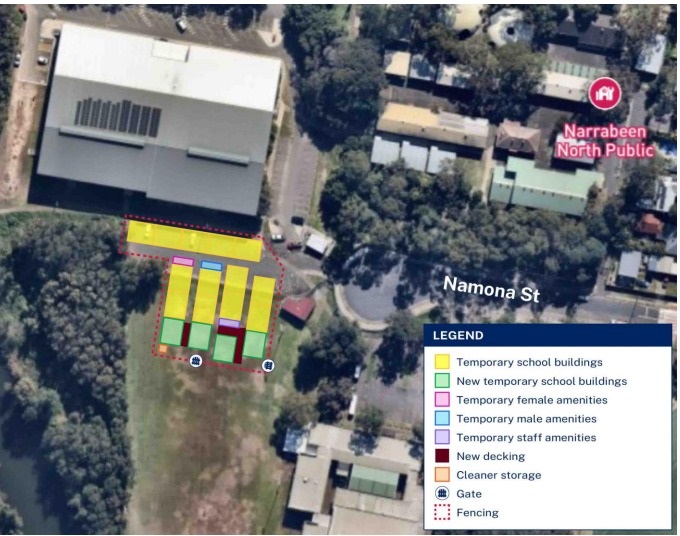
- ▪ new flexible permanent learning spaces
- ▪ upgraded learning spaces
- ▪ new supported learning spaces
- ▪ upgrades to core facilities, including the library, administration and hall.
- ▪ new and upgraded learning spaces
- ▪ upgraded supported learning spaces
- ▪ new amenities and refurbished gym.

Artist Impression of new works at Narrabeen Sports High School. Image: SINSW

Narrabeen Sports High School Site Plan. Image: SINSW
Shakespeare by numbers: how mathematical breakthroughs influenced the Bard’s plays
Madeleine S. Killacky, Bangor UniversityMathematical motifs feature in many of Shakespeare’s most memorable scenes. He lived and wrote in the late 16th century, when new mathematical concepts were transforming perceptions of the world. Part of the role of the theatre was to process the cultural implications of all these changes.
People in Shakespeare’s time were used to the idea of the infinite: the planets, the heavens, the weather. But they were much less used to the inverse idea that the very small (and even nothingness) could be expressed by mathematical axioms. In fact, the first recorded English use of the word “zero” wasn’t until 1598.
Thinkers like Italian mathematician Fibonacci, who lived in the 13th century, helped to introduce the concept of zero – known then as a “cipher” – into the mainstream. But it wasn’t until philosopher René Descartes and mathematicians Sir Isaac Newton and Gottfried Leibniz developed calculus in the late 16th and early 17th centuries that “zero” started to figure prominently in society.
Moreover, scientist Robert Hooke didn’t discover microorganisms until 1665, meaning the idea that life could exist on a micro level remained something of fantasy.

With the growing influence of neoclassical ideas in England, small, insignificant figures had begun to be used to represent very large concepts.
This was happening both in modes of calculation (which used proportion) and in the practice of writing mathematical symbols.
For example, during the 16th and early 17th centuries, the equals, multiplication, division, root, decimal, and inequality symbols were gradually introduced and standardised.
Alongside this came the work of Christopher Clavius – a German Jesuit astronomer who helped Pope Gregory XIII to introduce the Gregorian calendar – and other mathematicians on fractions. Then referred to as “broken numbers”, they stirred up great angst among those who clung to classical models of number theory.

This article is part of our First Folio 400 series. These articles mark the 400th anniversary of the publication of the First Folio, the first collected edition of William Shakespeare’s plays.
The struggle to come to terms with the entanglement of the very large and the very small is splendidly displayed in many of Shakespeare’s works. This includes his history play Henry V and tragedy Troilus and Cressida.
The opening chorus of Henry V displays Shakespeare’s interest in proportion and the concept of zero through its repeated “O” and references to contemporary mathematical thought:
O for a muse of fire, that would ascend / The brightest heaven of invention: / A kingdom for a stage, princes to act, / And monarchs to behold the swelling scene […] / may we cram / Within this wooden O the very casques / That did affright the air at Agincourt? / O pardon: since a crookèd figure may / Attest in little place a million, / And let us, ciphers to this great account, / On your imaginary forces work.
Scholars largely agree that Shakespeare’s “crookèd figure” is actually zero. This is despite, of course, the rather obvious objection that zero is the least crooked of all numbers.
In the line “a crookèd figure may / Attest in little place a million”, Shakespeare references 16th century mathematical debates surrounding the idea that the very small is capable of both representing and influencing the very big. In this case, the zero is capable of transforming 100,000 into 1,000,000.

In this mathematical analogy, “crookèd figure[s]” can “attest” much greater things. The chorus suggests that by using one’s “imaginary forces”, much greater things may come from the forthcoming stage performances.
This extended metaphor reappears in Shakespeare’s tragicomedy, The Winter’s Tale when the “cipher” (numbers) transform into many thousands of thank yous:
Like a cipher, / Yet standing in rich place, I multiply / With one “We thank you” many thousands more / That go before it.
There is a further, visual metaphor in Henry V’s opening prologue where the chorus asks pardon of an “O” to help them represent many things in the “wooden O” – the Globe Theatre. This is perhaps evidence of Shakespeare’s ongoing interest in insignificant figures “attest[ing]” much greater things.
Elsewhere in his work, mathematical metaphors encircle themselves in moments of crisis. In Troilus and Cressida, Shakespeare uses mathematical language to chart the slow motion collapse of Troilus’s mental stability after witnessing his lover Cressida’s flirtation with another man.
For Troilus, Cressida disintegrates into “fractions”, “fragments” and “bits and greasy relics”. To mirror this, Shakespeare’s verse descends into jagged pieces, like the early modern name for fractions: “broken numbers”.
With 2023 marking 400 years since the publication of Shakespeare’s First Folio, it is exciting to see how the Bard’s plays spoke to significant developments in the 16th-century mathematical world.
Shakespeare’s plays registered the 16th-century crisis of classical mathematics in the face of newer ideas. But they also offered space for audiences to come to terms with these new ideas and think differently about the world through the lens of mathematics.![]()
Madeleine S. Killacky, PhD Candidate, Medieval Literature, Bangor University
This article is republished from The Conversation under a Creative Commons license. Read the original article.
Shakespeare’s First Folio turns 400: what would be lost without the collection? An expert speculates

It has been 400 years since the publication of the first collected edition of Shakespeare’s plays, a volume now known as the First Folio. Prepared by his fellow actors after his death, the book presented 36 plays divided into the genres of comedy, history and tragedy.
You can listen to more articles from The Conversation, narrated by Noa, here.
Without it, 18 of Shakespeare’s plays that had not previously been printed would have been lost, among them Macbeth, Julius Caesar, Twelfth Night and The Tempest. No “friends, Romans and countrymen”, no “brave new world”, no “double, double toil and trouble”.
But what would really be different if this book had never been printed at all?
Most significantly, there wouldn’t be the cultural icon we know as “Shakespeare”. Those works that do survive would be scattered across numerous flimsy early editions, rather than gathered in this imposing and serious volume.
Without the weight – cultural as well as literal – of the collected edition, it’s possible few would care about these surviving plays. Something similar happened to other playwrights of the period, whose work was not given the authority of a collection.
We’d also have an idea of Shakespeare as more interested in histories and comedies than tragedies. Macbeth, Antony and Cleopatra, Coriolanus, Julius Caesar and Timon of Athens would be lost without the First Folio.

Since some of these early editions did not name Shakespeare on their title pages, the authorship of plays such as Romeo and Juliet, Titus Andronicus and Henry V would be uncertain. Conversely, title pages identify Shakespeare as the author of The London Prodigal (1605) and A Yorkshire Tragedy (1608), which most modern scholars do not attribute to Shakespeare. In part this is due to the fact that they are not included in the First Folio. Without it, the canon of Shakespeare’s plays would have decisively shifted.
This different canon would have prompted a different historical response. The convenience and ready availability of the First Folio as a repository for Shakespeare’s plays was a significant practical factor in getting him back into the theatres when they reopened at the Restoration of Charles II in 1660.
This large collection of Shakespeare’s works took up visible space on the shelf. Had he not come back into prominence at that important moment – and had the newly revived theatre looked elsewhere for their dramatic scripts – Shakespeare’s reputation might well have been permanently lost.

This article is part of our First Folio 400 series. These articles mark the 400th anniversary of the publication of the First Folio, the first collected edition of William Shakespeare’s plays.
If Shakespeare had not been revived in the later 17th century, it is hard to see how he would have become the national poet during the 18th. No statue in Poets’ corner, no arguments between the literary figures of the day about the best way to edit his plays.
David Garrick – the leading Shakespearean actor of the 18th century – would have had an entirely different career (as, in later periods, would other actors like Laurence Olivier and Judi Dench).
Shakespeare’s International Reputation
This much-depleted Shakespeare would hardly have galvanised outrage about the sale of his Stratford birthplace in the 19th century.
Perhaps modern Stratford-upon-Avon would now simply mark its playwright son with a blue plaque (rather as Shakespeare’s writing partner John Fletcher is remembered in his hometown of Rye). There would be no birthday parade, no Othello taxi firm, no tourist industry. No one would care if his wife, Anne Hathaway, had a cottage.
Without the First Folio there would be no dedicated Shakespeare theatre in Stratford, or at Shakespeare’s Globe on Bankside. There would be no Shakespeare festivals around the world, such as that in Stratford, Ontario. In fact, Stratford, Ontario, named in the 19th century for Shakespeare’s hometown, would now have a different name entirely, as would Stratfords in Ohio, Connecticut, Wisconsin, New Jersey and in New Zealand and Australia.

Halloween would be quite different without Macbeth, which popularised a trio of witches around a cauldron performing a spell. Valentine cliches of romantic love are unthinkable without the popularity of Romeo and Juliet. No sporting fixture between England and France would reach for the lines about Agincourt from Henry V.
A Shakespeare reduced in national prestige would not have been sufficiently prominent to be translated. Without German Shakespeare, we might never have had Freud’s version of the Oedipus complex, which he understood through his reading of Hamlet.
Karl Marx would not have conceptualised his theory of capital via Timon of Athens. And translations around the world – into more than 100 languages – would not have established Shakespeare as a global author.
There are other, more serious consequences of this fancy. Colonial rule in India would not have relied on Shakespearean study as the central text of empire. Othello’s murder of Desdemona might not have left its long shadow of prejudice about interracial marriage.
Perhaps the Confederate actor John Wilkes Booth would not have shot Abraham Lincoln at DC’s Ford’s Theatre, in April 1865 since he wouldn’t have been steeped in the role of the assassin Brutus in Julius Caesar.
The First Folio’s after-effects are far reaching indeed, touching fields of human psychology and geopolitics as well as literature, culture and theatre. No First Folio means no Shakespeare. And, whether you enjoy his works or not, that’s a hard reality to imagine.![]()
Emma Smith, Professor of Shakespeare Studies, University of Oxford
This article is republished from The Conversation under a Creative Commons license. Read the original article.
The latest trends in video games from the 2023 global Game Developers Conference
Gavin Wade, University of PortsmouthSan Francisco’s Game Developers Conference (GDC) – the global gathering of the greatest creative minds in the games industry – opened its doors for the second time since the pandemic in March 2023.
Each year a number of key trends stand out. For 2023 it was applications of artificial intelligence (AI) for game development, with the future shape of the gaming experience – with and without virtual reality (VR) – high on the agenda.
Following last year’s tentative steps back on to the expo floor – interacting with devices was off the menu because of COVID fears – Meta (formerly Facebook) was busy sanitising display models of its popular Quest 2 headset to encourage visitors to try it out. The company was also keen to push its heavily discounted Quest Pro headset, which features “colour pass-through”, meaning someone wearing the headset can see an augmented view of the world around them.
Chinese manufacturer Pico of the Pico 4 headset, which has striking similarities to the Quest, had an even larger stand and was generating similar levels of interest. Clearly the time was right to start interacting with shared devices again, as long as good hygiene prevailed.
AI Developments And Issues
Before the conference, considerable buzz had been building around ChatGPT, the chatbot that can provide convincing, detailed written answers to users’ questions.
The latest updated version was released at the event, offering several improvements. Most noticeable was the reduction in repetition of key phrases in the chatbot’s answers which alerted people to the fact it was AI-generated content.
For games developers the interest in this type of AI relates to speeding up and easing game development, but there were also concerns raised about jobs being replaced by AI. The positive consensus was that humans are still best placed to ask the right questions to generate game content, even if such content was created by AI.
Adobe announced its Firefly AI tool that can generate both images and 3D models. This technology might also assist with generating “substances” – materials that can be applied to game models and scenes. The company indicated its tool was to “enhance the creative process, rather than replace it”.
Adobe drew a cheer from developers for promising “clean and safe” content, meaning anything the AI created would be based on what it had learned from Adobe stock and public domain images rather than sources simply scraped from anywhere on the internet. This should avoid the potential ethical and legal issues of unintentionally publishing content learned from a copyrighted source, a key issue for this kind of AI.
Some developers demonstrated AI implementing content into a game scene based upon typing a sentence. For example, key in “Create a scene with 10 boulders”, and huge rocks were inserted into a scene without the usual manual placement of objects. I met one developer who had created a tool to search for and use AI to automatically rig (that is, prepare for animation) public-domain game models from the internet.
Welcome To The Metaverse
The other major theme, which has figured much in public awareness since Facebook changed its name to Meta, is that of the metaverse – a network of virtual worlds through which people can access many functions of the internet including games. We know Meta has already gambled big in this area, and clearly companies like Pico are happy to sell devices to experience it.
So it wasn’t surprising that several tool and game engine providers were positioning themselves as a useful resource when creating content for the metaverse. The previous generation of game engines (the software frameworks used by developers used to create games) such as Unreal Engine 4 and Unity have made significant efforts to adapt to engage the film and television industries. It’s clear from this year’s GDC conference that the goal for the next generation of game engines is to prepare for digital spaces like the metaverse.
Meanwhile, Epic Games, developer of the hugely successful Fortnite, is pitching that the metaverse doesn’t have to be about putting a VR headset on and disconnecting from those around you. Epic believes it actually already here via games (like Fortnite) played on a 2D screen using the PCs, consoles and portable-handheld devices people already have access to.
To accelerate the creation of content for this Epic vision of the metaverse, the company announced the launch of its Unreal Engine for Fortnite (UEFN), which would allow content creators more advanced control than ever before of gameplay and assets – the graphics and things a game relies upon. It also announced a new computer language called Verse, which the company hopes will be easy to understand while capable of powering the metaverse future.
Epic is no stranger to creating languages to allow customisation of the behaviour of elements in a game, and has suggested that Verse could become the standard language across a range of metaverse/omniverse implementations, not just its own. If a major partner such as Microsoft were to come on board, there would be more confident industry take-up of Verse.
Epic is proposing the (Fortnite-powered) metaverse as a place to easily leap from one connected experience to another – to transition from a first-person shooter game to a racing game, Ready Player One-style, should be achievable with current technology.
But it’s the console manufacturers who are best placed to create devices with supporting operating systems to enable simple user function across gaming and other experiences. So maybe our attention should be on what Microsoft, Sony or even Nintendo do next. Welcome to the Mario-verse?![]()
Gavin Wade, Senior Lecturer in Computer Games Technology, University of Portsmouth
This article is republished from The Conversation under a Creative Commons license. Read the original article.
Why arts degrees and other generalist programs are the future of Australian higher education
Catharine Coleborne, University of NewcastleThis article is the first in our series on big ideas for the Universities Accord. The federal government is calling for ideas to “reshape and reimagine higher education, and set it up for the next decade and beyond”. A review team is due to finish a draft report in June and a final report in December 2023.
There is a persistent idea that a generalist degree, such as a Bachelor of Arts, is less likely to land you a job when compared to a specific qualification. This is personified by the stereotypical arts student as a directionless young person who has chosen to explore sprawling and eclectic subjects with no clear outcomes.
This was reinforced by the introduction of the Job-ready Graduates package in 2020, which made most arts and humanities subjects more expensive to study from 2021. The cost of a Bachelor of Arts degree rose by 113%. (Incidentally, Universities Australia called for Job-ready Graduates to be scrapped this week, noting, “price signals as a driver of student choice simply do not work”.)
Either way, the idea a generalist degree just leads to overqualified graduates serving coffee Reality Bites-style is not only wrong, it is also a misguided understanding of what we need from graduates today and in the future.
Arts Degrees Do Lead To Jobs
Research shows social science and humanities graduates are getting jobs after their studies.
The 2022 Graduate Outcomes Survey found almost 73% of humanities, culture and social sciences graduates were working in a range of government, non-government and business roles within several months of graduating.
This was an increase of 15% on the previous year, and was noticeably better than the overall average increase of just under 10%.
Why Are We So Fixated On ‘Vocations’?
Since the 19th century, “work” has been understood through types of “occupations” that were undertaken for a significant period of a person’s life, with opportunities for improvement and promotion, and potentially framed as “careers”.
But the idea individuals train to learn a set of skills or knowledge that prepares them for one stable career is outdated.
What US professor Frank Parsons (considered the father of careers counselling) called “choosing a vocation” in 1909 has been supplanted by employers who want people who are good at problem-solving and analytical thinking, have digital skills, and can demonstrate leadership, initiative and resilience.
A New Definition Of ‘Employability’
We also need to reposition our understanding of “employability” by considering the uncertain future university graduates are heading into.
Along with the pandemic and climate change, we face increased global conflict, and important questions about how to support displaced peoples around the world and in our own region. There is also growing anxiety about what artificial intelligence will mean for our lives and workplaces.

Research shows our society will need the skills, deep knowledge and understanding to reframe what it means to create cohesive multicultural and diverse communities. It will need to support all lives – including the very young and the aged – with meaning and purpose in order to forge humanity’s future.
To do this, we should reimagine the future workforce through values, competencies and skills, not “professions”.
The rapid social change we are undergoing means future graduates will need to be highly flexible. Vocational degree training as we have understood it could leave students stranded and without the critical capability to understand how to adapt to new roles. For example, leaders in the profession of social work have predicted the vocational degree may need to be replaced by agile skills.
This Is Where The Generalist Degree Comes In
This is why the generalist degree has a big part to play in the emerging higher education landscape for graduates. Humanities, social science, general science, technology and creative industries fields such as design can deliver adaptable, flexible mindsets.
Generalist graduates learn to argue, debate, discuss, engage with ideas, write and present.
These degrees also offer the so-called “soft skills” such as emotional intelligence, communication and teamwork.
A Bold Idea
What if the upcoming Universities Accord decided that generalist degrees, not vocational qualifications, were the future for university learning in Australia?
This could see more public-private partnerships to increase work experience and practical opportunities during study. This could create experiences in the community, industry and government.
In doing this, we should embrace the possibility of the broad curriculum that is offered by arts, humanities, social science and science degrees, but insist on elevating their transferable skills to set students up for a lifetime of work and learning.
However, a shift towards revaluing – and even elevating – generalist degrees will require a radical unpacking of degree structures, ways of teaching and learning, fee structures and models.
More students in Australia could be encouraged to expand their learning in a wide range of areas, but specialise and choose pathways by their second and third year of studies, with postgraduate credentials to follow.
Valuing Young Peoples’ Choices
Recent history tells us human adaptability will help us face future threats.
Young people want to engage in learning that will prepare them for futures we don’t yet see. Valuing the generalist degree – with graduates able to enjoy learning, develop the courage to think, reflect, interpret, evaluate, humanise, respond and create – will give young people confidence and a sense of their own agency.
Such a model could be world-leading.![]()
Catharine Coleborne, Professor of History, School Humanities, Creative Industries and Social Sciences, University of Newcastle
This article is republished from The Conversation under a Creative Commons license. Read the original article.
Unpapering the cracks: sugar, slavery and the Sydney Morning Herald

In a splash of articles published over the past two weeks, the British Guardian has acknowledged and apologised for its historical links with slavery. The Scott Trust, owners of the newspaper that became a global news website, outlined how the Guardian’s founders were linked to transatlantic slavery and announced a programme of restorative justice.
John Edward Taylor, the journalist who founded the Manchester Guardian in 1821, profited from partnerships with cotton manufacturers and merchants who imported raw cotton produced by enslaved people in Jamaica and in the Sea Islands along the coast of South Carolina and Georgia.
In Australia, our oldest surviving newspaper has its own historical links to the shameful practice of slave labour.
In 1841, John Fairfax (1804-1877) became the first of five generations of Fairfax family owners of the Sydney Morning Herald, which had been founded in 1831 as the Sydney Herald.
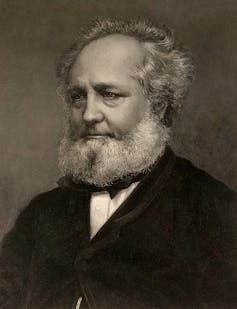
The Fairfax family also became major shareholders in Colonial Sugar Refining Company (CSR). CSR was founded in Sydney in 1855 by Edward Knox, but it descended from the Australasian Sugar Company, established in 1842. The precise date on which the Fairfax family became sugar investors is not known, but the family was certainly involved by 1855, when John Fairfax’s daughter, Emily, married the general manager of CSR.
In the 1870s and 1880s, CSR expanded into milling cane in Queensland and Fiji. It profited from the use of what was effectively slave labour through the abduction and importation of tens of thousands of South Sea Islanders, who were disparagingly called “Kanakas” (a Hawaiian word meaning “man”).
According to the Australian Human Rights Commission, between 1863 and 1904, “an estimated 55,000 to 62,500 Islanders were brought to Australia to labour on sugar-cane and cotton farms in Queensland and northern New South Wales”. They were forced to perform backbreaking labour in appalling conditions.
Most came from Vanuatu and Solomon Islands, but they also arrived from more than 70 other Pacific Islands. CSR chartered ships for the express purpose of “recruiting” labourers from these islands. Men, women and children, some as young as nine, were forced, coerced or tricked into coming to Australia. The practice of kidnapping them was known as “blackbirding” (“blackbird” was another word for slave).
Although a system of indentured labour was later established, Pacific Islanders were still exploited, denied basic rights, and paid miserable wages. In 1901, two acts of parliament facilitated their mass deportation as part of establishing the White Australia Policy.
Although the Sydney Morning Herald was normally a strong supporter of the White Australia Policy, the paper wanted it suspended in the case of the cane fields. In August 1901, it argued there was a special need for “black” labour in the sugar fields of Queensland because the task was not suitable for white men.
The Sydney Morning Herald wrote:
The sun, so deadly to the white man, is to (the ‘kanaka’) only the source of a genial warmth […] these islanders are (like) the Australian aborigine (sic) […] just sufficiently intelligent for work in the canefield […] cheap, and […] inured to outdoor labour in a tropical climate.
The paper argued that “white men” were still getting “all the work calling for intelligence”. And, if the “kanakas” had to go, then the sugar planter should be given some other form of help such as a duty on sugar. At no stage did the paper declare its owners’ interest in the issue.

Like the mining giant Broken Hill Proprietary (BHP), CSR became a powerful monopoly in Australia. Both were helped along by friends in the press, newspaper owners who were heavily invested in companies they were promoting and demanding government assistance for. (Aside from CSR, the Fairfaxes were also shareholders in BHP, as were other newspaper families, including the Symes and the Baillieus).
Although most Pacific Island labourers had been deported from Australia by 1908, CSR continued to prosper off the back of indentured (mostly Indian) labourers in Fiji, where there were severe working conditions and high mortality rates. By 1910, CSR was one of the three largest companies in Australia.
In 1915, the federal government granted CSR protection via an embargo on imported sugar. In 1923, the Queensland state government signed an agreement with CSR that meant the company effectively had a monopoly on sugar production (which lasted until 1989).
By 1930, CSR was the wealthiest company in Australia and the Fairfaxes were among the country’s wealthiest families. The family’s links with CSR were still active in the 1960s. By then, CSR had branched out into industrial chemicals, building materials and, disastrously, asbestos.
The longstanding connection between CSR and the Fairfaxes was not widely known in the mid 20th century, and nor would it have attracted much interest, then, let alone condemnation on the basis of CSR’s history of forced labour.
On the contrary, in a newspaper industry filled with ruthless proprietors, including liars, thugs and crooks, the Fairfaxes had a reputation for being decent, moral and ethical. They were known for being cultured, civically-minded and philanthropic.
The Fairfaxes controlled the Sydney Morning Herald for 149 years, until 1990 when a misguided takeover action mounted by young Warwick Fairfax ended in financial disaster.
Since 2019, the Sydney Morning Herald (along with The Age and The Australian Financial Review) have been owned by the Nine group, a television company that was founded by the Fairfaxes’ nemesis, Frank Packer, a rival newspaper and magazine owner in Sydney. Packer was not known for his philanthropy, nor for holding enlightened attitudes on racial equality.
Racism was often blatantly expressed in newspaper pages, encouraging oppression, discrimination and inhumane treatment to occur, including in the sugar plantations of Queensland. In 1935, the Sydney Morning Herald conceded that “blackbirding” – a practice it had implicitly supported in the 1890s and early 1900s – was actually a “type of slavery”. Now would be a good time for Australia’s oldest newspaper to follow the lead of the Guardian and investigate and acknowledge how its own growth in the 19th and 20th centuries was connected to that slavery.
Sally Young is the author of Paper Emperors (UNSW Press, 2019) and its sequel, Media Monsters: The Transformation of Australia’s Newspaper Empires (UNSW Press), which will be out in June. Comment was sought from the editor of the Sydney Morning Herald for this article but no reply was provided at the time of writing.![]()
Sally Young, Professor of Political Science, The University of Melbourne
This article is republished from The Conversation under a Creative Commons license. Read the original article.
Why do people crave the approval of an abusive or narcissistic parent? And what can they do about it?
Gery Karantzas, Deakin UniversityIn the phenomenally successful TV show Succession, wealthy media magnate Logan Roy (played by Brian Cox) is frequently cruel to his adult children. He insults them, pits them against each other and can be cold or menacing. Despite the years of torment, the Roy children clearly crave their father’s approval.
The show highlights a struggle some adult children face: the need for approval from an abusive parent.
Some would suggest the solution is simple: cut ties with the parent, limit contact, rid your life of this difficult relationship. But this is often not realistic.
Research into relationships can help us understand why some people desire the approval of a parent who is abusive, insensitive or inconsistent in their love – or who rate high on what’s known as “dark trait” tendencies (narcissism, psychopathy and Machiavellianism).
Attachment Anxiety
Studies into parent-child relationships based in attachment theory (a widely researched theory of human bonding) suggest the need for approval is a feature of people who experience an insecure attachment style known as attachment anxiety.
People experiencing attachment anxiety tend to crave relationship closeness, which includes obsessing over a parent or romantic partner, and can hold strong fears of being rejected or abandoned.
According to attachment theory, attachment anxiety can develop when the care provided by parents or guardians early in life is inept or inconsistent.
Inept Or Inconsistent Care
Inept care is when a parent provides some type of help, but the care provided does not meet the needs of the child.
For example, a child may need encouragement in achieving a challenging task. Instead, the parent provides sympathy and says the task is too hard for the child. The parent may even try to do the task for the child, which can make them feel helpless or even incompetent.
Inconsistent care is when the parent sometimes provides care that meets the child’s needs, triggering happiness or relief in the child. They feel seen, validated, and understood.
On other occasions, however, the parent may respond in ways that do not meet the child’s needs.
The parent may withdraw, avoid, or neglect the child in their time of need. On other occasions, the parent may blame the child for asking for help – or make them feel guilty by framing their request for help as a burden that affects the parent’s own well-being.
Parenting And The Dark Traits
Some believe these responses by parents are methods to manipulate their children to behave or feel a certain way. Research into the dark traits suggests those who score high on these qualities lack emotional warmth, act in hostile ways, and exert control over their children.
People with these tendencies have been shown to dehumanise others, even those closest to them. This can involve treating family and romantic partners as if they have no feelings, as if they are irrational, stupid, rigid like a robot, or as a means to an end.
Our own work has shown people can act this way because their own parents were hostile towards them some 20 years prior.
Intergenerational Transmission
For some parents, however, engaging in inept and inconsistent care is not driven by conscious motivations to manipulate and hurt their children.
Rather, they may not know how to parent differently. It may be that they too had parents who provided inept or inconsistent care.
Many of these parents have difficulties controlling their own distress when parenting their children. For some, their own worries and concerns become so intense they end up focusing on their own worries over those of their children.
This is an example of intergenerational transmission, where patterns of attachment and parenting can be passed from one generation to the next.
A ‘Partial Reinforcement Schedule’
Irrespective of the reason, the fallout of inept or inconsistent caregiving is that children are placed on what’s known as a partial reinforcement schedule.
This is where the child’s cries for help are sometimes attended to. They sometimes receive the love and support they require. But other times, the child experiences invalidation, neglect, or gets the message they are not understood or are harming their parent.
Because of this partial reinforcement schedule, children work harder to gain the attention and love of their parents. The child might think: “If I try that little harder to get their attention and approval, they’ll see what I really need, and they’ll provide me with the love, comfort, acknowledgement I desire”.
How Can We Break The Spell?
The need for approval is powerful for good reason, rooted in a long relationship history with our caregivers. Addressing this need often requires psychological intervention.
Therapies with a strong relational focus can be especially useful in working through issues such as a chronic need for approval. Such therapies include interpersonal therapy and schema therapy.
Schema therapy aims to help people understand why they have such a strong need for approval.
It uses cognitive, behavioural and emotion-focused strategies to help increase a person’s tolerance of disapproval. It might involve helping someone develop a better sense of their own identity, or use imagery techniques and affirmations to help clients validate themselves rather than seeking approval from an insensitive parent.
For people facing these struggles with a parent, try to identify when your need for approval is triggered, the emotions you feel, and what approval-seeking behaviours you engage in. It can help to write a pros and cons list about how the need for approval affects your life. Self-awareness can help lead to behaviour change.
It can also help to celebrate your own successes and identify your own skills and achievements. Doing so can provide you with evidence that challenges your need for approval from others. Developing self-compassion can also help.
Finally, positive affirmations can help challenge your own negative self-beliefs and increase your tendency to be self-approving. This can be as simple as writing down a series of truthful positive statements about yourself. You can refer to these statements when self-doubt creeps in, or when the need for approval of others becomes loud in your mind.
If this article has raised issues for you, or if you’re concerned about someone you know, call Lifeline on 13 11 14.![]()
Gery Karantzas, Professor in Social Psychology / Relationship Science, Deakin University
This article is republished from The Conversation under a Creative Commons license. Read the original article.
From radical to reactionary: the achievements and legacy of the influential artist John Olsen
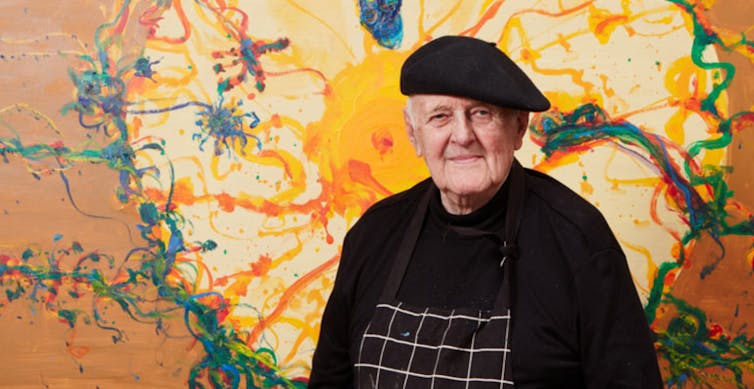
After media outlets breathlessly described the late John Olsen as a “genius”, I found myself humming The Chasers’ Eulogy Song.
This is perhaps a bit unfair, but the hyperbole surrounding Olsen’s death seems to have crowded out any assessment of his real and lasting achievements as an artist. There is a danger here.
Hyperbole invites a reaction, which is not always kind. It is still hard to have a dispassionate discussion on the merits (and otherwise) of Norman Lindsay, an artist often called a genius in his lifetime.

John Olsen And Australian Art
To understand Olsen, and his importance to Australian art, it is important to give some context. He emerged from that generation of Australians whose childhood was coloured by the deprivations of the second world war, and whose adolescent experience was of an expanding, changing Australia.
War meant that he finished school as a boarder at St Josephs Hunters Hill, while his father fought in the Middle East and New Guinea and his mother and sister moved to Yass in rural New South Wales.
His ability to draw meant that he escaped the tedium of a clerical job by becoming a freelance cartoonist while moving between a number of different art schools, including Julian Ashtons, Dattilo Rubio, East Sydney Tech and Desiderius Orban’s studio. As with other young artists of his generation, he was especially influenced by the experimental approach and intellectual rigour of John Passmore.
He found visual stimulation in Carl Plate’s Notanda Gallery in Rowe Street, a rare source of information on modern art at the time. Rowe Street was the creative hub for many artists, writers and serious drinkers who later became known as “The Push”. The informal exposure to new ideas on art, literature, food, wine and great conversation was more effective than a university. He learned about Kandinsky, Klee, the beauty of a wandering line, the poetry of Dylan Thomas and T.S. Eliot.
Olsen’s first media exposure was as the spokesman for art students protesting at the rigid conservatism of the trustees judging the Archibald Prize. There were no complaints about the Wynne Prize, which had exhibited his work.

The ‘First’ Australian Exhibition Of Abstract Expressionism
The friendship between Olsen and fellow artists William Rose, Robert Klippel, Eric Smith and their mentor John Passmore, led to the exhibition Direction 1 in December 1956.
An art critic’s over enthusiasm led to it being proclaimed as the first Australian exhibition of Abstract Expressionism, and its artists as pioneers of modern art. As a consequence, Robert Shaw, a private collector, paid for Olsen to travel and study in Europe. This was a transformational gift, coming at a time before Australia Council Grants, when travel was expensive.
He travelled first to Paris, then Spain where he based himself in Majorca and supported himself by working as an apprentice chef. The fluid approach to learning he had acquired in Sydney was enhanced in Spain. He saw, and appreciated the Tachiste artists, but took his own path, remembering always Paul Klee’s dictum that a drawing is “taking a line for a walk”.

That Spanish experience was distilled in the exuberant works he painted after his return to Sydney in 1960. Spanish Encounter paid tribute to the impact of this culture that continued to intrigue him, its energy and its apparent irrationality.
But he also found himself enjoying the “honest vulgarity” he found in the Australian ethos, leading to a series of paintings which incorporated the words you beaut country in their title. Olsen’s confident paintings of the 1960s easily place him as the most influential Australian artist of that decade.

Five Bells And Landscape
In 1972, Olsen was commissioned to paint a giant mural for the foyer of the concert hall at the Sydney Opera House. Salute to Five Bells takes its name from Kenneth Slessor’s poem of death on the Harbour, but is more about elements of subterranean harbour life.
The heroic scale of the work meant that he worked with a number of assistants to paint the dominant blue ground. When the mural was unveiled in 1973, it received a mixed response. It was too muted in tone to cope with the Opera House lighting, too sparse in content, too decorative.
In the following years, Olsen turned towards painting the Australian landscape and the creatures that inhabited it. In 1974, he visited Lake Eyre as the once dry giant salt lake flooded to fill with abundant life. He made paintings, drawings and prints of the abundance – both intimate views and overviews from flying over. Lake Eyre and its environs was to be a recurring motif in the art of his later years.
While these works were commercially successful, and many were acquired by public galleries, Olsen was no longer seen as being in the avant garde. He was, however, very much a part of the art establishment and his art was widely collected.

A Man Of His Generation
The aerial perspective of many of his later decorative paintings could seem to have echoes of Aboriginal art. Indeed, when the young Abdul Abdullah first saw Olsen’s paintings in 2009 he at first assumed Olsen was an Aboriginal artist.
It was therefore a surprise to many when in 2017 Olsen mounted a trenchant attack on the Wynne Prize after it was awarded to Betty Kunitiwa Pumani for Antara, a painting of her mother’s country.
Despite some visual similarities to his own approach to landscape he claimed her painting existed in “a cloud cuckoo land”. In the same interview, he attacked Mitch Cairns’ Archibald-winning portrait of his wife, Agatha Gothe-Snape, as “just so bad”.
While it is not unusual for the radical young to become enthusiastic reactionaries in prosperous old age, there was a particular lack of grace in Olsen’s response to artists who were not a part of his social circle or cultural background. He was in this very much a man of his generation, with attitudes and prejudices that reflect the years of his youth.
Looking at Olsen’s paintings of the 1950s and ‘60s is a reminder that there was a time in Australia when brash young men could prove their intellectual credentials by quoting Dylan Thomas while making a glorious multi-coloured paella in paint.![]()
Joanna Mendelssohn, Honorary (Senior Fellow) School of Culture and Communication University of Melbourne. Editor in Chief, Design and Art of Australia Online, The University of Melbourne
This article is republished from The Conversation under a Creative Commons license. Read the original article.
The first Asian screenwriter in Hollywood’s 1920s ‘dream factory,’ Winnifred Eaton, challenged its racism
Mary Chapman, University of British Columbia and Sydney Lines, University of British ColumbiaA century before Michelle Yeoh became the first Asian woman to win an Oscar for Best Actress, the daughter of a Chinese mother and a white English father, Winnifred Eaton, was working behind the scenes in Hollywood.
Winnifred Eaton, often credited in Hollywood as Winnifred Reeve, was born in Montréal in 1875. She wrote and adapted scores of screenplays for MGM and Universal Studios, where she was literary advisor and editor-in-chief from 1925 to 1930.
Eaton was the first Asian screenwriter in Hollywood, and the first Asian — and first woman — to head a Hollywood script department.
Together with a team of scholars, including Joey Takeda and Jean Lee Cole, we are digitizing Eaton’s surviving screenplays so that her role in Hollywood, and the tradition of Asians in Hollywood, from Eaton to Yeoh, can be better understood.
Eaton was an advocate for more sympathetic depictions of women, the working classes and some racialized people, but also complicit in her era’s racism and sexism. That her efforts to hold space for Asian characters and themes were ultimately rejected by Hollywood speaks volumes about its refusal to accept Asians in its Golden Age.
Early Career
Eaton’s mother, Achuen Amoy, was born in China, and, as our research has uncovered, toured the world as a child apprentice to a Chinese acrobatic troupe. After returning to China, she met and married English silk importer Edward Eaton. The Eatons lived in England and New York before settling in Montréal.
Soon after Canada introduced the Chinese Head Tax in 1885, Eaton’s sister Edith Eaton began to publish sympathetic fictional and journalistic portraits of North American Chinatowns under the pen name “Sui Sin Far.”
Winnifred Eaton, however, began her career as an author at the height of the western popularization of Japanese art and design in a context of orientalism and racism. She published bestselling novels under the faux-Japanese pen-name “Onoto Watanna,” a problematic persona she assumed in 1896 and later came to regret.
Eaton’s second novel A Japanese Nightingale (1901) was an immediate bestseller, translated into several languages, and made into a film in 1918.
Screenwriting Success
Yet Eaton was much more than the author of formulaic Japanese romances. Like many early 20th-century novelists and playwrights, Eaton recognized the movie industry desperately needed writers with an ear for dialogue as it moved from its silent era into the “talkies.”
It also needed writers with perspectives on what were seen as exotic locales, the sites of cultural collision and exchange that were at the heart of the early “dream factory.”
As performing arts scholar Vito Adriaensens has uncovered, Eaton optioned her first story to the Selig Polyscope Company in 1914.
Later that decade, Eaton won a screenwriting contest. Writing as Winifred Reeve, she earned her first screenwriting credit for the 1921 Universal feature False Kisses. By the early 1920s, Eaton had moved with her second husband to Alberta where she continued to write.
Credited On Only Five Films
During this period, Eaton wrote scores of scripts, including several for starlets Mary Philbin and Mary Nolan.
Universal Studios referred to Eaton as “an instrument of salvage” who could go into its “morgues” and “garb” abandoned scripts in “modern screen attire.”
However, in the collaborative world of Hollywood, where much writing labour remains invisible, Eaton received screenwriting credit for only five films.
Many of the films we know she worked on, for example Shanghai Lady, East is West, Barbary Coast and Borneo, featured Asian characters, but these were played by white actors in yellowface.
Censored Scripts
Eaton’s depictions of race and gender often aligned with the outdated standards of the time. That said, as literature scholar Jean Lee Cole has argued, multiple drafts of screenplays reveal Eaton’s efforts to create sympathetic racialized characters, particularly women, and to depict interracial relationships.
However, these efforts were often rejected or written out by later screenwriters and editors, or censored by 1930s production codes.
Cole compared scripts in Eaton’s papers with their final filmed versions and noted how other writers and producers revised Eaton’s scripts to conform to existing “film formulas that reified male dominance, class hierarchies, and racial purity.”
Upon seeing the revised script for Barbary Coast, Eaton wrote “I really feel sick … I feel as if I don’t want my name on this.”
Brilliant Novel ‘Cattle’ Critiqued Colonialism
Eaton’s film treatment for her brilliant 1923 novel Cattle made a daring critique of the violence, racism and sexism undergirding settler colonialism.
In Eaton’s story, a rancher steals cattle from local Indigenous communities and unleashes violence on his illegitimate Stoney Nakoda son and rapes his housemaid. A Chinese cook achieves justice when he loosens the gates so his abusive boss’s starving cattle can run free, and one of them gores the rancher to death.
However, in a revision of Eaton’s treatment, another writer eliminated the cook’s role. Paramount then scuttled the project because of the story’s sympathetic portrayal of a mother raising her illegitimate child. A film of Cattle was never made.
Hollywood Ambivalence

As Everything Everywhere All at Once actor James Hong recalled, early Hollywood was not a welcoming place for Asian actors and writers, despite its fascination with Asian settings and topics. If Asian actors were given roles, these were often as villains or in other stereotyped racialized roles.
Chinese American actress Anna May Wong (1905-1961) played Indigenous characters in The Alaskan (1924) and Peter Pan (1924).

As Sessue Hayakawa (1886-1973), the first big-screen heartthrob or sex symbol and first Japanese actor nominated for an Oscar, told Eaton in an 1929 interview, he “did not like the stories [he] was required to play.” He also told Eaton he left Hollywood in 1922 in protest because he had been called a racial slur.
The Hays Code, introduced in 1930, made things worse for actors of Asian backgrounds when it forbade featuring non-white actors in romantic on-screen relationships with white actors.
New Edition Of ‘Cattle’
Eaton left Hollywood in 1931. While she continued to write screenplays, there is no evidence any of her later scripts were produced.
This July, scholars will gather in Calgary, Alta., with Eaton’s descendants including biographer Diana Birchall for a conference open to the public to discuss Eaton’s career and to launch a new edition of Cattle on the centenary of its publication.![]()
Mary Chapman, Professor of English and Academic Director of the Public Humanities Hub, University of British Columbia and Sydney Lines, Public Scholar and PhD Candidate in English Language and Literatures, University of British Columbia
This article is republished from The Conversation under a Creative Commons license. Read the original article.
Will AI ever reach human-level intelligence? We asked 5 experts

Artificial intelligence has changed form in recent years.
What started in the public eye as a burgeoning field with promising (yet largely benign) applications, has snowballed into a more than US$100 billion industry where the heavy hitters – Microsoft, Google and OpenAI, to name a few – seem intent on out-competing one another.
The result has been increasingly sophisticated large language models, often released in haste and without adequate testing and oversight.
These models can do much of what a human can, and in many cases do it better. They can beat us at advanced strategy games, generate incredible art, diagnose cancers and compose music.
There’s no doubt AI systems appear to be “intelligent” to some extent. But could they ever be as intelligent as humans?
There’s a term for this: artificial general intelligence (AGI). Although it’s a broad concept, for simplicity you can think of AGI as the point at which AI acquires human-like generalised cognitive capabilities. In other words, it’s the point where AI can tackle any intellectual task a human can.
AGI isn’t here yet; current AI models are held back by a lack of certain human traits such as true creativity and emotional awareness.
We asked five experts if they think AI will ever reach AGI, and five out of five said yes.

But there are subtle differences in how they approach the question. From their responses, more questions emerge. When might we achieve AGI? Will it go on to surpass humans? And what constitutes “intelligence”, anyway?
Here are their detailed responses:
![]()
Noor Gillani, Technology Editor, The Conversation
This article is republished from The Conversation under a Creative Commons license. Read the original article.
From platypus to parsecs and milliCrab: why do astronomers use such weird units?

You may have heard about an asteroid set to fly near Earth that is the size of 18 platypus, or maybe the one that’s the size of 33 armadillos, or even one the size of 22 tuna fish.
These outlandish comparisons are the invention of Jerusalem Post journalist Aaron Reich (who bills himself as “creator of the giraffe metric”), but real astronomers sometimes measure celestial objects with units that are just as strange.
The idea of a planet that’s 85% the mass of Earth seems straightforward. But what about a pulsar-wind nebula with a brightness of a few milliCrab? That’s where things get weird.
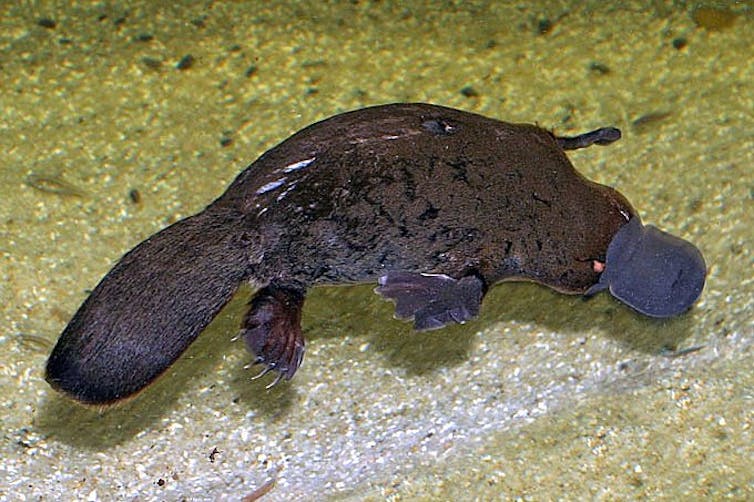
Why Do Astronomers Use Such Strange Units?
The basic problem is that lots of things in space are way too big for our familiar units.
Take my whippet Astro, who is 94cm long. Earth’s radius is about 638 million cm, or 7.5 million Astros.
Jupiter’s radius is 11.2 Earths, or 85 million Astros. That number of Astros is a bit ridiculous, which is why we adjust our unit choice to one that makes more sense.
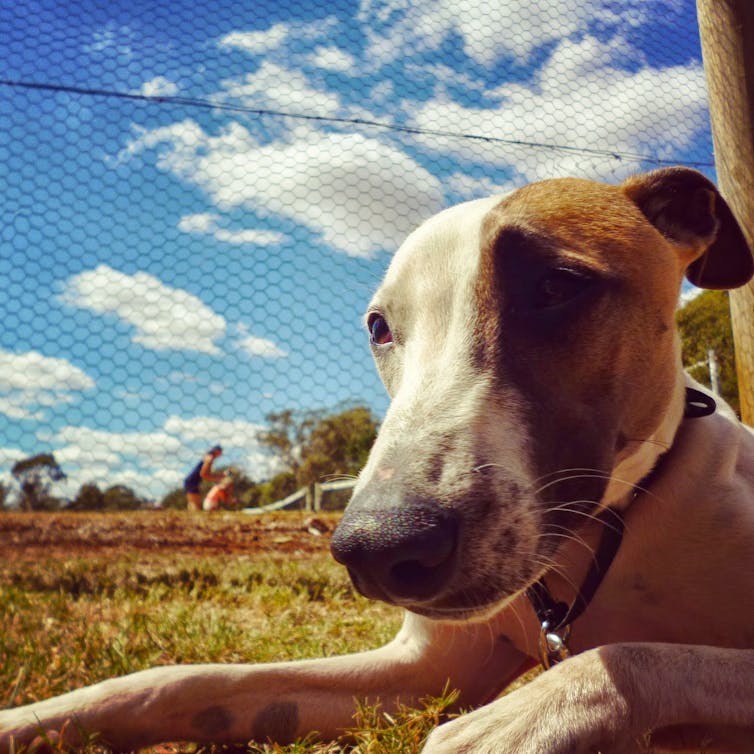
At an even larger scale, consider the star Betelguese: its radius is 83,000 Earths, or 764 times the radius of the Sun. So if we want to talk about how big Betelgeuse is, it’s much more convenient to use the radius of the Sun as our unit, instead of the radius of Earth (or to describe it as 632 billion Astros).
Heavy Stuff
If we want to measure how heavy an asteroid is, we could do it with camels – but in space we’re more interested in mass than in weight. Mass is a measure of how much stuff something is made of.
On Earth the weight of an object, like Astro, depends on the mass of Astro and the gravitational force pulling him down to the ground.
We can think of weight in terms of how hard it is to lift an 18kg Astro off the ground. This would be easy to do on Earth, even easier somewhere with lower gravity like the Moon, and much harder somewhere with higher gravity like Jupiter.
On the other hand, Astro’s mass is how much stuff he’s made of – and it’s the same no matter which planet he’s on.
Astronomers use Earth and the Sun as handy units to measure mass. For example, the Andromeda galaxy is approximately three trillion times the mass of the Sun (or 3×1041 – that’s a 3 followed by 41 zeros – Astros).
Astronomical Units And Parsecs
Astronomers also use comparisons to measure how far apart things are. The Sun and Earth are 149 million kilometres apart, and we give this distance a name: an astronomical unit (AU).
For an even twistier unit of distance, we use the parsec (insert Han Solo Kessel run joke here). Parsec is short for “parallax second”, and if you remember your trigonometry, this is the length of the hypotenuse of a right-angle triangle when the angle is 1 arcsecond (1/3,600 degrees) and the “opposite” side of the triangle is 1 AU.
Parsecs are handy for measuring even bigger distances because 1 parsec = 206,265 AU. For example, the centre of our very own galaxy, the Milky Way, is about 8,000 parsecs away from Earth, or 1.6 million AU.
Magnitudes
If we want to measure how bright something is, astronomical units of measurement get even weirder. In the second century BC, the ancient Greek astronomer Hipparchus looked up at space and gave the brightest stars a value of 1 and the faintest stars a value of 6.
Notice here that a brighter star has a lower number. We call these brightness values “magnitudes”. The Sun has an apparent magnitude of –26!
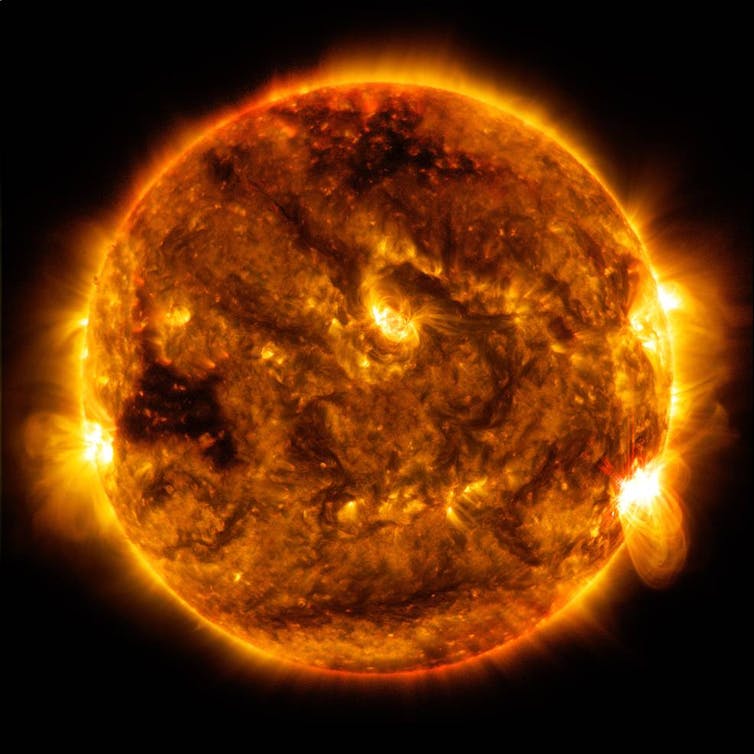
Even more confusing than a negative brightness, each single step in magnitude is a 2.512 times difference in brightness. The star Vega has an apparent magnitude of 0, which is two and a bit times brighter than the star Antares with an apparent magnitude of 1.
At Last, The MilliCrab
The light we see with our eyes is, for obvious reasons, called “visible” light. The light we use to take pictures of your bones is called X-ray light.
When astronomers use X-ray light to observe the sky we sometimes measure brightness in “Crabs”.
The Crab is a rapidly spinning neutron star (or pulsar) in the remains of an exploded star that is extremely bright when we look at it using our X-ray telescopes. It’s so bright in X-ray light that astronomers have been using it to calibrate their telescopes since the 1970s.

So every X-ray astronomer knows how bright a Crab is. And if we’re talking about a particular object, say a black hole binary system called GX339-4, and it’s only five thousandths as bright as the Crab, we say it’s 5 milliCrab bright.
But buyer beware! The brightness of the Crab is different depending on what energy of X-ray light you’re looking at, and it also changes over time.
Whether we use lions or tigers or Crabs, astronomers make sure to define the units we’re using. There’s no use using an armadillo, or even your local whippet, unless you’ve made sure the definition is clear.![]()
Laura Nicole Driessen, Postdoctoral researcher in radio astronomy, University of Sydney
This article is republished from The Conversation under a Creative Commons license. Read the original article.
Bank Branch Closures Spark Senate Inquiry And Regulator Review
Research Reveals Older Australians’ Mental Health Hit Hard By Pandemic
- Older women were more likely than older men to report their mental health worsened during the Pandemic, fluctuated regularly, or they experienced mental ill health for the first time.
- 14 per cent of respondents reported their mental health worsened during the pandemic period.
- 15 per cent said their mental health fluctuated regularly.
- Loneliness and distress arising from social isolation and separation from friends and family were identified as the key impacts.
- Even those who considered themselves unaffected by the pandemic described themselves as living with ‘worry’ and ‘stress,’ of experiencing sadness, loss, lack of sleep and appetite, of distress.
- 20% of those who reported their mental health suffered said they had no one to talk to during periods of lockdowns.
- 8% of those who reported their mental health suffered said they couldn’t get the help they needed.
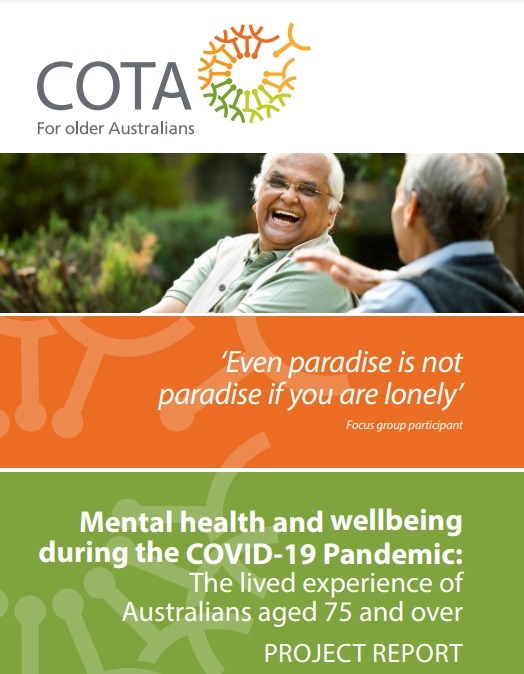
Aged Care Worker Shortage — The Solution Is Simple: National Seniors
- Meets the growing shortfall for home care workers.
- Encourages people to work in home care.
- Provides greater income and superannuation for older people, particularly women.
- Provides care recipients with access to mature and sympathetic workers—as is their preference.
How Music Can Prevent Cognitive Decline
Professor Brendan Murphy AC Retirement
People Who Think Positively About Aging Are More Likely To Recover Memory
Mitochondria Power-Supply Failure May Cause Age-Related Cognitive Impairment
Research on 2,400 languages shows nearly half the world’s language diversity is at risk

There are more than 7,000 languages in the world, and their grammar can vary a lot. Linguists are interested in these differences because of what they tell us about our history, our cognitive abilities and what it means to be human.
But this great diversity is threatened as more and more languages aren’t taught to children and fall into slumber.
In a new paper published in Science Advances, we’ve launched an extensive database of language grammars called Grambank. With this resource, we can answer many research questions about language and see how much grammatical diversity we may lose if the crisis isn’t stopped.
Our findings are alarming: we’re losing languages, we’re losing language diversity, and unless we do something, these windows into our collective history will close.
What Is Grammar?
The grammar of a language is the set of rules that determines what a sentence is in that language, and what is gibberish. For example, tense is obligatory in English. To combine “Sarah”, “write” and “paper” into a well-formed sentence, I have to indicate a time. If you don’t have tense in an English sentence, then it’s not grammatical.
That’s not the case in all languages though. In the indigenous language of Hokkaido Ainu in Japan, speakers don’t need to specify time at all. They can add words such as “already” or “tomorrow” – but speakers consider the sentence correct without them.
As the great anthropologist Franz Boas once said:
grammar […] determines those aspects of each experience that must be expressed.
Linguists aren’t interested in “correct” grammar. We know grammar changes over time and from place to place – and that variation isn’t a bad thing to us, it’s amazing!
By studying these rules across languages, we can get an insight into how our minds work, and how we transfer meaning from ourselves to others. We can also learn about our history, where we come from, and how we got here. It’s rather extraordinary.
A Huge Linguistic Database Of Grammar
We’re thrilled to release Grambank into the world. Our team of international colleagues built it over several years by reading many books about language rules, and speaking to experts and community members about specific languages.
It was a difficult task. Grammars of different languages can be very different from each other. Moreover, different people have different ways of describing how these rules work. Linguists love jargon, so it was a special challenge to understand them sometimes.

In Grambank, we used 195 questions to compare more than 2,400 languages – including two signed languages. The map below provides an overview of what we have captured.
Each dot represents a language, and the more similar the colour, the more similar the languages. To create this map, we used a technique called “principal component analysis” – it reduced the 195 questions to three dimensions, which we then mapped onto red, green and blue.
The large variation in colours reveals how different all these languages are from each other. Where we get regions with similar colours, such as in the Pacific, this could mean the languages are related, or that they have borrowed a lot from each other.
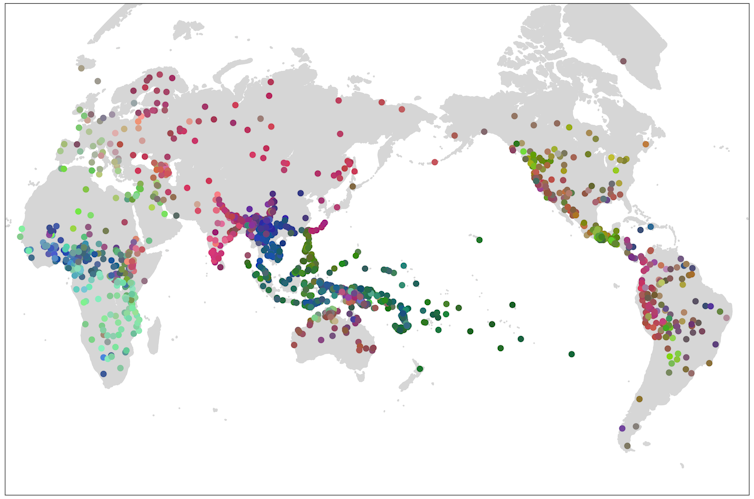
Language is very special to humans; it’s part of what makes us who we are.
Sadly, the world’s indigenous languages are facing an endangerment crisis due to colonisation and globalisation. We know each language lost heavily impacts the health of Indigenous individuals and communities by severing ties to ancestry and traditional knowledge.
Almost Half The World’s Linguistic Diversity Is Threatened
In addition to the loss of individual languages, our team wanted to understand what we stand to lose in terms of grammatical diversity.
The Grambank database reveals a dazzling variety of languages around the world – a testament to the human capacity for change, variation and ingenuity.
Using an ecological measure of diversity, we assessed what kind of loss we could expect if languages that are currently under threat were to disappear. We found certain regions will be hit harder than others.
Frighteningly, some regions of the world such as South America and Australia are expected to lose all of their indigenous linguistic diversity, because all of the indigenous languages there are threatened. Even other regions where languages are relatively safe, such as the Pacific, South-East Asia and Europe, still show a dramatic decrease of about 25%.
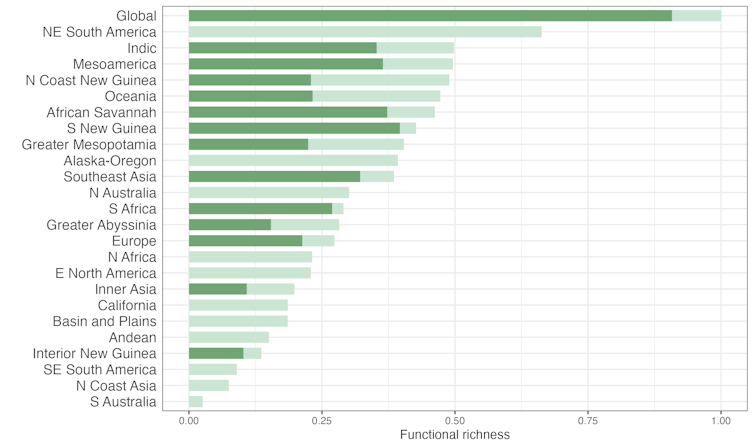
What’s Next?
Without sustained support for language revitalisation, many people will be harmed and our shared linguistic window into human history, cognition and culture will become seriously fragmented.
The United Nations declared 2022–2032 the Decade of Indigenous Languages. Around the world, grassroots organisations including the Ngukurr Language Centre, Noongar Boodjar Language Centre, and the Canadian Heiltsuk Cultural Education Centre are working towards language maintenance and revitalisation. To get a feel for what this can be like, check out this interactive animation by Angelina Joshua.![]()
Hedvig Skirgård, Postdoctoral researcher, Australian National University and Simon Greenhill, Associate Professor, University of Auckland
This article is republished from The Conversation under a Creative Commons license. Read the original article.
A newly uncovered ancient Roman winery featured marble tiling, fountains of grape juice and an extreme sense of luxury

Recent excavations at the Villa of the Quintilii uncovered the remains of a unique winery just outside Rome.
The mid-third-century CE building located along the Via Appia Antica portrays a sense of opulence and performance almost never found at an ancient production site.
This exciting complex illustrates how elite Romans fused utilitarian function with luxurious decoration and theatre to fashion their social and political status.
I was one of the specialist archaeologists to study this newly excavated site. The details of this discovery are outlined in our new article in Antiquity.
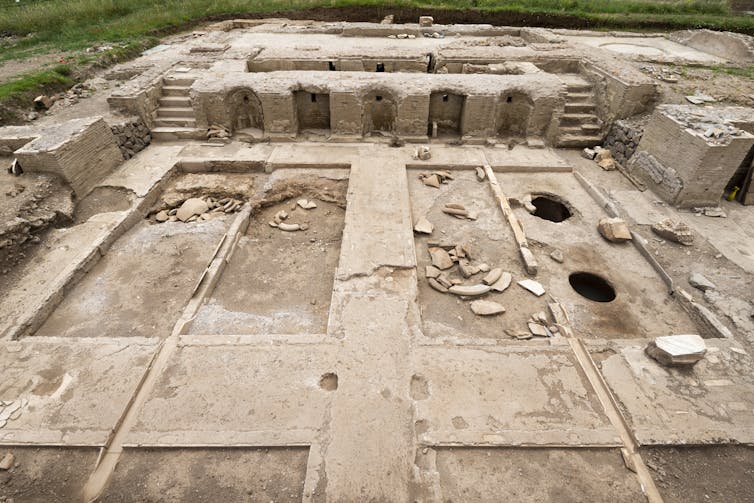
The Villa Of The Quintilii
From names stamped on a lead water pipe, we know the 24 hectare ancient Roman villa complex was owned by the wealthy Quintilii brothers, who served as consuls in 151 CE.

The Roman emperor Commodus had the brothers killed in 182/3 CE.
He took possession of their properties, including this villa, initiating long-term imperial ownership.
The site has been long known for its decorative architecture, including coloured marble tiling, high-quality statuary recovered over the last 400 years, and a monumental bathing complex.
Less known is an enormous circus for chariot racing built during the reign of Commodus.
From 2017-18, during an attempt to discover the starting gates of the circus, the first traces of a unique winery were revealed.
A Luxury Roman Imperial Winery
This large complex was built on top of the circus starting gates, which dates it after the reign of Commodus.
The complex possesses features commonly found in ancient Roman wineries: a grape treading area, two wine presses, a vat to collect grape must (the juice of the grapes along with their skins, seeds and stems) and a cellar with large clay jars for storage and fermentation sunk into the ground.
However, the decoration and arrangement of these features is almost completely unparalleled in the ancient world.

Nearly all the production areas are clad in marble veneer tiling. Even the treading area, normally coated in waterproof cocciopesto plaster, is covered in red breccia marble. This luxurious material, combined with its impracticalities (it is very slippery when wet, unlike plaster), conveys the extreme sense of luxury.

Two immense mechanical lever presses sit either side of the treading area to press the already trodden grape pulp.
The size and scale of these presses working up and down in harmony would have contributed to the theatre of the production process.
The grape juice produced from treading and pressing flowed from these areas into a long rectangular vat, where an impression from a stamp named the short-reigning emperor Gordian (deposed 244 CE). This confirms a date of construction or renovation.
But it is here the real performance would have begun.
The liquid grape must poured like a striking fountain out of the vat and through a facade around one metre in height that closely resembles a Roman nymphaeum (a monumental decorated fountain).
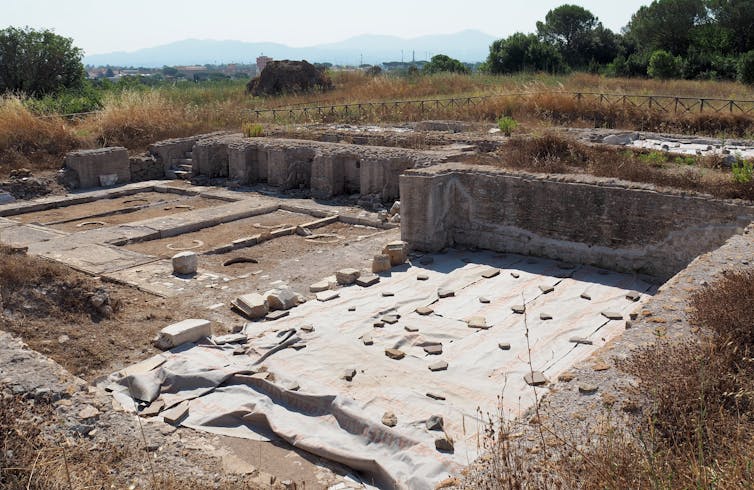
While must flowed out of the three central niches, water flowed out of those on either end and was then channelled back underground through a system of lead pipes.
This niched facade was originally clad in a decorative veneer of brightly coloured white, black, grey and red marble. Some pieces remain attached and more were found loose in the excavated layers.

A system of thin open white marble channels conveyed the grape must from the facade into an open-air cellar area.
Here it was fed into 16 buried clay jars (dolia defossa) large enough for a person to fit inside. The remains of eight were uncovered during excavations.
Three rooms paved in opulent geometric marble tiling, like those found in other areas of the villa, were arranged around the cellar.
We might imagine the emperor and his retinue reclining, eating and watching the spectacle of production and tasting freshly pressed must.

Theatrical Vintage Ritual In Ancient Italy
The only other example like this facility can be found at Villa Magna, 50 kilometres to the south-east near Anagni.
This similarly opulent marble-clad winery was in use just before the Villa of the Quintilii, from the early second to early third century CE, with an area for dining that enabled a view of the production spaces.
In Marcus Aurelius’ letters to his tutor Fronto, we are given a rare glimpse into the activities of Villa Magna around 140-145 CE. He describes the imperial party banqueting while watching and listening to the workers treading grapes.

It is likely this formed part of a vintage ritual, tied to the ceremonial opening of the harvest. Perhaps this ritual also occurred at the slightly later Villa of the Quintilii facility.
Lavish marble-clad spaces marked areas fit for the imperial party and the winery was the “theatre” for this sacred performance.
One tantalising question remains unanswered: was the Roman emperor’s spectacular, ritual winery moved in the early third century CE from Villa Magna to the Villa of the Quintilii?
![]()
Emlyn Dodd, Lecturer in Classical Studies, Institute of Classical Studies, University of London; Assistant Director of Archaeology, British School at Rome; Honorary Postdoctoral Fellow, Macquarie University, Macquarie University
This article is republished from The Conversation under a Creative Commons license. Read the original article.
Why focusing on COVID deaths undercounts the health harms of the pandemic – new research

More than three years into the COVID pandemic, both the virus and the measures taken to control its spread have affected people’s lives across the globe. But how can we fully quantify these effects?
While we have estimates of how many people have died from COVID globally (which currently run at just under 7 million), its broader effects – including mental health deterioration due, for example, to the anxiety of getting infected or the isolation of lockdowns – have received less research attention.
In a new study we’ve attempted to quantify how the COVID pandemic has affected global health using an international survey of the general public.
Health economists often quantify health using a metric known as the quality-adjusted life year (QALY). The idea is to assign a value to each year of a person’s life based on their overall health. A person in full health gets a score of one and those who are very ill close to zero.
A common way to measure QALYs is through a brief survey called the EQ-5D, which involves five questions covering key dimensions of health. A person rates their levels of mobility, self care, usual activities, pain and discomfort, and anxiety and depression.
The responses provide a profile of the person’s health-related quality of life, which is summarised by what’s known as the EQ-5D index. When measured at different points in time this can be used to estimate QALYs, which adjust life expectancy to take account of overall health.
For example, a person in relatively poor health may have an EQ-5D index of 0.5 and so they would accumulate one QALY for every two years they live. This technique has been widely used to evaluate the impacts of different diseases and treatments on health.
We measured overall health-related quality of life by including the EQ-5D in a global survey of the public in late 2020, at the end of the first year of the pandemic, just before COVID vaccines started to be distributed. The survey was conducted online on just over 15,000 people in 13 diverse countries.
To ascertain how people thought the pandemic had affected them, we asked them to rate their current health compared with a year before.
One limitation of our study is that we had to rely on people being able to recall what their health was like prior to the pandemic. While it’s unlikely that a person is able to recall exactly how they would have responded to the survey a year in the past, there is evidence that over and under-estimation errors tend to cancel each other out.
What We Found
The pandemic was associated with significantly worse health-related quality of life for more than one-third of respondents. Anxiety and depression was the aspect of health that worsened the most, especially for younger people (aged under 35) and women.
Translating the health reductions into a QALY measure indicated that during the pandemic perceived health was around 8% lower on average.
Looking at the results by country, those most affected were middle income countries including India (which had lockdowns for over 40 weeks) and Chile (which had a high rate of COVID infections).
In contrast, participants in China notably reported no significant deterioration in their health status. Although there were lockdowns in China following the emergence of the virus in early 2020, low levels of transmission meant that these were removed within a few weeks.
Mean difference in overall health pre-COVID and in December 2020:
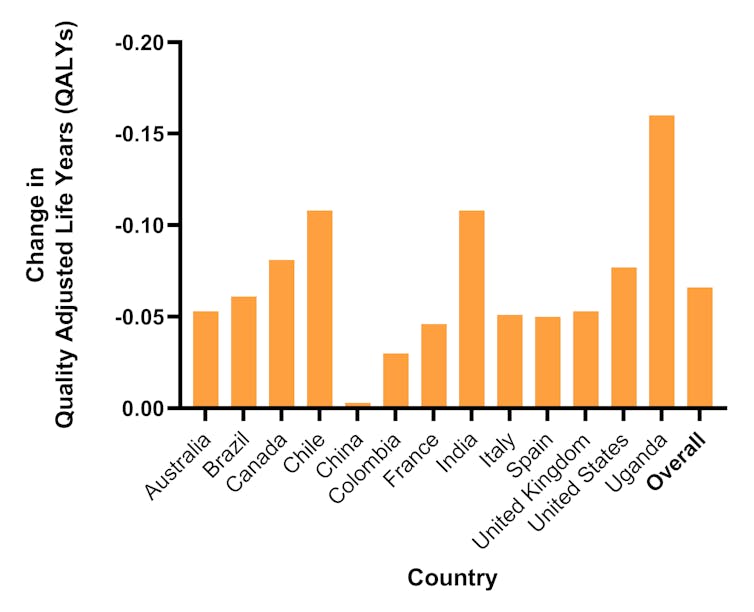
To put the results into context, previous studies have found that each COVID death results in the loss of an average of between three and six QALYs. We combined these estimates with the reported number of deaths in each country to quantify the impact of COVID deaths on overall QALYs in each country.
Based on the reported changes in health in our survey, the loss in QALYs due to the COVID pandemic and lockdowns was between five and 11 times larger than that due to COVID-related deaths. This highlights that only focusing on COVID cases and deaths overlooks the burden of the pandemic and the impacts of policies that are designed to control it.
For example, most countries used some form of lockdowns as a way to contain transmission of the virus, but the ensuing social isolation may have negatively affected the mental health and wellbeing of the population. Similarly, some countries offered economic support to those in financial difficulties, which may have positively impacted their mental wellbeing. QALYs provide a way of quantifying the trade-offs that exist between the positive and negative effects of different strategies.

Lessons For Future Pandemics
While individual countries have sought to measure the pandemic’s effects on overall wellbeing, the limited number of international studies looking at specific aspects of health, such as mental health, have tended to focus on high income countries. Most global analyses of the effects of the pandemic rely on reported COVID cases and related deaths.
The regular measurement of different aspects of health in a standardised survey enables researchers to start to disentangle the effects of lockdowns and other policies from the impacts of COVID.
Measuring multiple aspects of health through QALYs would also be a useful supplement to existing measures focusing on cases and deaths. This would enable us to look at some of the effects of the COVID pandemic as they’re distributed across the population. For example, while deaths are highest in older people, mental health effects were more prominent in those under 35.
Moving beyond counting deaths to understanding the overall health of the population globally can help us to be better prepared for potential future health shocks.![]()
Philip Clarke, Professor of Health Economics, University of Oxford; Jack Pollard, Researcher in Health Economics, University of Oxford, and Mara Violato, Associate Professor, Health Economics, University of Oxford
This article is republished from The Conversation under a Creative Commons license. Read the original article.
Research Sheds New Light On Self-Destructive Behaviour
Turning down the volume of pain – how to retrain your brain when you get sensitised

For every feeling we experience, there is a lot of complex biology going on underneath our skin.
Pain involves our whole body. When faced with possible threats, the feeling of pain develops in a split second and can help us to “detect and protect”. But over time, our nerve cells can become over-sensitised. This means they can react more strongly and easily to something that normally wouldn’t hurt or would hurt less. This is called “sensitisation”.
Sensitisation can affect anyone, but some people may be more prone to it than others due to possible genetic factors, environmental factors or previous experiences. Sensitisation can contribute to chronic pain conditions like fibromyalgia, irritable bowel syndrome, migraine or low back pain.
But it might be possible to retrain our brains to manage or even reduce pain.
‘Danger!’
Our body senses possible threats via nerve endings called nociceptors. We can think of these like a microphones transmitting the word “danger” through wires (nerves and the spinal cord) up to a speaker (the brain). If you sprain your ankle, a range of tiny chemical reactions start there.
When sensitisation happens in a sore body part, it’s like more microphones join in over a period of weeks or months. Now the messages can be transmitted up the wire more efficiently. The volume of the danger message gets turned way up.
Then, in the spinal cord, chemical reactions and the number of receptors there also adapt to this new demand. The more messages coming up, the more reactions triggered and the louder the messages sent on to the brain.
And sensitisation doesn’t always stop there. The brain can also crank the volume up by making use of more wires in the spinal cord that reach the speaker. This is one of the proposed mechanisms of central sensitisation. As time ticks on, a sensitised nervous system will create more and more feelings of pain, seemingly regardless of the amount of bodily damage at the initial site of pain.
When we are sensitised, we may experience pain that is out of proportion to the actual damage (hyperalgesia), pain that spreads to other areas of the body (referred pain), pain that lasts a long time (chronic or persistent pain), or pain triggered by harmless things like touch, pressure or temperature (allodynia).
Because pain is a biopsychosocial experience (biological and psychological and social), we may also feel other symptoms like fatigue, mood changes, sleep problems or difficulty concentrating.

Neuroplasticity
Around the clock, our bodies and brain are constantly changing and adapting. Neuroplasticity is when the brain changes in response to experiences, good or bad.
Pain science research suggests we may be able to retrain ourselves to improve wellbeing and take advantage of neuroplasticity. There are some promising approaches that target the mechanisms behind sensitisation and aim to reverse them.
One example is graded motor imagery. This technique uses mental and physical exercises like identifying left and right limbs, imagery and mirror box therapy. It has been tested for conditions like complex regional pain syndrome (a condition that causes severe pain and swelling in a limb after an injury or surgery) and in phantom limb pain after amputation. Very gradual exposure to increasing stimuli may be behind these positive effects on a sensitised nervous system. While results are promising, more research is needed to confirm its benefits and better understand how it works. The same possible mechanisms of graded exposure underpin some recently developed apps for sufferers.
Exercise can also retrain the nervous system. Regular physical activity can decrease the sensitivity of our nervous system by changing processes at a cellular level, seemingly re-calibrating danger message transmission. Importantly, exercise doesn’t have to be high intensity or involve going to the gym. Low-impact activities such as walking, swimming, or yoga can be effective in reducing nervous system sensitivity, possibly by providing new evidence of perceived safety.
Researchers are exploring whether learning about the science of pain and changing the way we think about it may foster self-management skills, like pacing activities and graded exposure to things that have been painful in the past. Understanding how pain is felt and why we feel it can help improve function, reduce fear and lower anxiety.
But Don’t Go It Alone
If you have chronic or severe pain that interferes with your daily life, you should consult a health professional like a doctor and/or a pain specialist who can diagnose your condition and prescribe appropriate active treatments.
In Australia, a range of multidisciplinary pain clinics offer physical therapies like exercise, psychological therapies like mindfulness and cognitive behavioural therapy. Experts can also help you make lifestyle changes to improve sleep and diet to manage and reduce pain. A multi-pronged approach makes the most sense given the complexity of the underlying biology.
Education could help develop pain literacy and healthy habits to prevent sensitisation, even from a young age. Resources, such as children’s books, videos, and board games, are being developed and tested to improve consumer and community understanding.
Pain is not a feeling anyone should have to suffer in silence or endure alone. ![]()
Joshua Pate, Senior Lecturer in Physiotherapy, University of Technology Sydney
This article is republished from The Conversation under a Creative Commons license. Read the original article.
Pregnant this winter? Here’s how to prepare for COVID and get vaccinated

With the days becoming noticeably shorter, winter is on its way in the Southern Hemisphere.
Most pregnant women are aware of the recommendations around getting vaccinated against influenza (flu) and pertussis (whooping cough). However, COVID is still relatively new, meaning women who have never been pregnant before may be unaware of the current recommendations and research.
Like the flu and whooping cough, COVID can strike at anytime over the course of the year – as shown by the ongoing reports of COVID cases and deaths in Australia.
However, viruses that cause respiratory conditions thrive in cold, dry conditions, and our bodies change how they respond to disease. We will likely stay indoors more in closed spaces that are heated – making the air drier – and not well ventilated.
It all makes for a worrying mix for expectant parents – and some will also be worried about vaccines.
1 In 10 Pregnant Women Are Vaccine Hesitant
We are following more than 6,000 Australian women in the Birth in the Time of COVID-19 study who were pregnant or gave birth during the first two years of the pandemic. We also sent them follow-up surveys at two months, six months, 12 months and 24 months after giving birth.
This sample included more respondents who could read and write English and were born in Australia than the general population and were generally more socioeconomically advantaged than average. So the real level of hesitancy about COVID vaccines may be higher.
Our latest findings reporting on 2,144 responses to questions on vaccine uptake, published in the journal BMJ Open show around one in ten pregnant women and just over one in 13 postnatal women were hesitant to get a COVID vaccination.
Those who expressed hesitancy during pregnancy were more likely to live in a state other than New South Wales, were younger (aged under 30), did not have a university education and earned less than A$80,000. They were also more likely not to have pregnancy risk factors and were generally less satisfied with life.
Concerns about taking any medication when pregnant are common and understandable.
So What Does The Evidence Say?
Women might worry there is not enough information on safety yet. But real-life data shows no evidence of a negative impact on fertility, miscarriage, stillbirth, preterm birth or other problematic pregnancy outcomes, and no negative impact on newborns or via breastfeeding.
We also know most side effects are mild and go away within a couple of days.
But getting COVID when pregnant and unvaccinated leads to a higher risk of severe illness which can require hospital admission and, sometimes ventilation for breathing assistance. The baby may have a higher risk of premature birth (before 37 weeks of pregnancy), stillbirth or admission to the hospital newborn unit.
COVID vaccination protects the mother and can provide some protection to babies by transferring antibodies through the placenta (during pregnancy) or through breast milk (during breastfeeding).
New research from the Doherty Institute shows pregnant women mount a strong immune reponse to COVID and vaccination provides an advantage by inducing cells that fight the infection.
What Do Pregnant Women Need To Know Now Winter Is Coming?
If you are trying to become pregnant, you do not need to delay vaccination or avoid becoming pregnant after vaccination.
For pregnant women, there are special considerations that need to be discussed so informed decisions can be made.
Advice from the Department of Health and Aged Care is that if you are pregnant, you should have two COVID vaccine doses (called the primary course). If your immunity is severely compromised, you should receive a third dose of a COVID vaccine.
An mRNA vaccine such as Pfizer is recommended as part of the primary course. If you can’t have Pfizer, you can have Novavax. The original Moderna vaccine is no longer available in Australia.
While research has shown the Pfizer vaccine is safe if you are pregnant and/or breastfeeding, there is less data available on Novavax in pregnancy.

What If You’re Already Vaccinated?
If you are pregnant and have previously been vaccinated then you can have a booster dose, six months after your last vaccine dose or most recent COVID infection. Recommendations for booster doses if you are pregnant are now the same as for non-pregnant people of the same age. Discuss this with your health provider.
As of earlier this year, pregnancy is no longer considered a risk factor for severe illness for those who have already had their primary COVID vaccinations plus a booster, provided they do not have any special medical risks.
To book a COVID vaccine or booster dose, use the health Service Finder or text “Hey Eva” a callback service for Easy Vaccine Access.![]()
Hannah Dahlen, Professor of Midwifery, Associate Dean Research and HDR, Midwifery Discipline Leader, Western Sydney University and Kingsley Emwinyore Agho, Associate Professor, Western Sydney University
This article is republished from The Conversation under a Creative Commons license. Read the original article.
Autism and ADHD assessment waits are up to 2 years’ long. What can families do in the meantime?

Reports have emerged from around Australia of waitlists of up to two years to receive a diagnostic assessment for neurodevelopmental conditions, such as autism and attention deficit hyperactivity disorder (ADHD).
Assessment delays can create additional stress for families who are already worrying their child may be developing differently.
These waiting times are a symptom of the significant strain our health systems are under. System reform will take time, and in the meantime, there are many children who require urgent support.
But supporting your child doesn’t need to be put on hold while you wait for assessment.
Why Are Waitlists So Long?
Diagnostic assessments are an important part of the clinical pathway for children developing differently.
Diagnoses can provide parents and carers with a deeper understanding of their child. A diagnosis allows the child, their family and the supporting health professionals to benefit from all the information we have about that diagnosis, to understand how best to support the child going forward.
One reason why our diagnostic systems are currently under so much strain is because of expanding diagnostic boundaries. The criteria for autism and ADHD have changed over time, meaning more children meet criteria for these conditions than before.
Another reason is that our health, disability and education systems often require a formal diagnosis for a child to receive support. This further increases demand for diagnostic assessments.
Often, long waitlists result in children and families not getting timely access to crucial early therapy services. Delays can mean that many of the best opportunities to support children’s development early in life are missed, which can further entrench developmental disability and disadvantage.
However, importantly, there are many beneficial things that families can do in the meantime to pave the way for the future.
3 Things Families Can Do
While a diagnosis may help a child access support services, they are still able to access services without a diagnosis.
If a parent is worried about their child’s development, then it is important they continue to seek out support services while the child is on a diagnostic waitlist.
A GP is typically the best person to consult in the first instance. They can then refer the child and family to public or private therapy services. However, private service options may involve out-of-pocket expenses, which can create inequity in access to services.
Parents can also take steps to:
1. Build connections with their child
A key part of all early supports is nurturing the connection parents have with their child. All children benefit from having frequent, meaningful time set aside to connect with their primary caregivers.
During this special connection time, parents might focus on slowing down, approaching their child with curiosity, being open to following their child’s special interests, and trying a variety of communication strategies (including words, gestures or using pictures) to support communication.
Parents needn’t feel pressure to spend all their time engaging with their child – but any time that can be dedicated to this will be time well spent.
2. Gather information to support diagnosis
Diagnoses of ADHD and autism are based on the observation of certain behaviours. A clinician will be able to observe some of these behaviours in their assessment, but they will also rely on information from parents about how their child usually behaves or interacts in different situations.
Parents can support this process by noting examples of the patterns of behaviours they’ve observed. These might include special interests, repetitive activities, social interactions, emotional regulation, sensory preferences or how their child communicates.
It is important parents don’t only note what a child finds difficult, but also their strengths and interests. Sometimes, the things a child is particularly good at can tell us just as much as their challenges.
3. Prioritise family wellbeing
While parents are often proactive in seeking support for their child, they can sometimes neglect their own need for support. Parents are the most important person in a child’s life, and parental capacity and wellbeing can have a significant influence on their child’s outcomes.
While waiting for a diagnosis, parents should start to plan how they are also going to get the support they need. This can include staying connected within the community and making time for activities that bring them and their family joy.

Looking Beyond Diagnosis
When parents seek out a diagnosis for their child, they want help to support their child’s development. But long waits for assessment and diagnosis can present barriers between Australia’s health, education and disability systems and the help families need. The long waiting lists to receive a diagnostic assessment are at odds with what we know about the importance of early intervention.
Recent clinical trials have shown how providing support to babies and parents at the first sign of developmental concern can lead to positive developmental outcomes for children.
This approach prioritises acting quickly over diagnostic clarity, and makes it more likely children and families receive support during critical times in brain development.
As Australia seeks to reform our early childhood development system, the need of families to receive prompt support should be front of mind.
![]()
Sarah Pillar, Research Development Manager, Telethon Kids Institute and Andrew Whitehouse, Bennett Chair of Autism, Telethon Kids Institute, The University of Western Australia
This article is republished from The Conversation under a Creative Commons license. Read the original article.
When did you have your last tetanus vaccine? A booster dose may save your life

NSW Health recently reported three cases of tetanus and the tragic death of a woman in her 80s – the first tetanus fatality in the state in 30 years.
Tetanus is a rare but potentially fatal disease. Thankfully, it’s preventable – being up to date with tetanus vaccination is your best protection.
What Is Tetanus And How Do You Get It?
The bacteria that causes tetanus is called Clostridium tetani. Spores can enter your body usually following a skin wound, puncture or injury.
Tetanus cannot be transmitted from person to person.
The spores are ubiquitous, found in soil, dust and animal waste. They can persist in the environment for months to years, and are remarkably hardy – they’re even resistant to boiling and a number of disinfectants.

Once in a wound, the bacteria can grow and produce a toxin. It is the toxin that acts on your nervous system to cause muscle rigidity and painful spasms.
What Are The Symptoms?
One classic symptom of tetanus is “lockjaw”, where the muscles around your mouth go into spasms. This makes it difficult to eat and speak but patients maintain full consciousness or awareness. The muscle contractions and spasms are intensely painful and can be triggered by loud noises, physical contact or even light.
Patents with tetanus are commonly treated in an intensive care unit and require cleaning of the wound, antibiotics and injections of anti-toxin, known as human tetanus immunoglobulin, as well as a vaccine.
In severe cases, spasms of muscles surrounding your airways and lungs, alongside high and low blood pressure and heart rhythm abnormalities can lead to death.
Despite the best treatment, about 2-10% of patients die.
How Does The Vaccine Work?
In Australia, tetanus is rare because of high vaccination coverage, with around 14 cases reported to health authorities a year.
Tetanus can occur at any age, but is more common in older adults who have never been vaccinated or were vaccinated more than ten years ago.
The vaccine is very effective in preventing tetanus. Tetanus vaccination stimulates the production of antibodies, also known as antitoxin. This means vaccination doesn’t stop Clostridium tetani growing in contaminated wounds. Rather, it protects against the effects of the toxin.

When Do We Need A Tetanus Shot?
Tetanus vaccination has been available in Australia since 1925. It’s currently on the National Immunisation Program (NIP) as an initial five-dose schedule for infants and children until five years of age, administered as a combined diphtheria-tetanus-acellular pertussis (DTPa) vaccine.
Most children (97%) in Australia complete this primary immunisation schedule.
The level of antitoxin needed for protection from tetanus is 0.1-0.2 international units (IU) per millilitre (mL). This level is reached following a fifth dose, at age four to six years.
But by middle age, about 20% of Australians have low or undetectable levels of antitoxin. This places them at risk of contracting tetanus after a wound or injury.
A single dose of tetanus vaccine produces protective levels of antitoxin in these people. This is why a booster dose of tetanus vaccine is recommended for the following people if their last dose was more than ten years ago:
adults at 50 years of age
adults aged 65 years or over
travellers, of any age, to countries where it may be difficult to access timely health services if you sustain a tetanus-prone wound (any wound other than a clean, minor cut).
If you have a tetanus-prone wound and there is any doubt about your tetanus immunisation status, you should receive tetanus immunoglobulin as soon as possible. You should also receive a tetanus vaccine.
If you’re overseas, it could be hard and expensive to get access to both tetanus immunoglobulin and tetanus vaccine.
How Do I Check My Vaccination Status?
If you’re over 14 years of age, you can check your vaccine history:
online, by setting up a myGov account and accessing your Medicare online account through the Express Plus Medicare mobile app
by calling the Australian Immunisation Register on 1800 653 809
by asking your doctor or immunisation provider to print a copy of your immunisation records.
If it has been more than ten years since your last dose, ask your GP about getting a booster. It could save your life.![]()
Nicholas Wood, Associate Professor, Discipline of Childhood and Adolescent Health, University of Sydney and Helen Quinn, Senior Research Fellow, National Centre for Immunisation Research and Surveillance & Senior Lecturer, Children’s Hospital Westmead Clinical School, University of Sydney
This article is republished from The Conversation under a Creative Commons license. Read the original article.
New Genetic Target For Male Contraception Identified
Time Out: We All Need A Three-Day Weekend
- engaged in 13 per cent more moderate-to-vigorous physical activity (MVPA) each day (or five min/day more)
- were five per cent less sedentary each day (or 29 min/day less)
- slept four per cent more each day (or 21 min/day more).
How Electricity Can Heal Wounds Three Times As Fast
Disclaimer: These articles are not intended to provide medical advice, diagnosis or treatment. Views expressed here do not necessarily reflect those of Pittwater Online News or its staff.